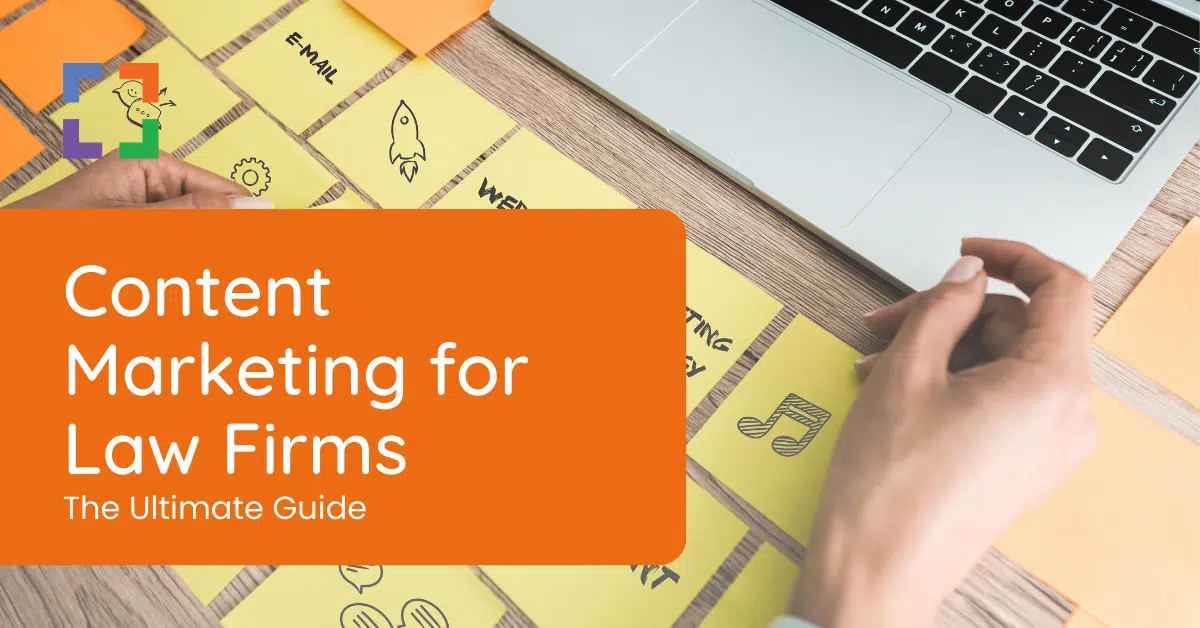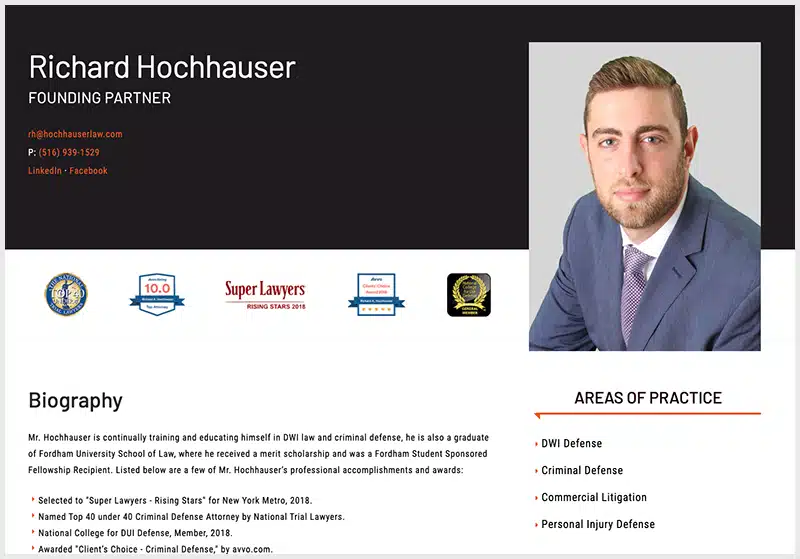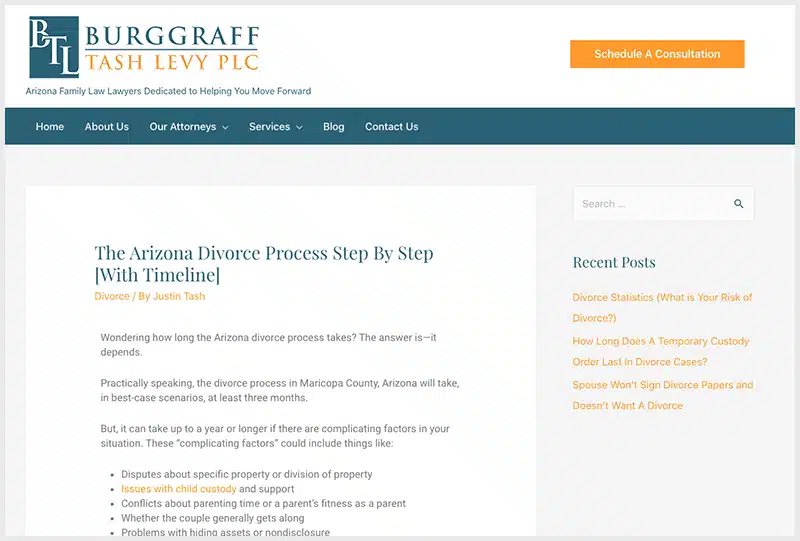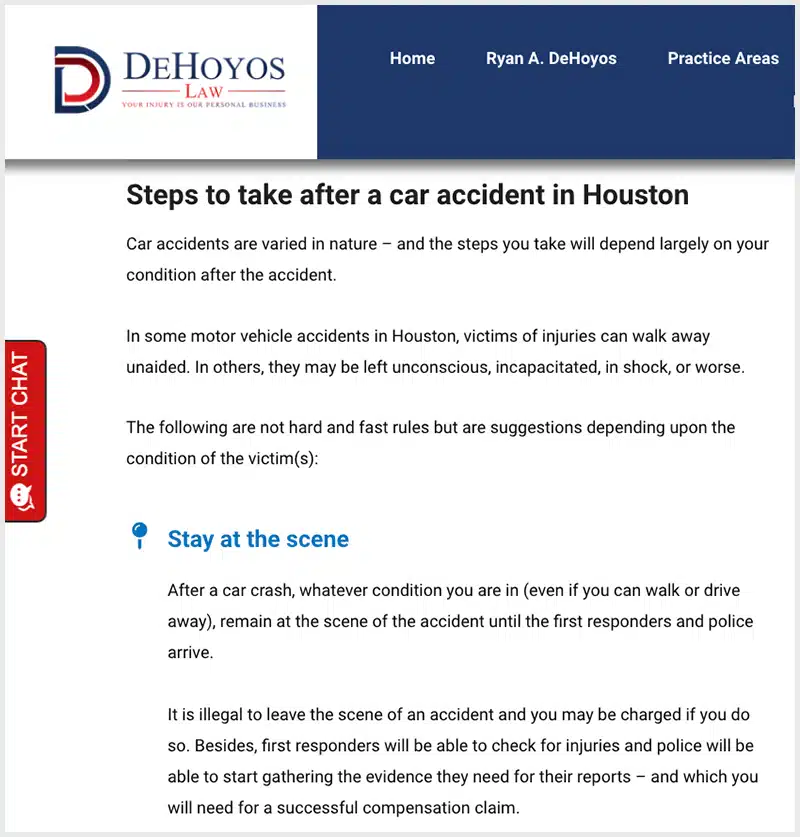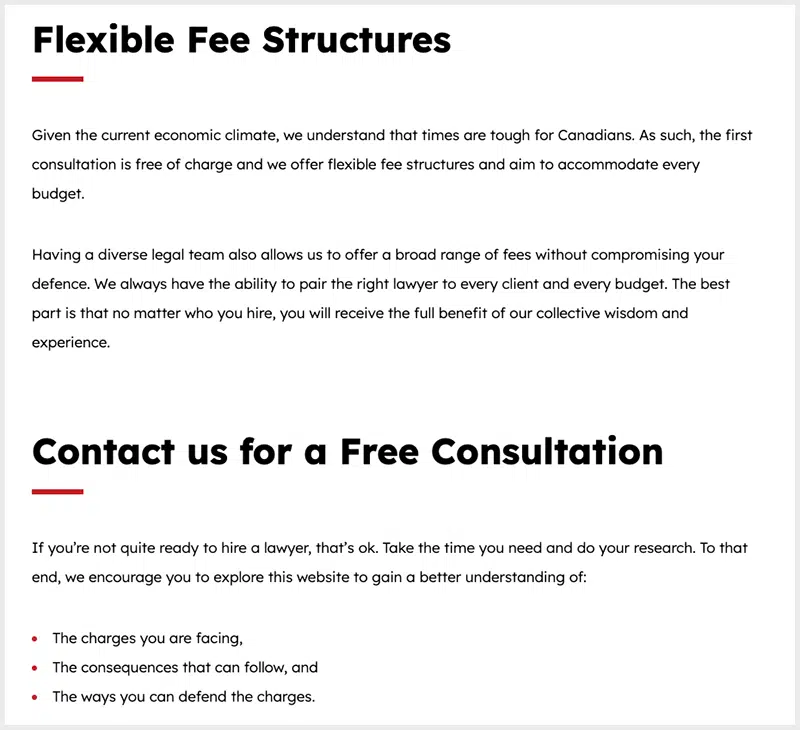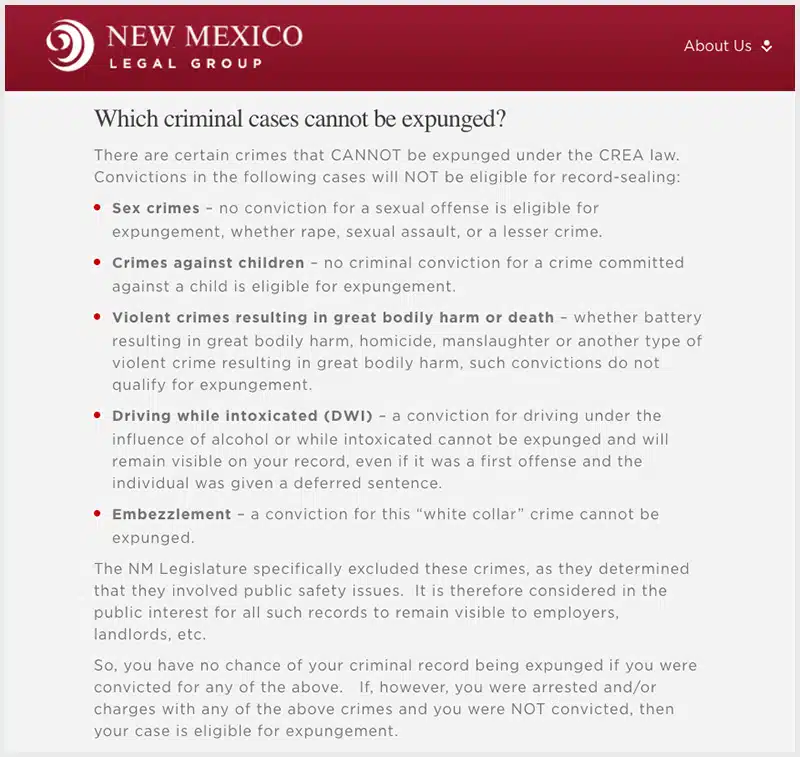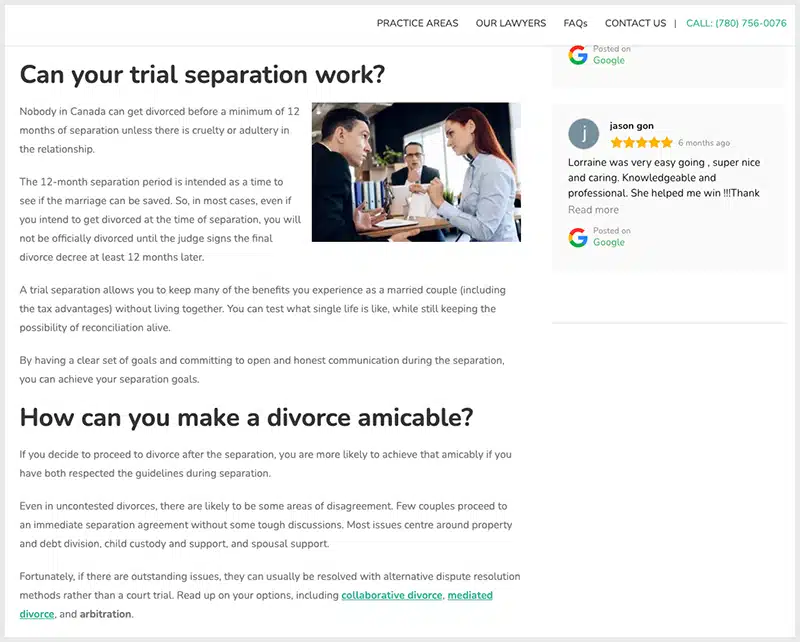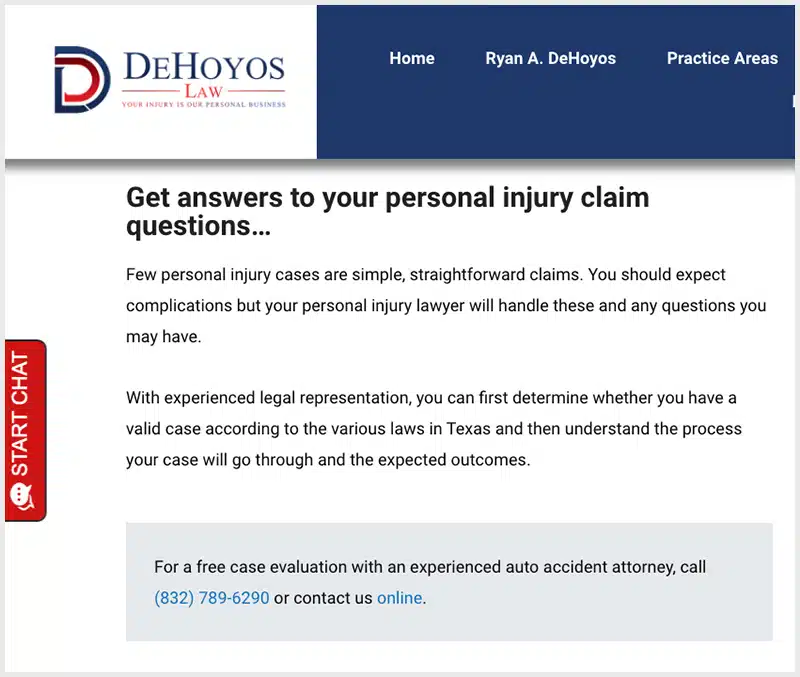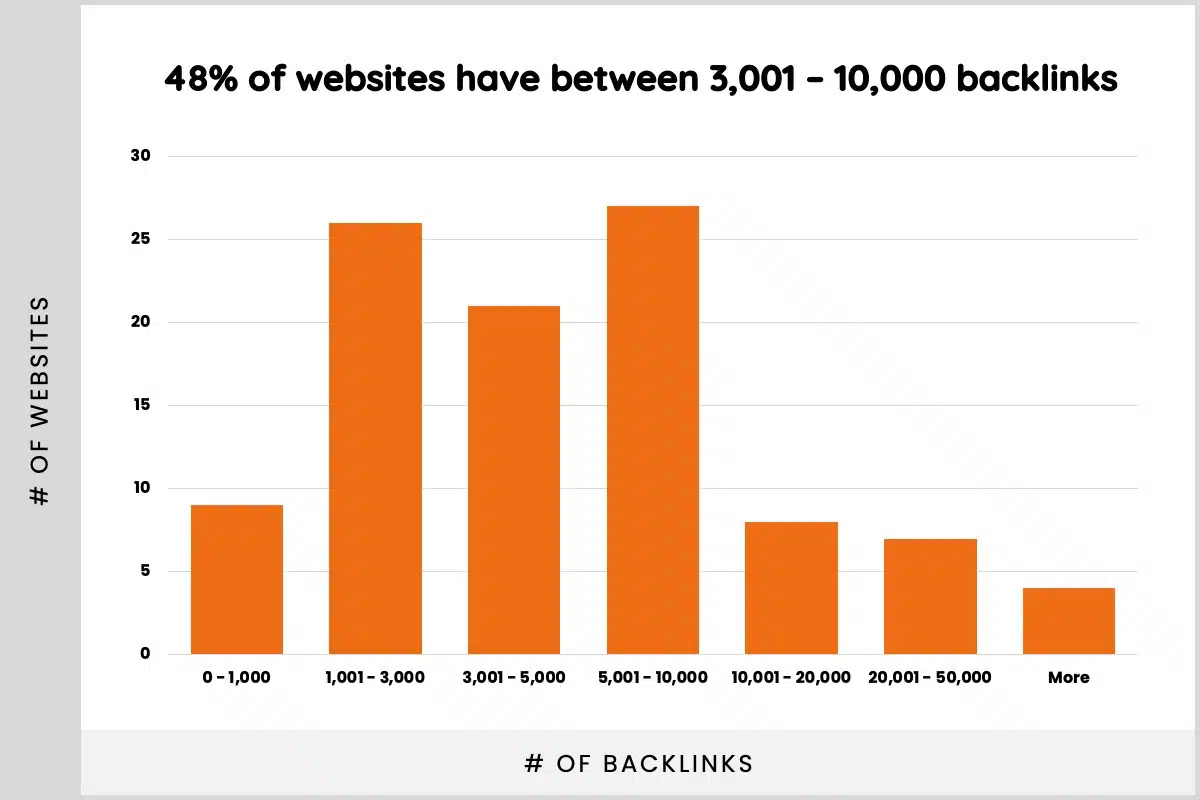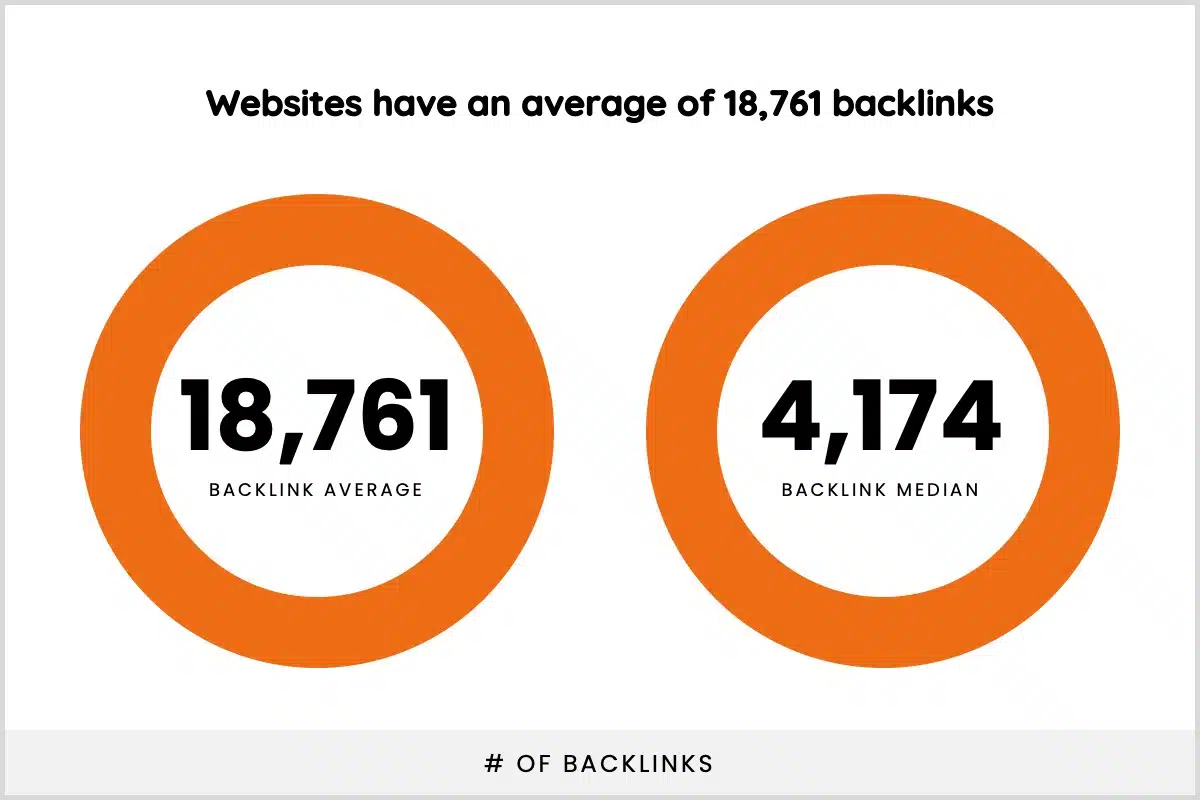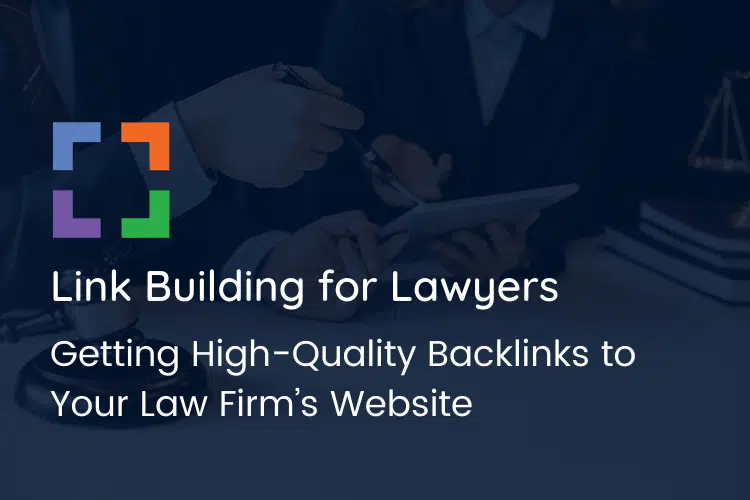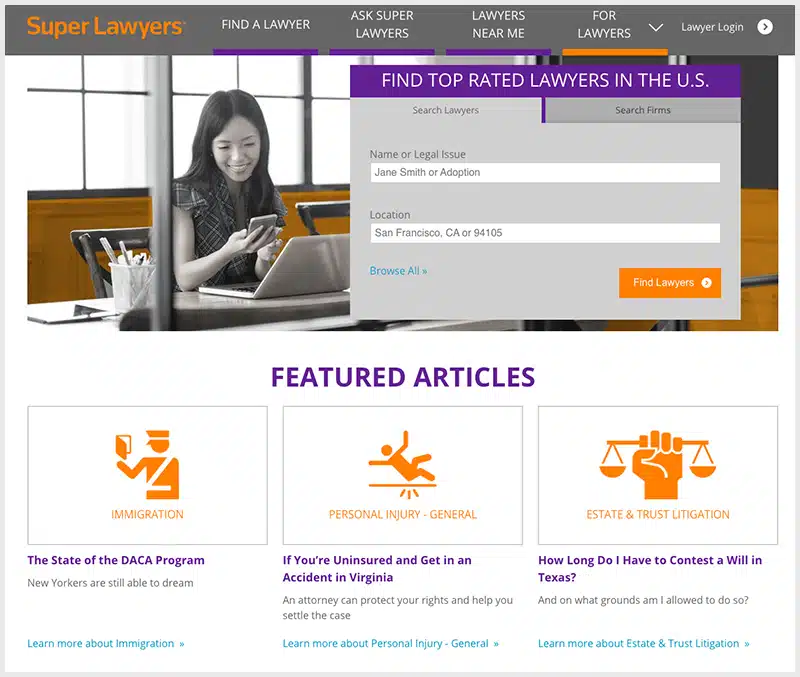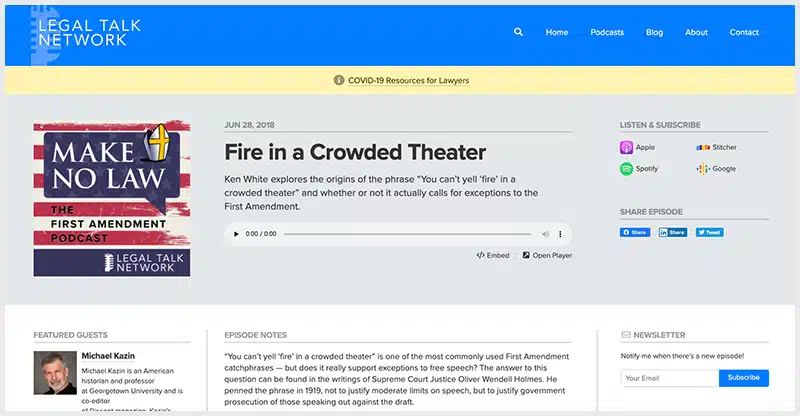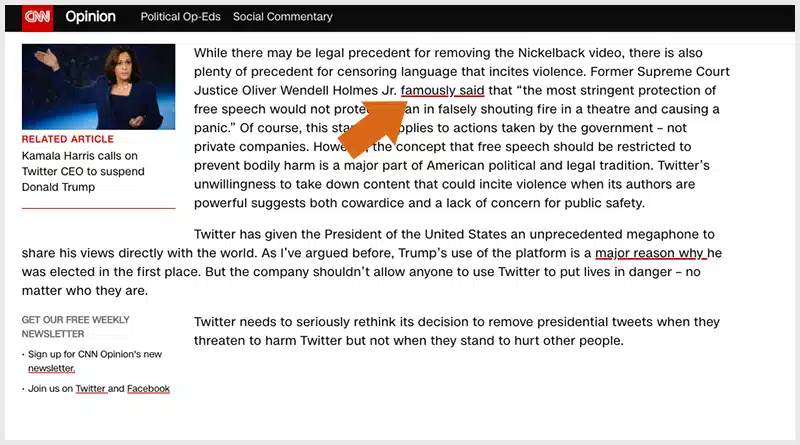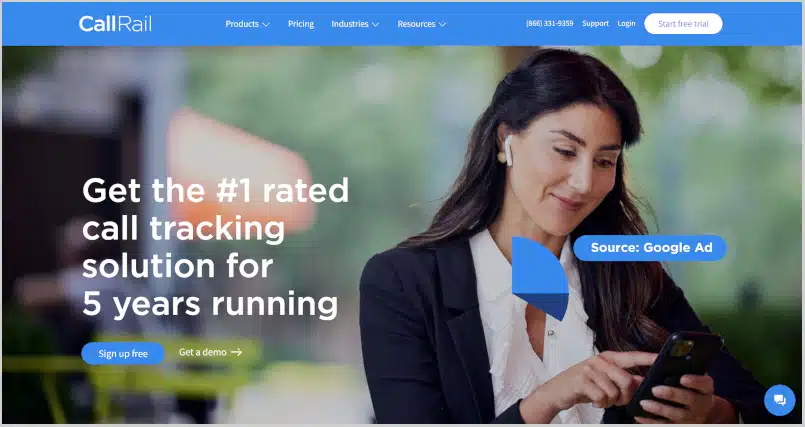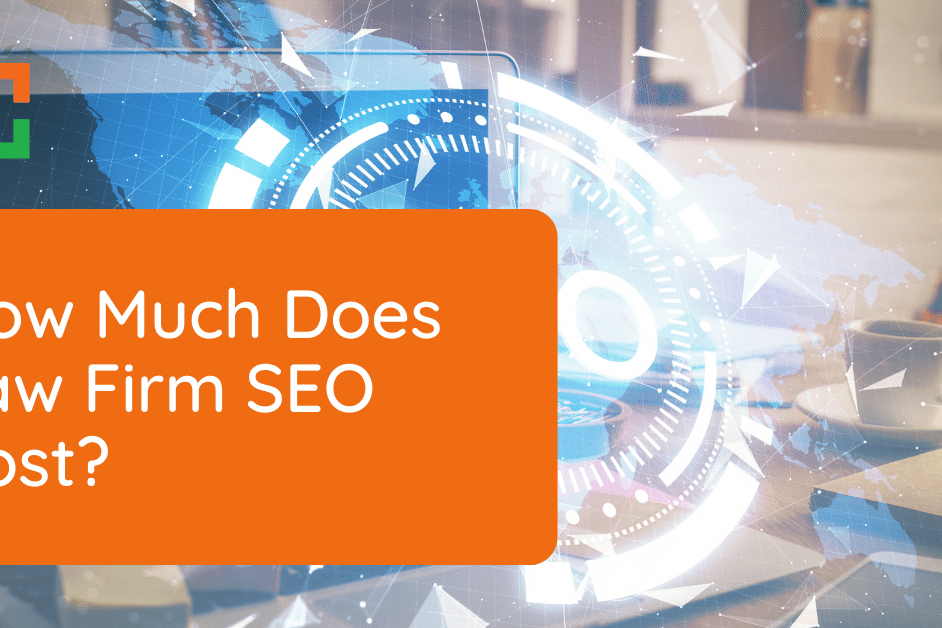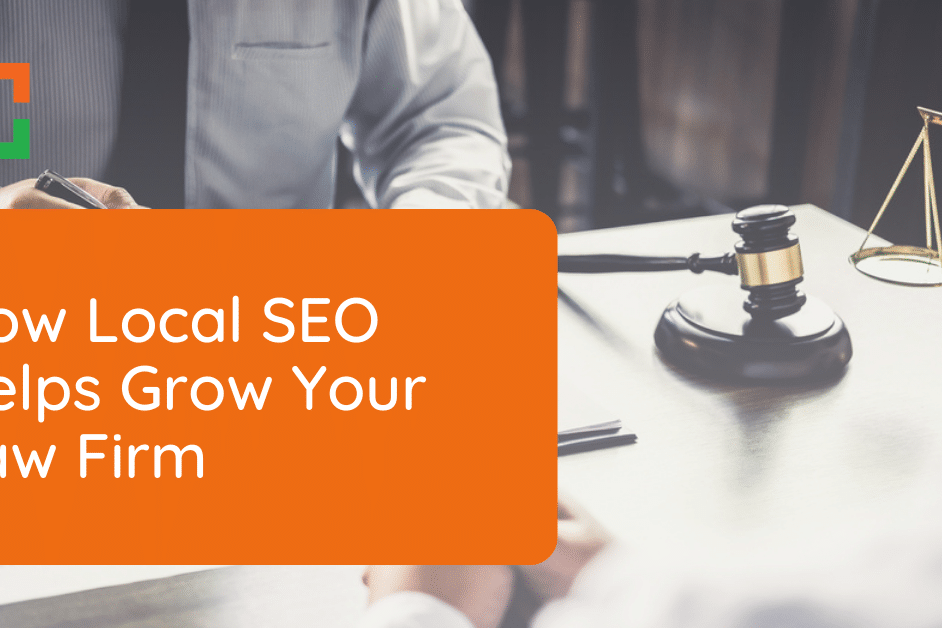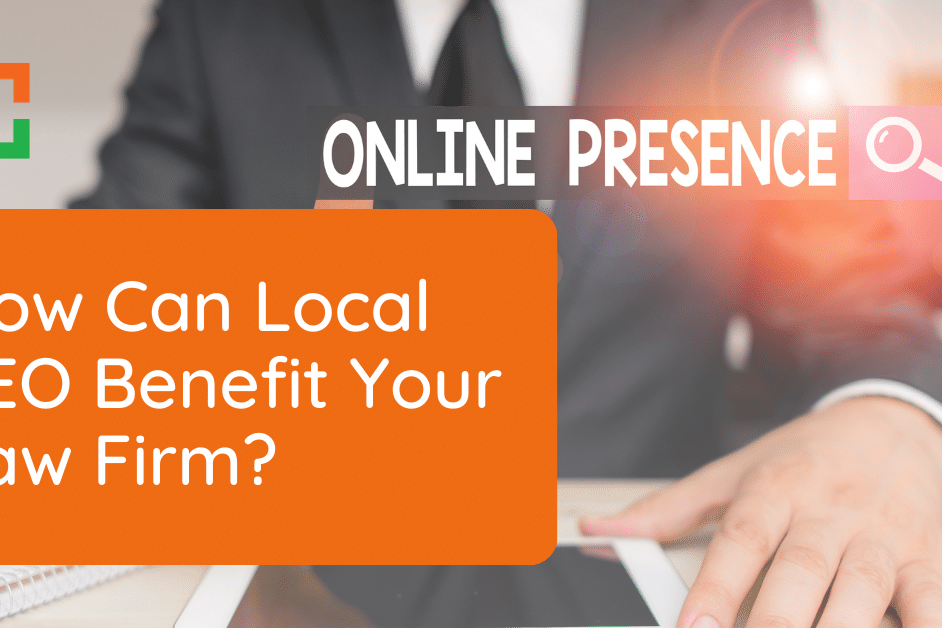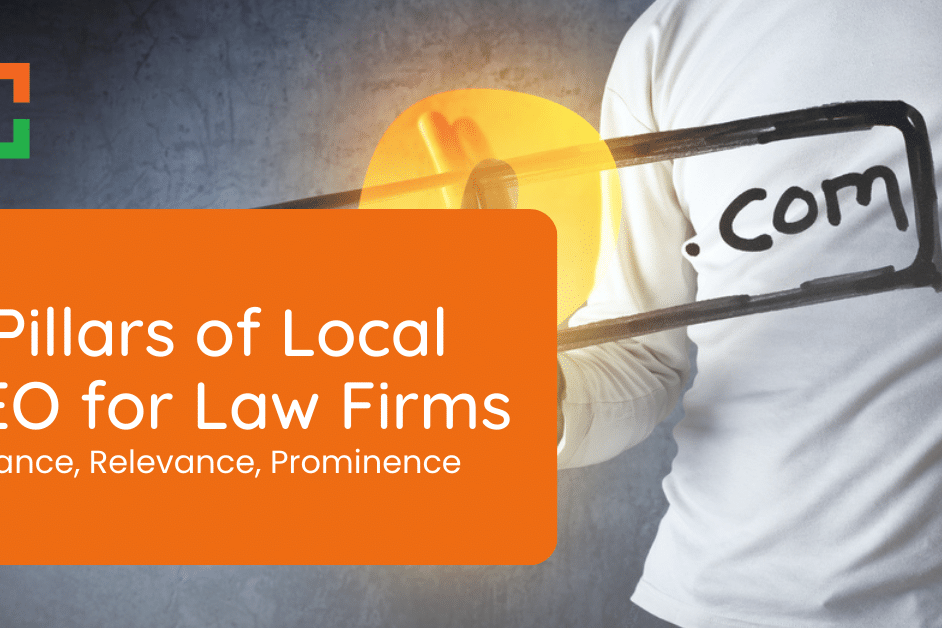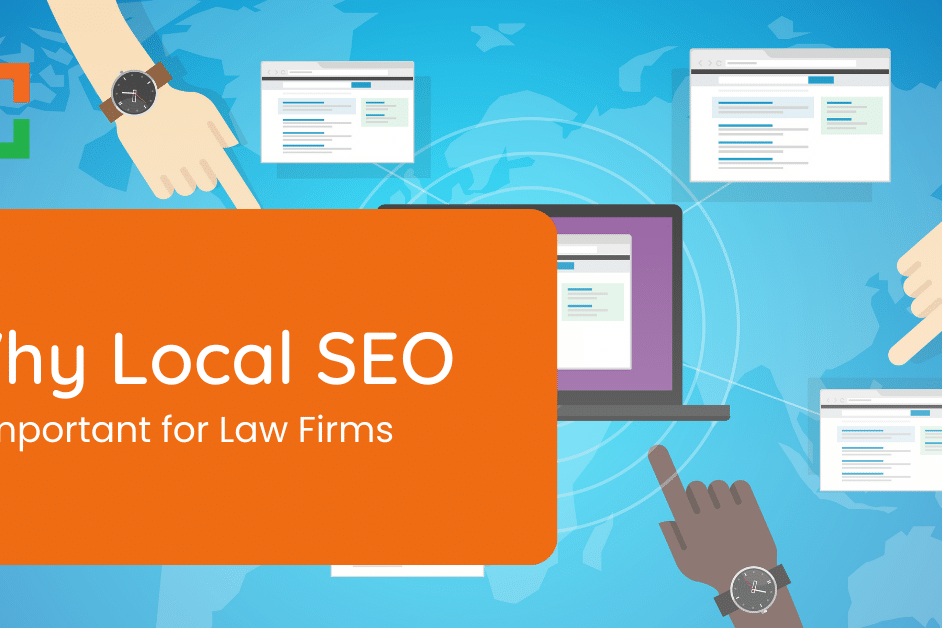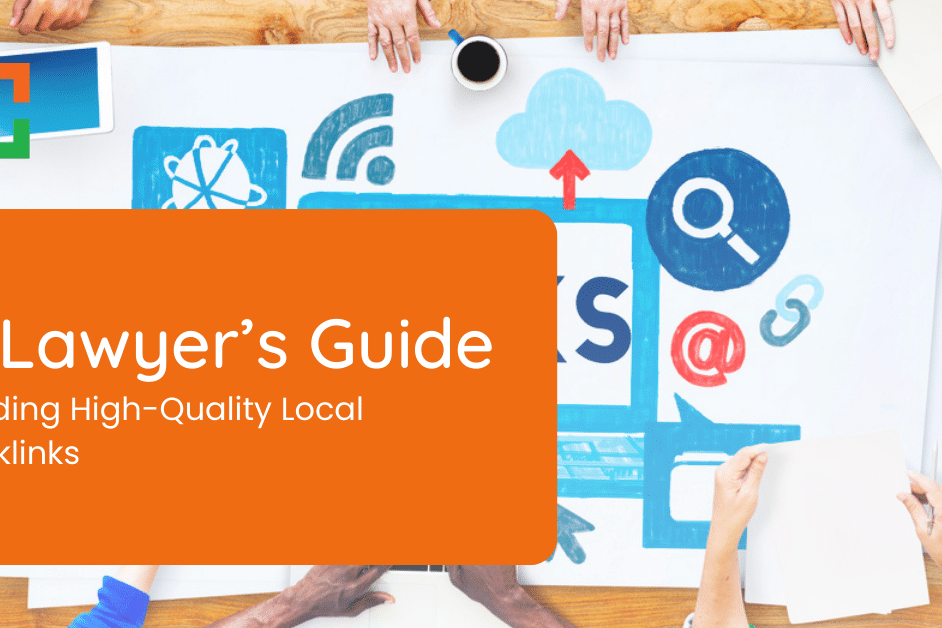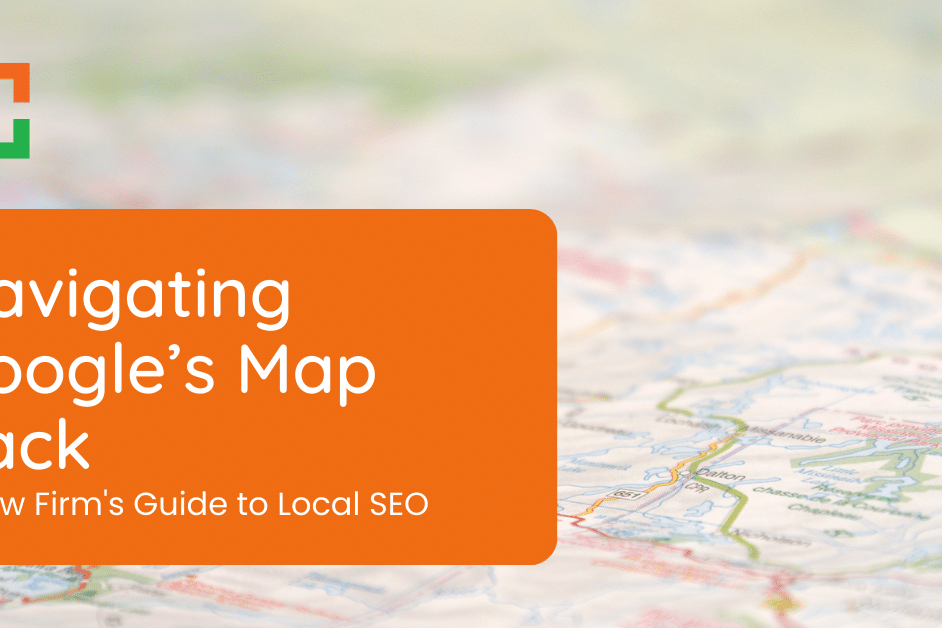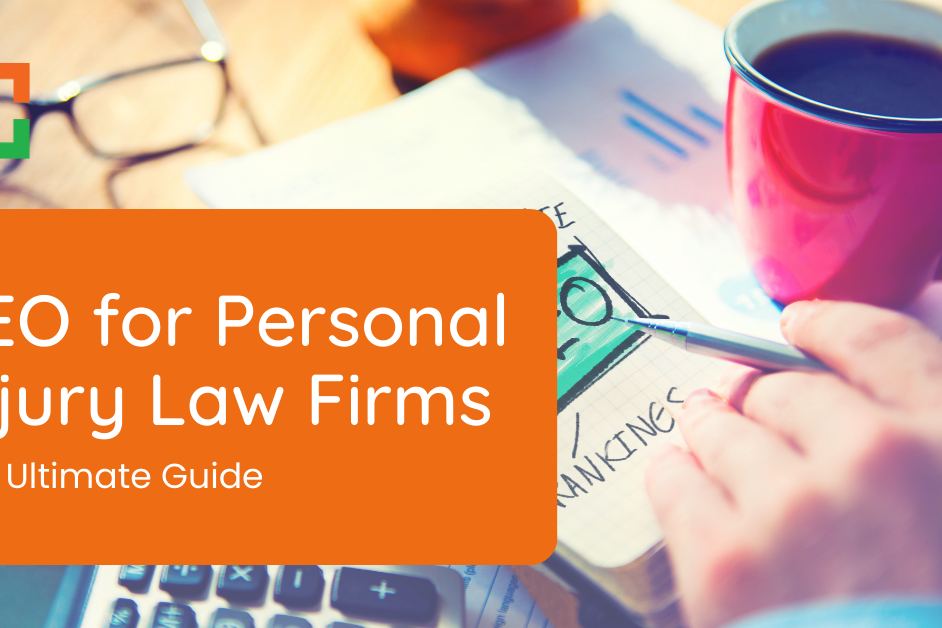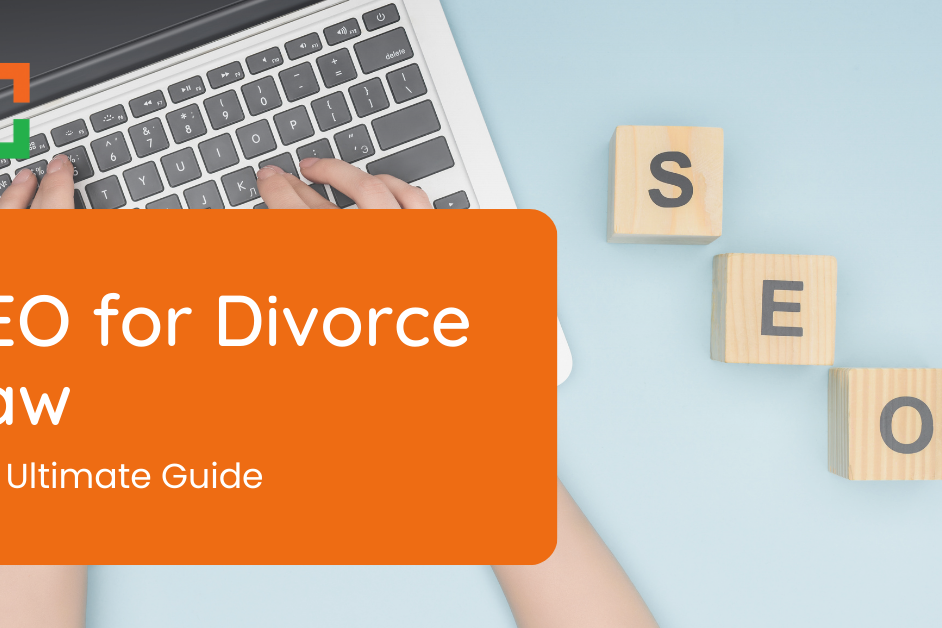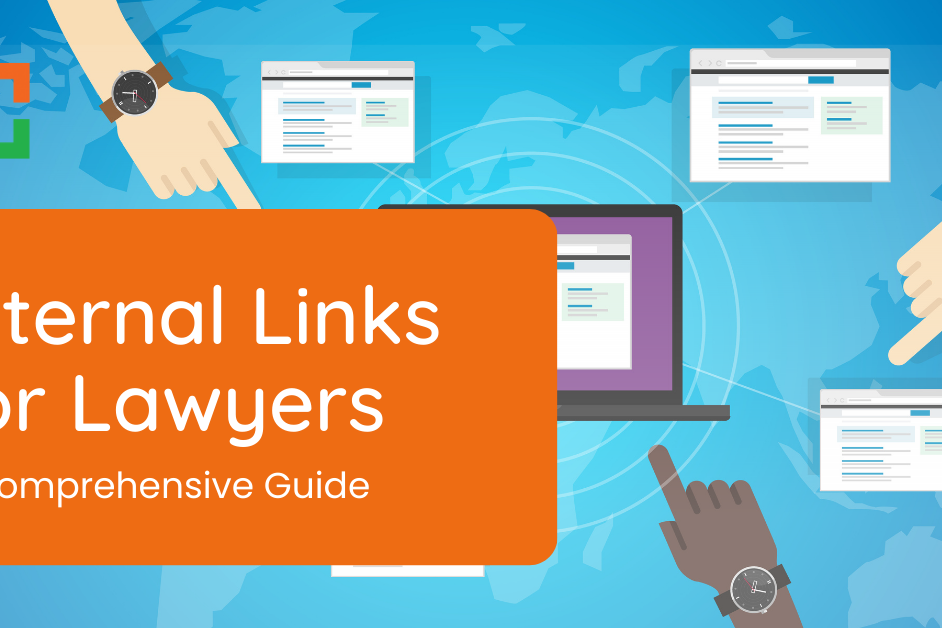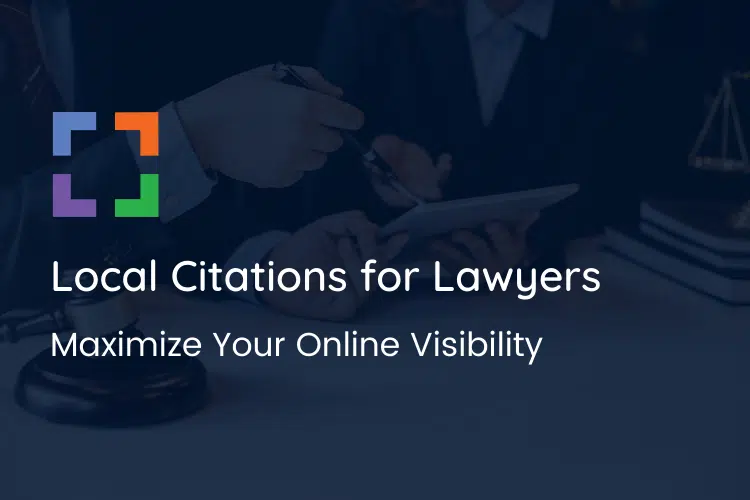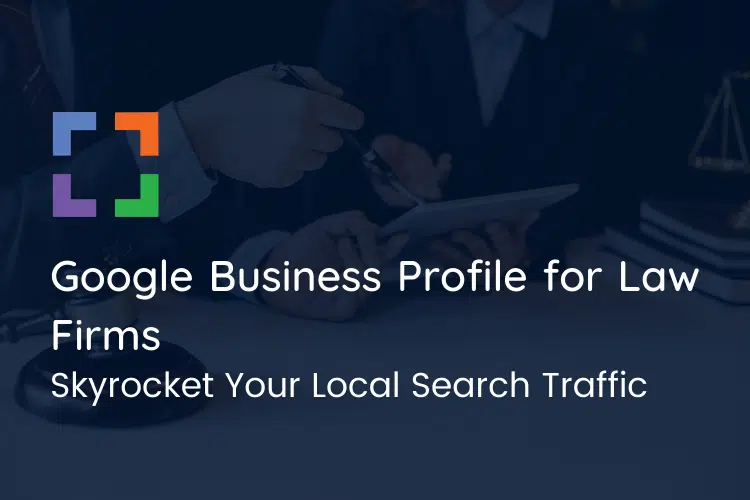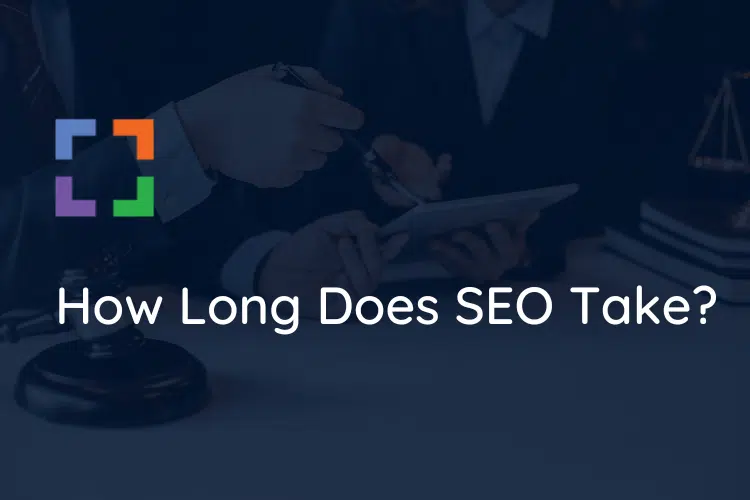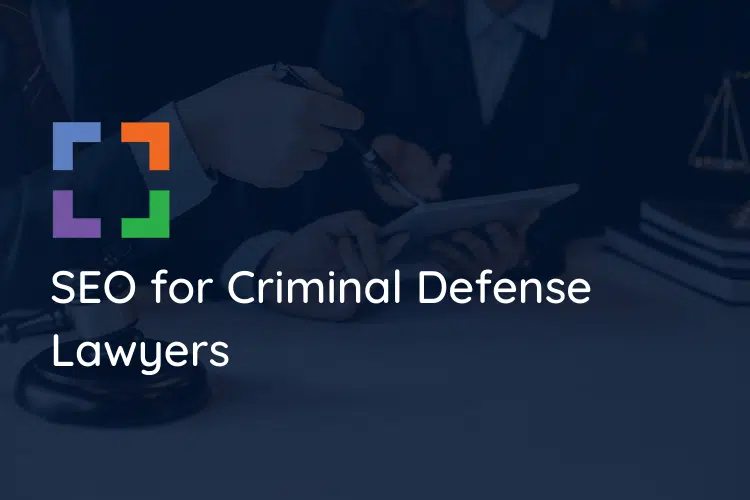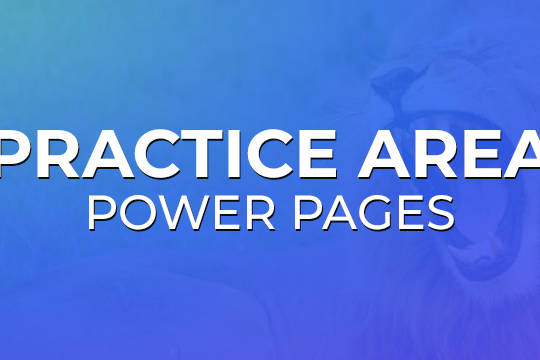SEO for Lawyers: A Beginner’s Guide (With 50+ Examples)
Are you interested in getting your firm to the #1 position in Google’s search results?
Of course you are. Who isn’t?
SEO for lawyers remains one of the most effective ways for law firms to attract quality clients.
Consider these legal stats:
- 96% of people seeking legal advice use a search engine.
- 74% of consumers visit a law firm’s website to take action.
- 62% of legal searches are non-branded (i.e., generic: Phoenix divorce attorney).
- 72% of people seeking legal advice only contact one attorney.
You don’t have to be a digital marketing expert to implement a law firm SEO strategy. Our guide is carefully crafted for beginners, giving you the information you need to know to get to the top of Google (without the fluff).
Let’s begin.
Is there a law firm SEO tactic you think we missed? Have any tips of your own you’d like to share? What’s worked for your law firm’s website? Reach out and let us know.
In This Article
- Chapter 1: Introduction to Lawyer SEO
- Chapter 2: Lawyer SEO Ranking Factors
- Chapter 3: Keyword Research for Lawyers
- Chapter 4: Content Marketing for Lawyers
- Chapter 5: Onsite and Offsite Optimization for Lawyers
- Chapter 6: Local SEO for Lawyers
- Chapter 7: Lawyer Link Building
- Chapter 8: Performance Metrics and KPIs
Get More Traffic & Leads
Talk to a marketing expert

“My website continues to dominate all the top website searches in my industry and my business has grown 10 fold as a result.”
Micheal Oykhman
Oykhman Criminal Defence
Chapter 1:
Introduction to Lawyer SEO
What is Law Firm SEO?
Law firm SEO (Search Engine Optimization) is the process of improving the visibility of your law firm’s website on search engines like Google. A successful SEO campaign will see you ranking highly on Google, increasing the quality and quantity of traffic to your website.
As a marketing tactic, SEO for lawyers requires in-depth keyword research, onsite optimization, link building, citation building, Google Business Profile optimization, content marketing, and analytics configuration.
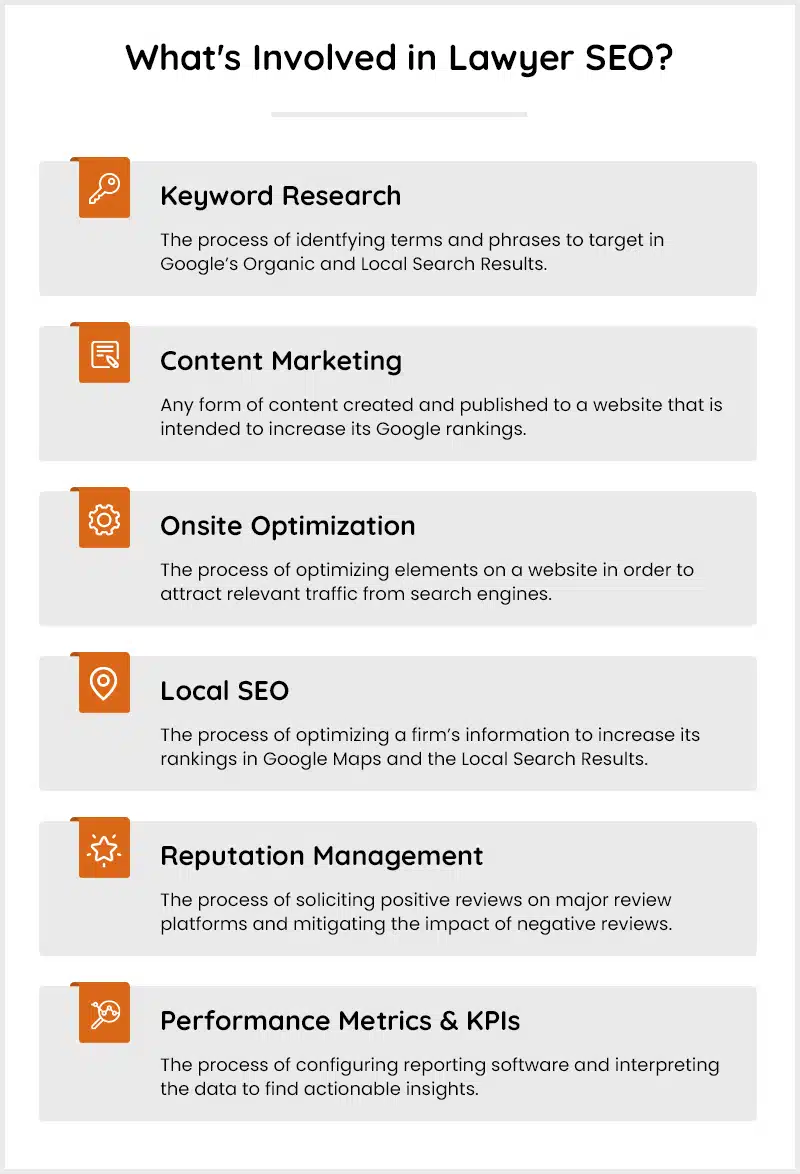
All of those items feed into one thing — making your law firm’s website the most relevant and high-quality resource for your practice area. The more boxes you check, the more likely you’ll meet Google’s criteria.
Here’s a quote from Google itself on the purpose of its search engine.
Search engines exist to help people find what they are looking for. To do that, search engines must provide a diverse set of helpful, high-quality search results presented in the most helpful order.
When done right, SEO outperforms other channels that prospective clients use to find a lawyer, including social media and word-of-mouth.
Our client, Trey Porter Law, experienced an 827% increase in website traffic with a well-optimized SEO campaign. He ranks highly for several competitive, local keywords that get him tons of monthly leads.
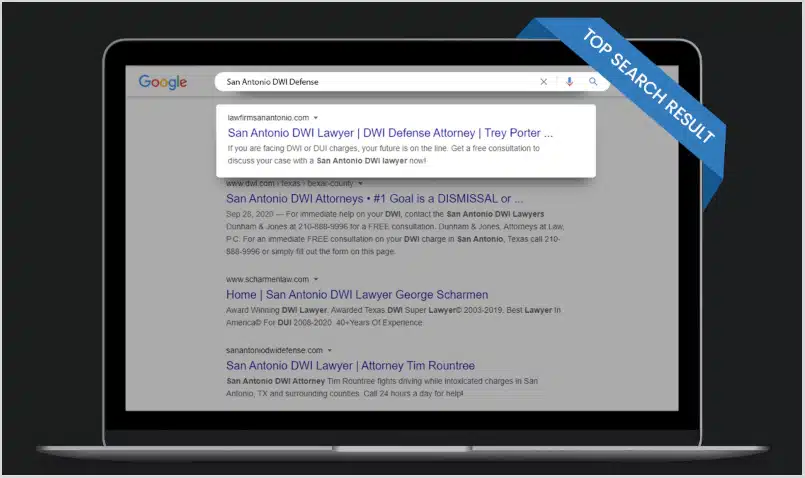
We tell all of our clients that SEO is a long-term investment. It’s the only channel that nets you compounding returns over time. It might start slow, but you’ll experience steady growth.
Why is Law Firm SEO So Important?
When we want to find a new service in our area, most people don’t think about things like YellowPages. They head straight to a search engine.
In fact, one study found that up to 96% of people looking for legal advice go to a search engine.
That won’t come as a surprise to most people. The majority of people use Google to answer questions and queries, research products and services, and even rely on it for legal and medical advice.
If the goal is to become more visible online and attract prospective clients to your website, you need to focus on SEO.
The potential for growth is like no other marketing channel. Google processes 8.5 billion searches a day.
When we look at our clients’ websites, we see that, on average, 80%+ of all traffic comes from organic searches.
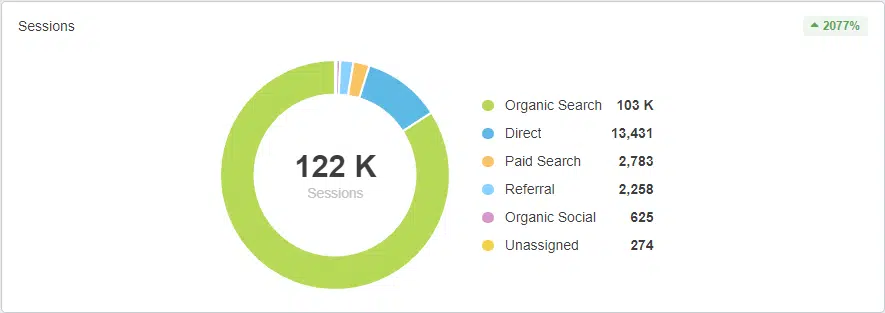
So, you know you want to be present on Google. But it’s not enough to sit on the second page.
Only 0.63% of Google searchers will click a link on the second page, while the #1 result in Google’s organic search has an average CTR of 27.6%.
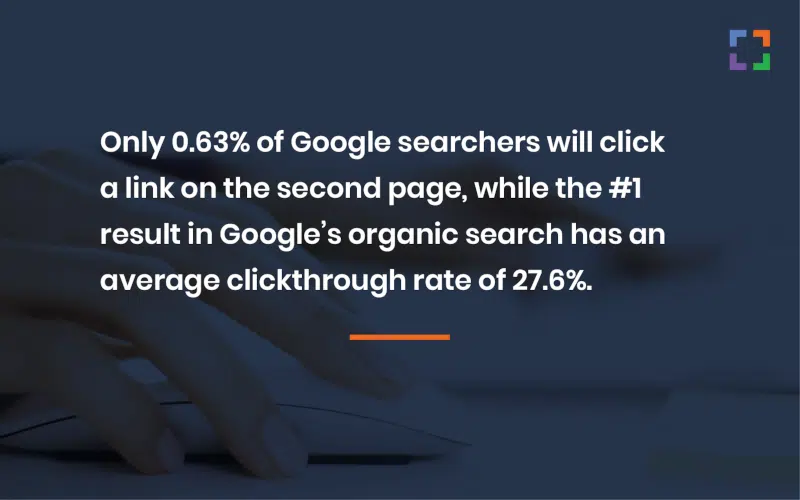
Your placement on Google’s SERP (search engine result page) affects how many visitors you get to your law firm’s website. The more website visitors you get, the more paying clients you get.
And because most people only hire one lawyer, placing higher on the SERP is even more crucial for law firms
How high?
As high as you can go. Settling for the bottom of the first page won’t get you the results you expect. The #1 result in Google’s organic search is 10x more likely to get a click than the tenth result.
And the top 3 results get 54.4% of all clicks, with the majority going to the #1 spot.
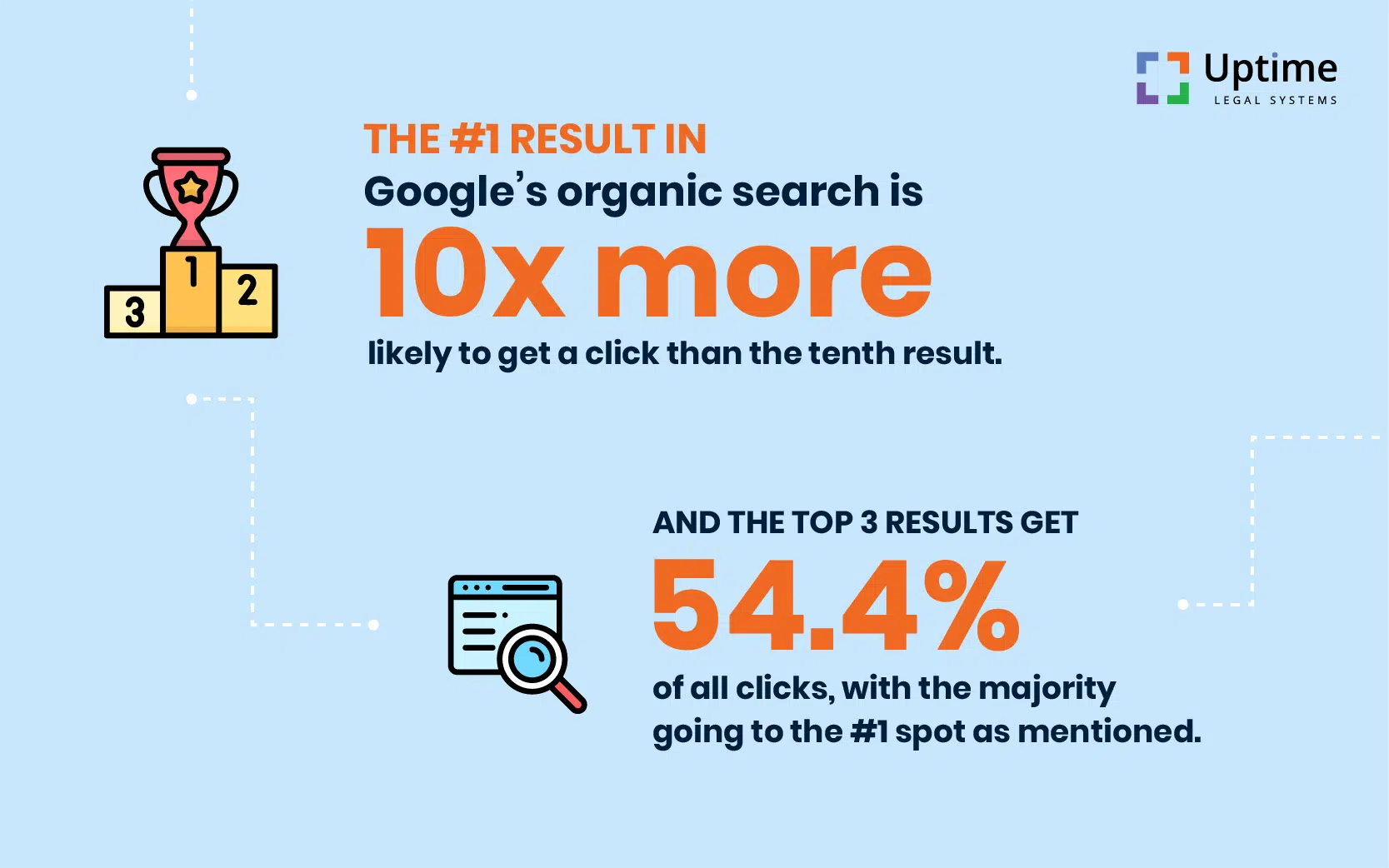
Out of all the marketing channels out there, law firm SEO costs the less and produces the highest return on investment. And it’s showing no signs of slowing down.
But it will only get more important as time goes on to rank highly on the SERP.
If your law firm’s website can’t be found on search engines, you’ll have to rely solely on referrals. While word-of-mouth is powerful, SEO is much more sustainable and is in your control.
Have Questions about Marketing with JurisPage?
Request a Free Consultation!
Chapter 2:
Lawyer SEO Ranking Factors
What are Google Ranking Factors?
For years, the basic principle of SEO marketing has remained the same:
Google wants to return the most accurate, credible, and authoritative information to its users.
Google fiercely defends its search results and updates its algorithms regularly for greater accuracy. They assess each website for a large variety of factors called the Google Ranking Factors (of which there are over 200).
At JurisPage, we believe the following factors most impact a website’s search engine rankings in Google’s search results.
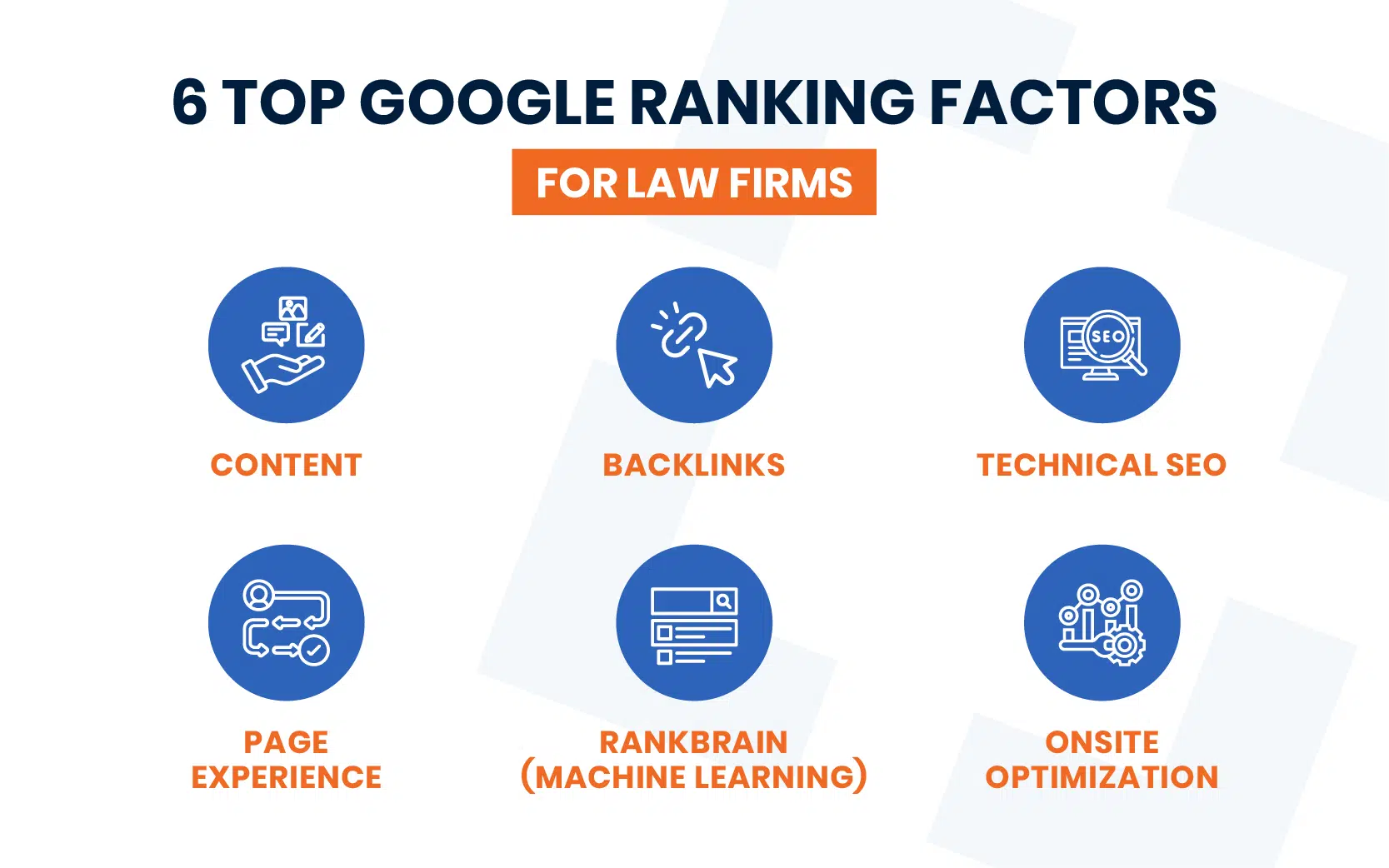
That’s really the core of what law firm SEO is about. If you pay special attention to these ranking factors, you’ll inevitably rank higher for those valuable keywords and draw in more traffic.
We’ll dive into the ranking factors we think are worth understanding more in-depth below.
Key Ranking Factor #1: Content
Content refers to any written or video content optimized and published on a firm’s website.
Writing original, informative content is the cornerstone of law firm digital marketing — and optimized content is a key ranking factor.
Related – Law Firm Marketing Strategy: 23 Tactics: A list of the 23 best law firm marketing tactics.
It must be topically relevant, optimized for keywords, informative, and easy to read and share.
In addition, all content is ranked on its:
- Quality
- Uniqueness
- Freshness
- Search intent match/keyword usage
We’ll go into more detail on these factors below.
But first, what type of content should you publish?
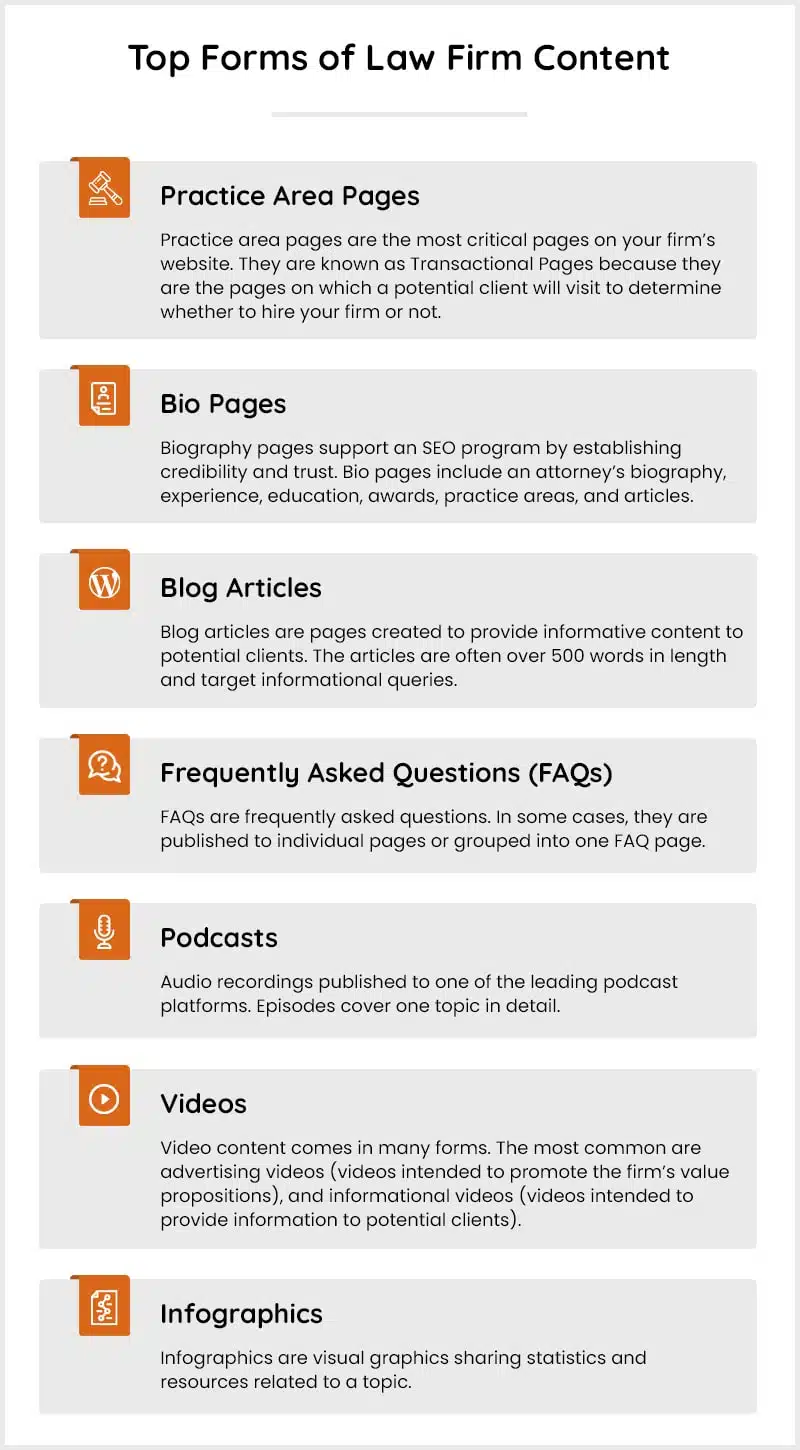
Content creation, be it articles, videos, or podcasts, is one of the most effective marketing techniques for a firm to invest in.
By consistently publishing valuable content, you create the perception of being a subject matter expert. It increases your website and social media traffic, ultimately contributing to more quality sales leads and prospects.
Quality, Uniqueness, and Freshness
As we’ve mentioned, Google’s aim is to rank the highest quality content that exists. To do that, they evaluate content quality, uniqueness, and freshness.
Quality is self-explanatory.
The best content on a subject is:
- Thorough: It completely answers someone’s search query.
- Useful: It satisfies what a user expects to see.
- Structured: It’s easy for users to find the answers they want.
At that point, your content should be the most comprehensive and well-structured piece on the internet. But is it unique?
It’s not enough to regurgitate all of the same information that your competitors are putting out there.
Your content needs to be different or better than what’s already ranking for the keyword you’re going after.
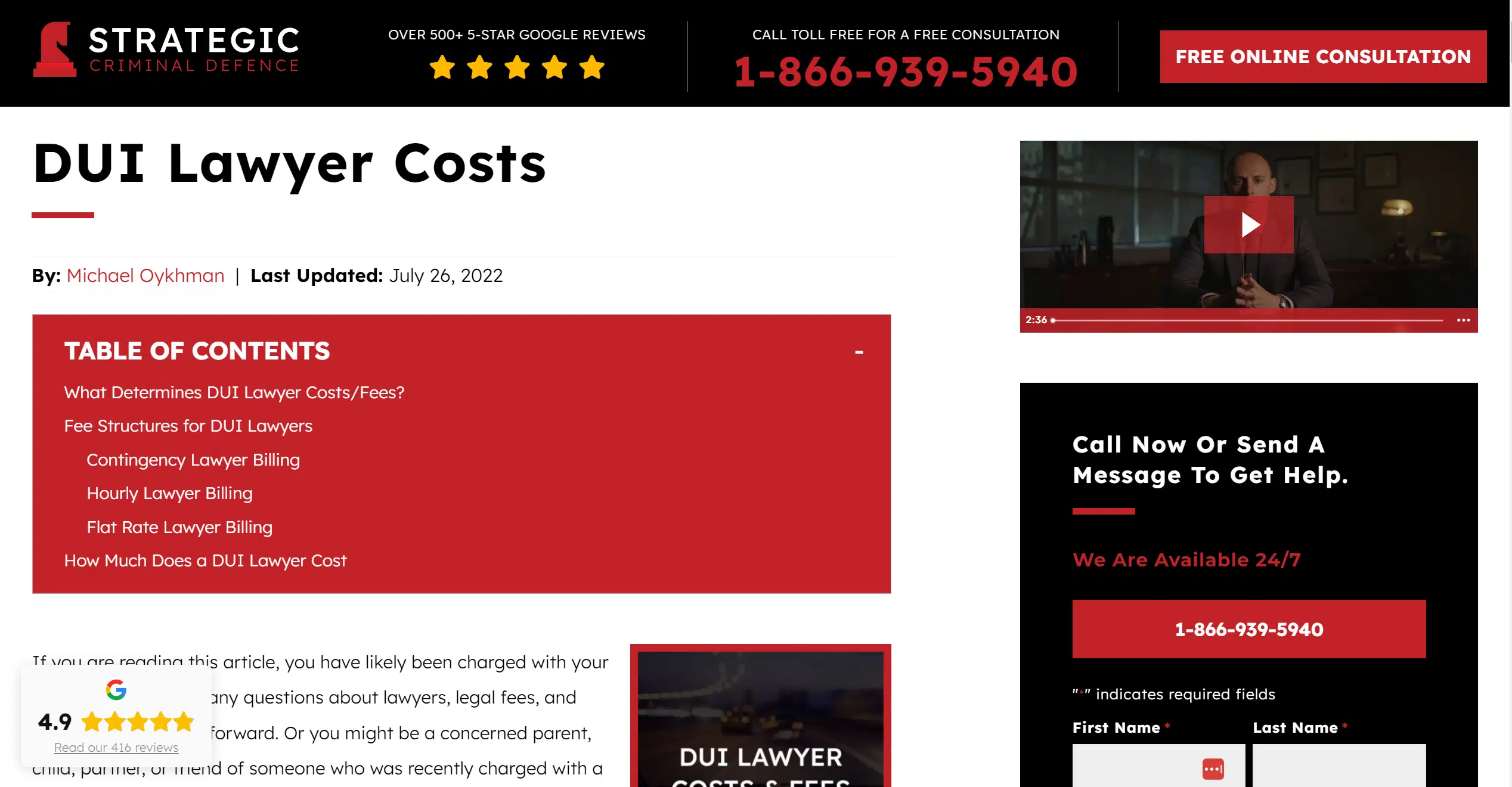
The above example showcases a blog with a table of contents, which is something that not all blogs include but goes wonders in improving usability.
Google also cares about freshness — that’s why new content generally gets an (albeit temporary) rankings boost.
The key here is to regularly update your content so that it’s up to date.
Most content needs to be updated at least once a year.
Using Keywords and Matching Search Intent
Many people fall into the trap of only writing for Google — that is, stuffing in keywords at the expense of user experience.
The truth is great content is written for people first, then optimized for search engines. High-quality content speaks to the reader first, then incorporates keywords and phrases naturally. (More on keyword research later.)
Just as important as keyword research is search intent. Make sure your content matches search intent — in other words, your content should answer the intention behind the search. What is the user’s goal when typing those keywords into Google?
There are four types of search intent:
- Commercial Investigation: Searching for products or services to compare and make informed decisions.
- Transactional: Searching with the intent to purchase or complete an online activity.
- Informational: Seeking knowledge or answers to questions.
- Navigational: Looking to access a specific website or webpage.
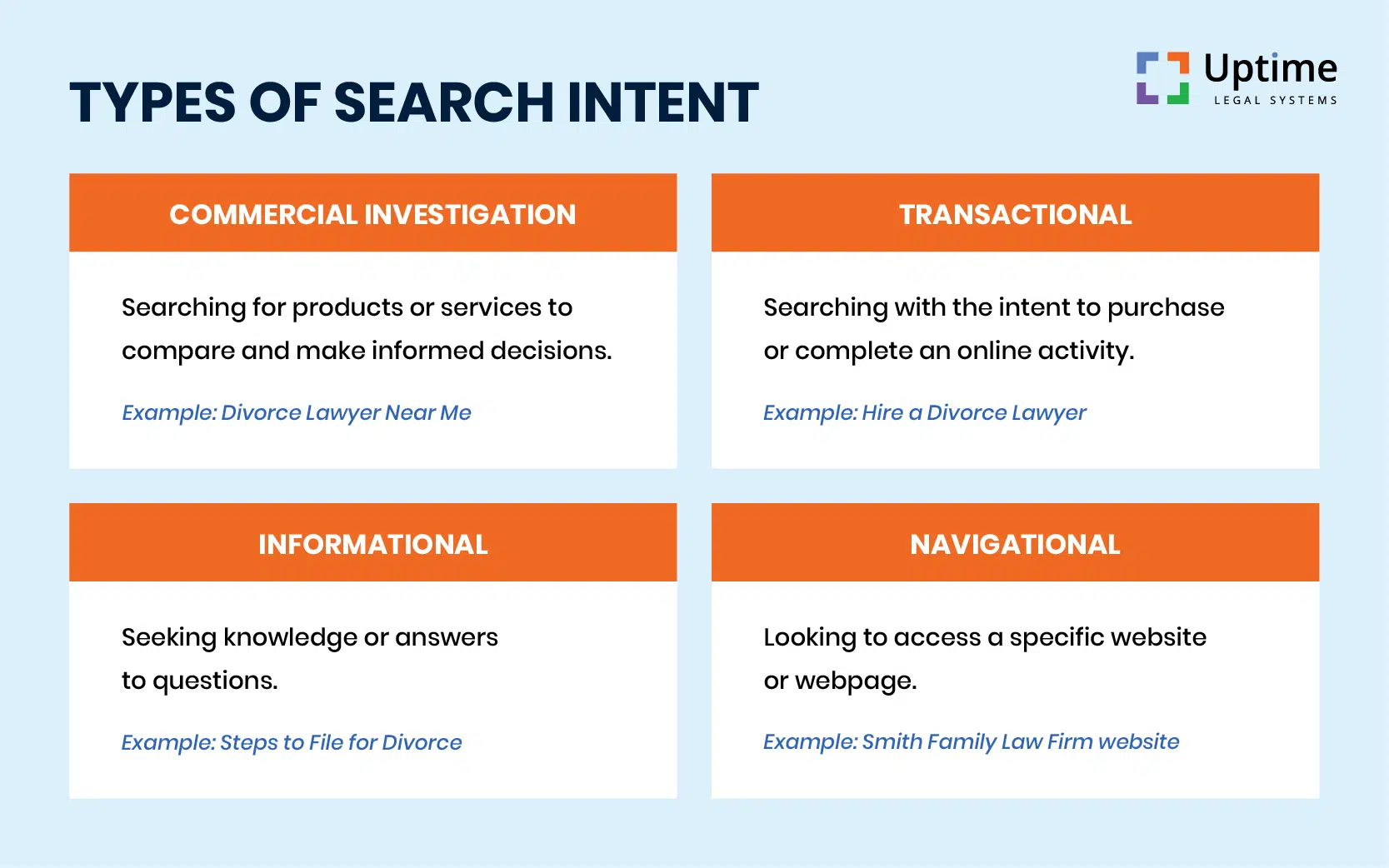
If you know the user’s search intent, you can carefully craft your content so that it specifically answers their query.
For example, someone searching for “file for divorce” could be looking to find information on filing for divorce or explore their options.
If you look at what types of results Google is already showing for that keyword, you can better understand what exactly searchers want and craft your content to address that.
In this case, a searcher is likely looking to hire a divorce attorney in Austin.
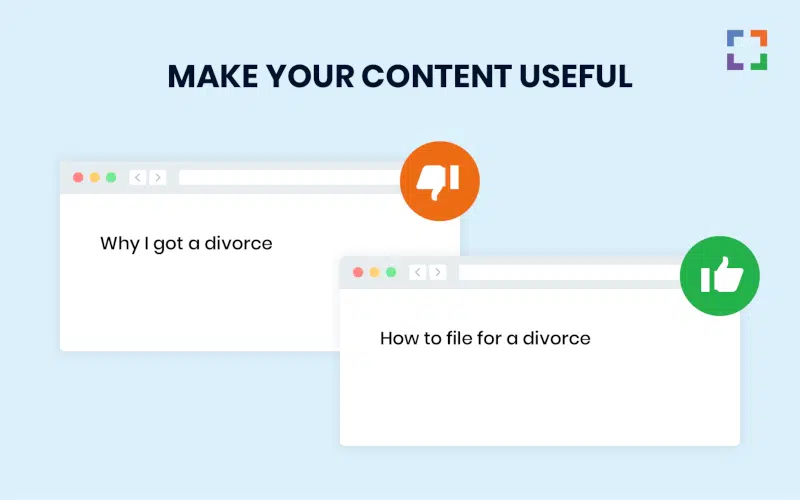
YMYL (Your Money Your Life) and E-E-A-T
Before we move on, we have to dive into YMYL and E-E-A-T.
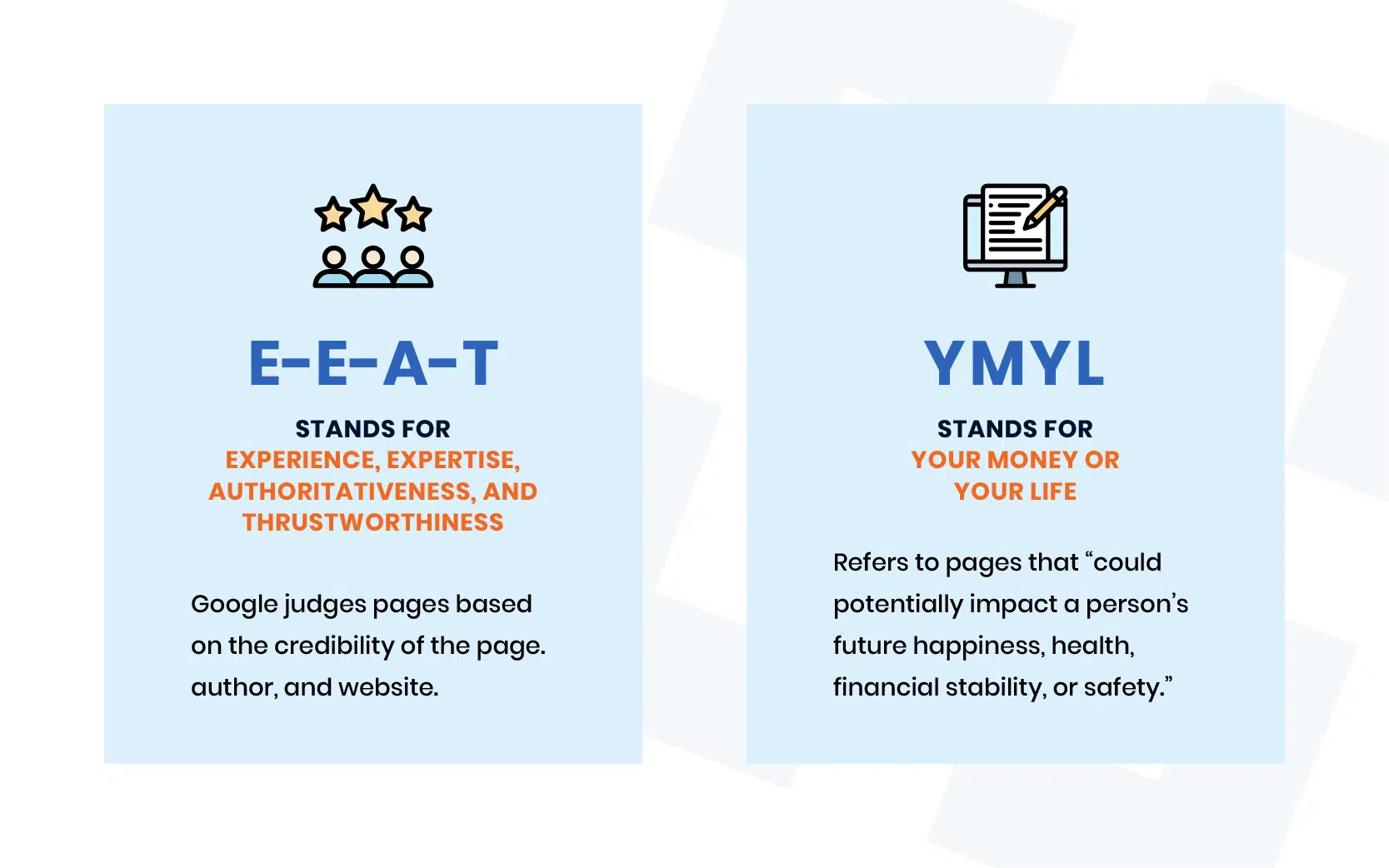
YMYL (Your Money Your Life) is a name given (by Google) to types of content that…
“could significantly impact the health, financial stability, or safety of people, or the welfare or well-being of society.”
Legal topics fall under this category. Someone searching for an attorney — or just looking for answers to common legal questions — could be in dire need. The answers they land on could significantly impact their welfare.
Google goes the extra mile to ensure YMYL content is accurate and delivered in the best possible way.
To do that, Google puts a greater emphasis on E-E-A-T for all YMYL topics.
Google evaluates a website’s E-E-A-T when deciding where to rank its content — that is, Experience, Expertise, Authority, and Trustworthiness.
- Experience: This involves knowing your practice area inside and out and leveraging your history in the legal space to deliver insightful and relevant content. It’s about using your past experiences to show off your credentials and qualifications.
- Expertise: This is about creating content that fits the user’s needs perfectly. It’s not just about the keywords they use but about the reason they turned to Google in the first place. How long users stay on your site and their engagement level gives Google clues about the quality of your content.
- Authority: This is the recognition of your expertise by others. It’s achieved when reputable websites link back to your page or your content is widely shared on social media.
- Trustworthiness: This involves avoiding any negative user feedback. Factors such as negative reviews, high bounce rates, an unsecured HTTP domain, or a subpar mobile experience can all decrease your trust score.
To sum it up, you can address YMYL and E-E-A-T by creating exceptional content answers and anticipates audience queries, builds valuable insights recognized by others, minimizes negative feedback, and draws on past experiences.
Key Ranking Factor #2: Backlinks
A backlink is formed when other websites link to your website. The more (and higher quality) backlinks you have to point to your website, the more trustworthy and authoritative Google will view your website.
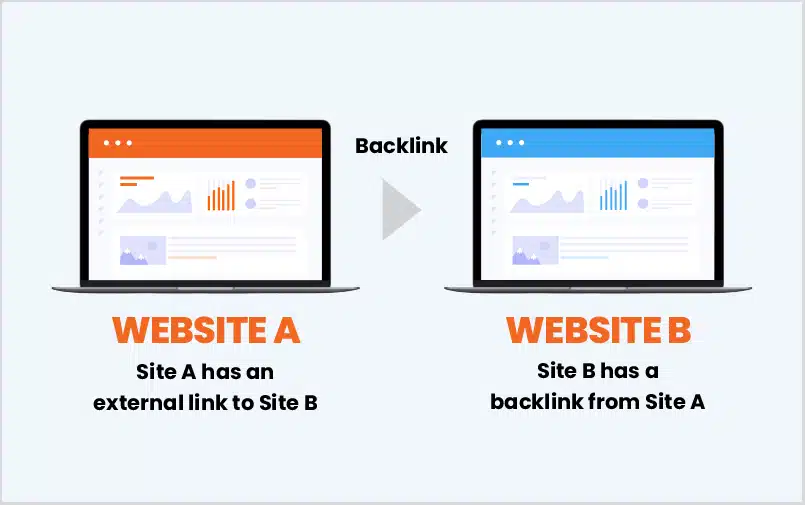
What does this mean for you? Think about all of the content that’s out there. Now consider how Google determines which of the thousands of blog posts covering the same topic should be on the first page.
While the impact of backlinks and how their value is calculated has evolved since Google’s introduction, links continue to play a leading role in determining a website’s position in Google’s search results.
Today, quality, relevance, and quantity matter. But what do each of these areas mean?
- Quality: Does the source website have a high Domain Authority? If so, it is deemed to be of higher quality than those with low Domain Authority.
- Relevance: Is the website related to your practice area? If not, the link may carry less weight than one from a highly related source.
- Quantity: How many quality, relevant links has your website received? The more links pointed to your website, the higher it will rank on Google.
Why does this matter?
Well, the more quality backlinks you have, the higher your Domain Authority (DA) will be.
Many people say DA is a dead metric, but it has a clear correlation with an increase in sessions.
Take a look at this image, depicting a client’s website shift from 0 DA to 1 DA.

Compare that with the graph below, showing the same website’s increase in website sessions. Notice the correlation between DA and sessions.

So you know you need authoritative backlinks, but where do you get links?
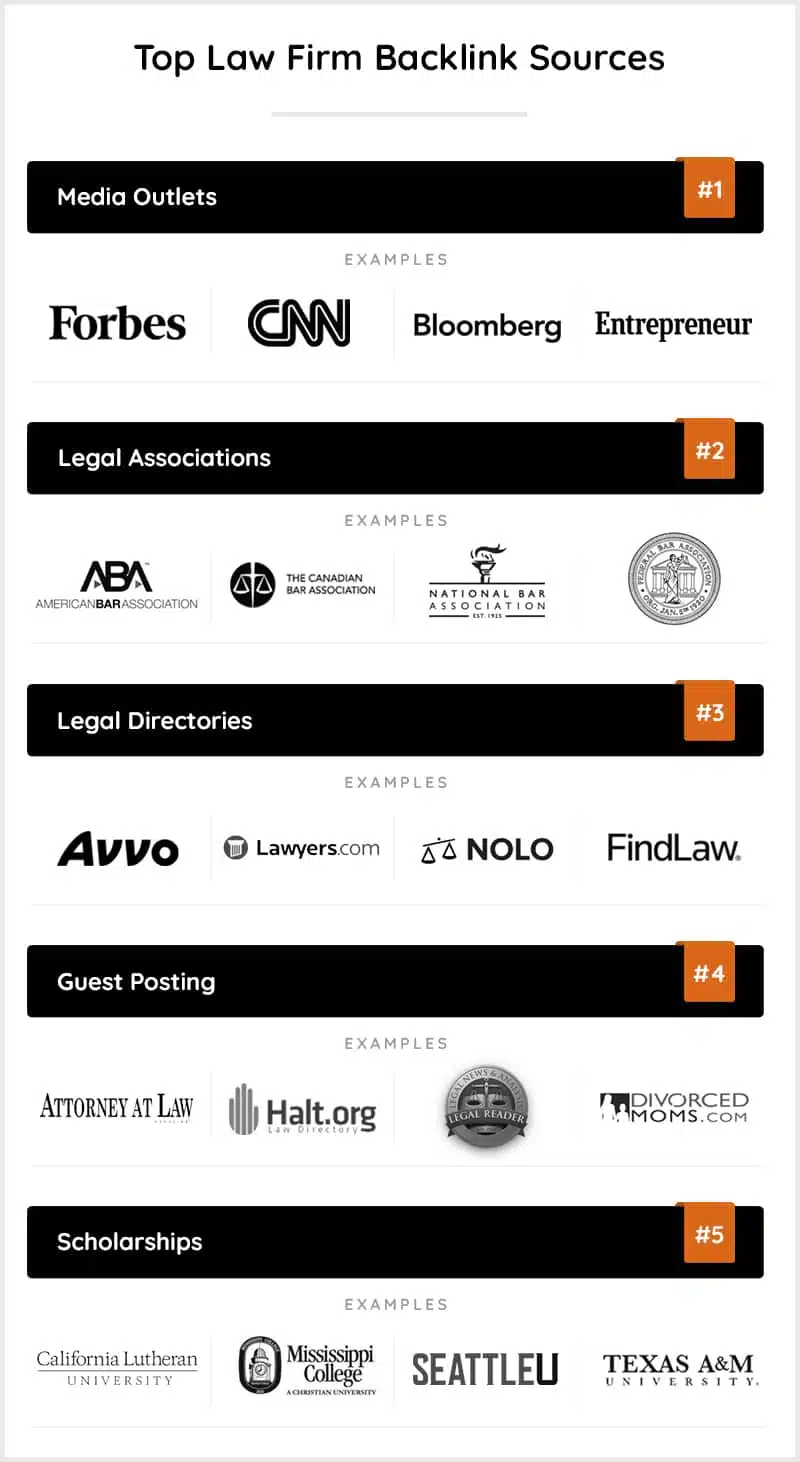
Some other ways to evaluate link quality include:
- The position of the link within the content
- The credibility and reputation of the website or page providing the link
- The number of outgoing links present on the external website
- The anchor text, which is the clickable text used to link back to your site, and the context in which it’s placed
- Links tagged as “do-follow,” which pass on SEO value, as opposed to “no-follow” links, which do not
We’ll touch on this in a bit more detail later on.
Key Ranking Factor #3: Technical SEO
We could get really into the weeds when discussing technical SEO, but it wouldn’t do you any good.
Instead, we’ll simply give you some easy-to-implement pointers.
- Use special headings and titles on each page to help search engines understand what your pages are about.
- Include descriptions for pictures so search engines and people with visual impairments know what they show.
- Add links to other pages inside and outside your website to help people find more information.
- Make sure your website loads quickly so people don’t get frustrated and leave.
- Make your website work well on computers, tablets, and phones so everyone can use it.
- Keep your website safe with an updated SSL certificate, shown by “HTTPS” and a padlock icon in the address, so people know it’s secure to visit.
Related – Best 101 Law Firm Websites: The 101 best law firm website designs.
Key Ranking Factor #4: Page Experience
Page experience involves evaluating factors like:
- Do pages have good Core Web Vitals?
- Are pages delivered in a secure fashion?
- Does content display well for mobile devices?
- Does the content contain an excessive amount of ads that distract from or interfere with the main content?
- How easily can visitors navigate to or locate the main content of your pages?
- Is the page designed so visitors can easily distinguish the main content from other content on your page?
Google announced previously that as of May 2021, certain factors related to page experience would be used in Google Search rankings.
This is what Google had to say:
“At Google Search, our mission is to help users find the most relevant and quality sites on the web. The goal with these updates is to highlight the best experiences and ensure that users can find the information they’re looking for.”
While content is king, page experience comes into play when evaluating multiple pages with similar content.
And Core Web Vitals is one important piece of the puzzle.
Here are the three main Core Web Vital factors to know about, plus a few extras.
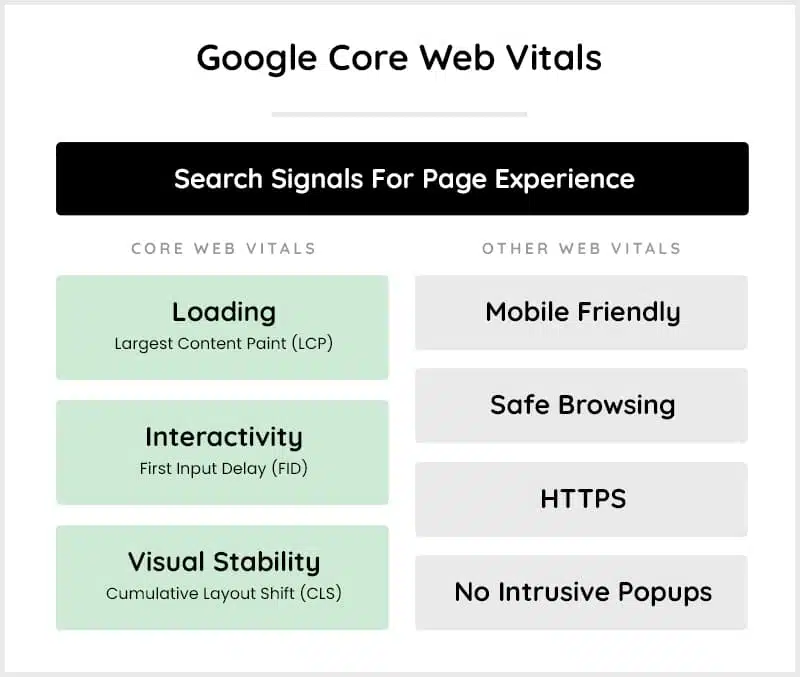
It can get a bit technical, but the main takeaway is this: if you prioritize user experience (UX), you’ll score well on Core Web Vitals.
User experience is the way people engage with your website and its content.
A well-designed UX guides visitors effortlessly through the process of finding what they need. When they arrive at your site, they can quickly locate the information they seek.
By directly tackling any concerns or problems, you prevent users from becoming frustrated and leaving your site too soon.
The better your UX is, the longer visitors stay on your website and the more likely they’ll contact you. It naturally improves your dwell time and reduces your bounce rate, two easy-to-track parts of Page Experience.
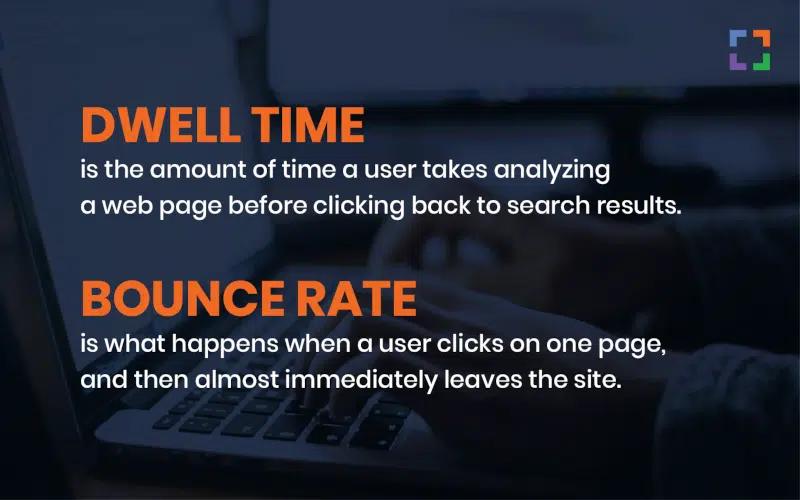
The last thing we want to mention as it relates to Page Experience is mobile-friendliness.
Did you know that 63% of organic search traffic in the U.S. comes from mobile devices?
That’s a huge majority — and that’s what’s prompted Google to switch to mobile-first indexing. That means Google looks at the mobile version of your website (predominantly) when deciding where to rank your content.
So, ensure your website is responsive and mobile-friendly. A responsive website will automatically adapt to the screen it’s being viewed on for a pleasing experience on all devices, including mobile.
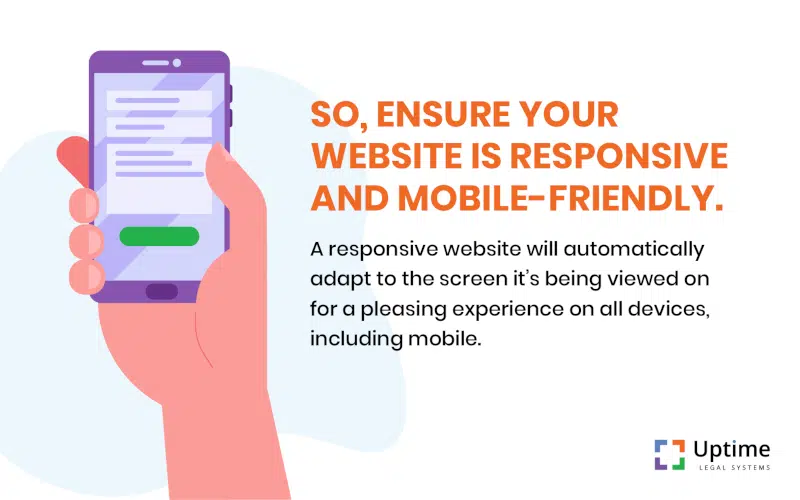
Key Ranking Factor #5: RankBrain
RankBrain is the name of Google’s machine learning algorithm, which predicts user intent when someone searches for a term. Part of the Hummingbird algorithm, it assesses what a user means when they type a search term before returning appropriate results.
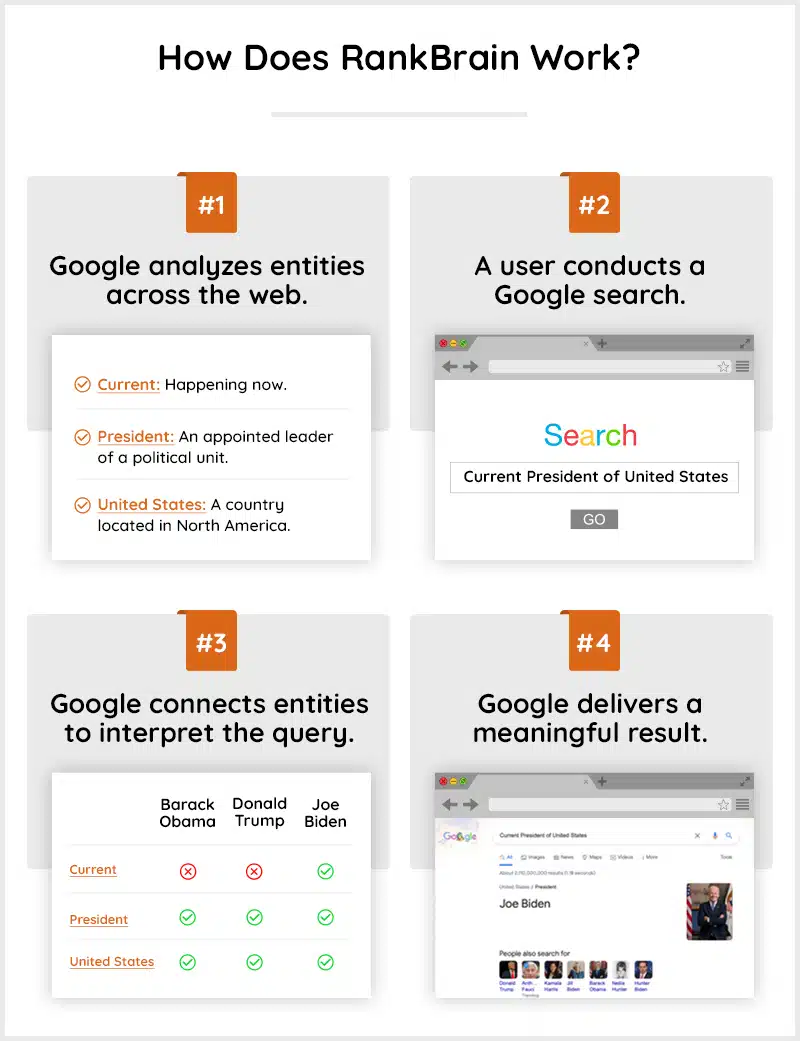
Remember the following factors when optimizing your law firm website for RankBrain:
- Organic click-through rate (CTR): If a page gets more clicks, it may improve the Google rankings for the main target keyword on that page.
- Bounce rate: If a user turns up on a page and then quickly clicks away, it may be an indication that the page content is not of sufficient quality or is a poor match for a keyword search: either way, it’s not good. It’s especially bad if a user bounces and then clicks on other search results to find the answers they’re looking for.
- Direct/repeat traffic to your website: The Chrome browser informs Google how many people visit your site and how often. A high volume of direct traffic or repeat traffic indicates quality and will help rankings.
- Dwell time: How long visitors spend on your site pages is important: the longer they stay, the better the indication of high-quality content.
- Number of comments: A high number of comments indicates user interaction, which is seen as a positive for Google – blog posts, for instance, that receive user comments may get a rankings boost.
Key Ranking Factor #6: Onsite Optimization
One of the main Google Ranking Factors is page-level optimization — also known as onsite optimization.
This relates to how well the text and media on your page are optimized for search.
It’s an expansive topic, and we go into each of the main factors in the dedicated section on onsite optimization. But for now, it’s enough to acknowledge the importance of the following items.
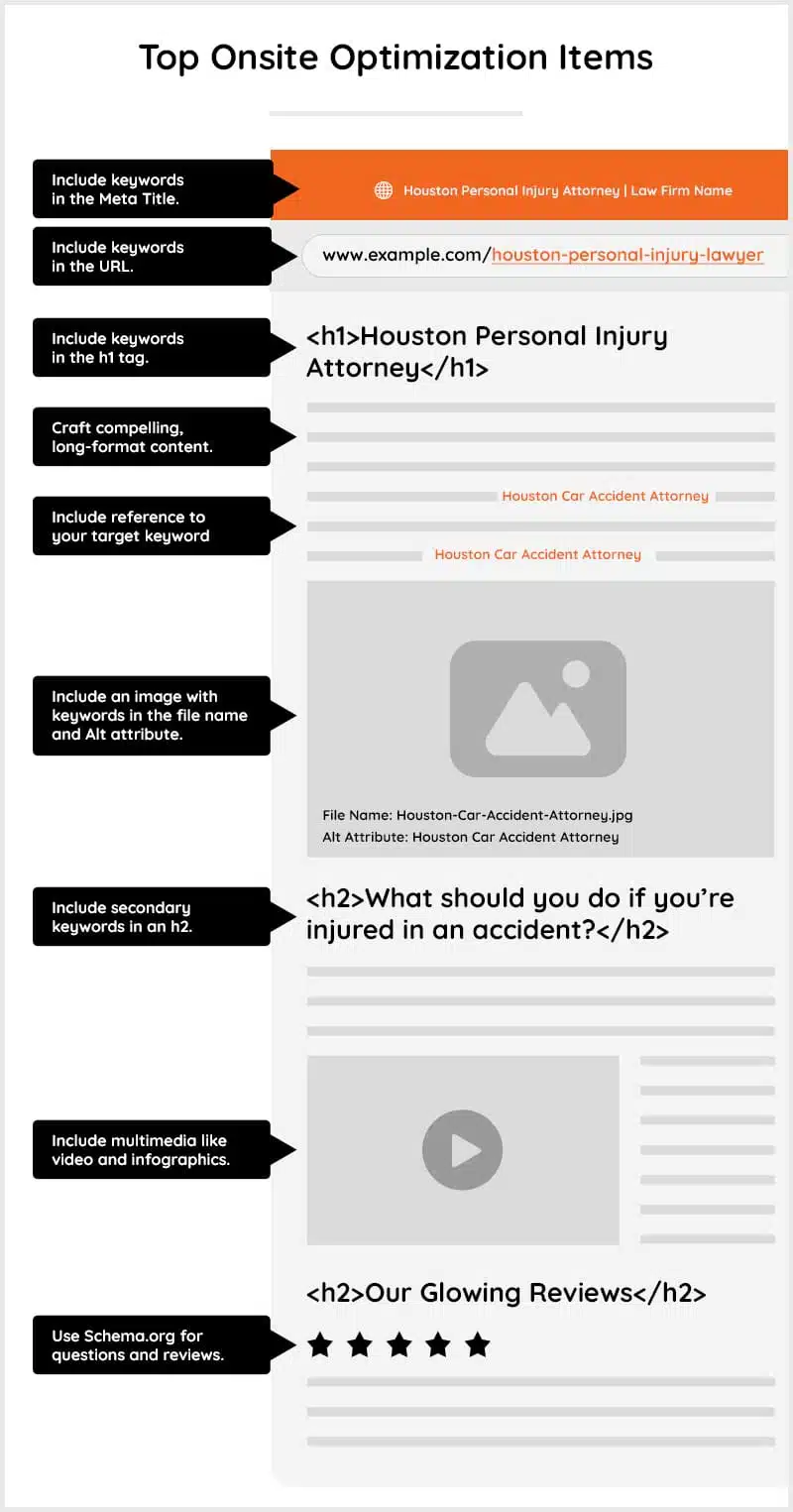
Create a
Successful Law Firm Marketing Strategy
In 10 minutes or less!
Our template will help you to:
- Define your SMART goals
- Craft your brand story
- Create your customer personas
- …and more!
Chapter 3:
Keyword Research for Lawyers
Keywords are one of the most important parts of any law firm’s SEO campaign. They form the foundation of your content, and by using the right keywords, you can start to attract highly targeted traffic to your website.
What are Keywords?
Imagine you’re looking for something online. You type certain words or phrases into a search engine like Google.
These words or phrases are called keywords, and they help you find what you’re looking for.
You want your law firm to rank for as many relevant keywords related to your practice area and geographic location as possible.
The goal is to appear at the top of the SERP (Search engine result page) whenever someone types in a keyword that could potentially bring in clients.
There are two main kinds of keywords:
- Short-tail Keywords: These are short and general, usually three words or fewer. An example might be “lawyer.” Many people search for these, so they’re highly competitive and don’t always lead to people finding exactly what they want.
- Long-tail Keywords: These are longer, usually four or more words, and are much more specific. Imagine someone gets a DUI in the state of Texas and is hoping to get a lawyer. They might search “DUI lawyer in Texas” This is a long-tail keyword. About 91% of Google searches use long-tail keywords, and they’re often easier to use to help people find exactly what your law firm offers.
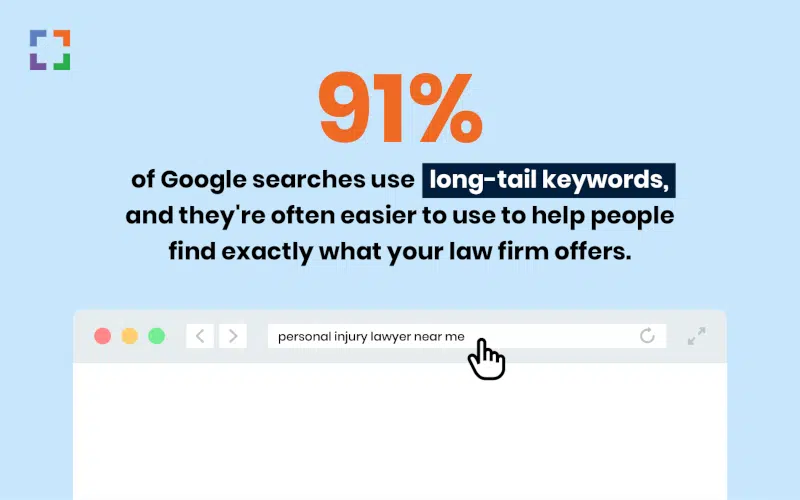
In simple terms, keywords are like clues to help people find your law firm’s website. By using the right short-tail and long-tail keywords, you make it easier for potential clients to discover your legal services when they’re searching online.
Related – Keyword Research for Lawyers: How to research the right keywords to get qualified leads.
What is Keyword Research?
Keyword research for lawyers, then, is the process of identifying words or phrases most frequently searched by your target audience. Keywords form the foundation of an SEO campaign, including content, metadata, URLs, etc.
Comprehensive keyword research should answer several questions, including:
- What is your target client searching for?
- What is the search volume for these keywords and how difficult will it be to rank for them?
- What is the search intent — that is, what are searchers trying to find out?
Keyword research is the foundation of your search engine optimization efforts and forms the foundation of most of your website’s content.
It helps you figure out what your audience is searching for and why, so you can create hyper-relevant content tailor-made for your client persona.
Without the right keywords, you could spend countless hours and thousands of dollars creating content that doesn’t perform how you expected.
How to Perform Keyword Research and Find Profitable Keyword Opportunities
Putting in the effort to identify the right keywords will pay off in the long run.
Here’s a brief overview of some basic keyword research strategies you can use to get started.
Use the Keyword Research Tool
You can use Google’s Keyword Planner tool to look up what potential clients in your area are typing into Google when looking for a lawyer in your practice area.
Or you could use Semrush. It’s a paid tool that’s popular among law firm SEO experts due to its comprehensive suite of digital marketing features.
To get started with Semrush, first head on over to the Keyword Magic tool and type in your practice area.
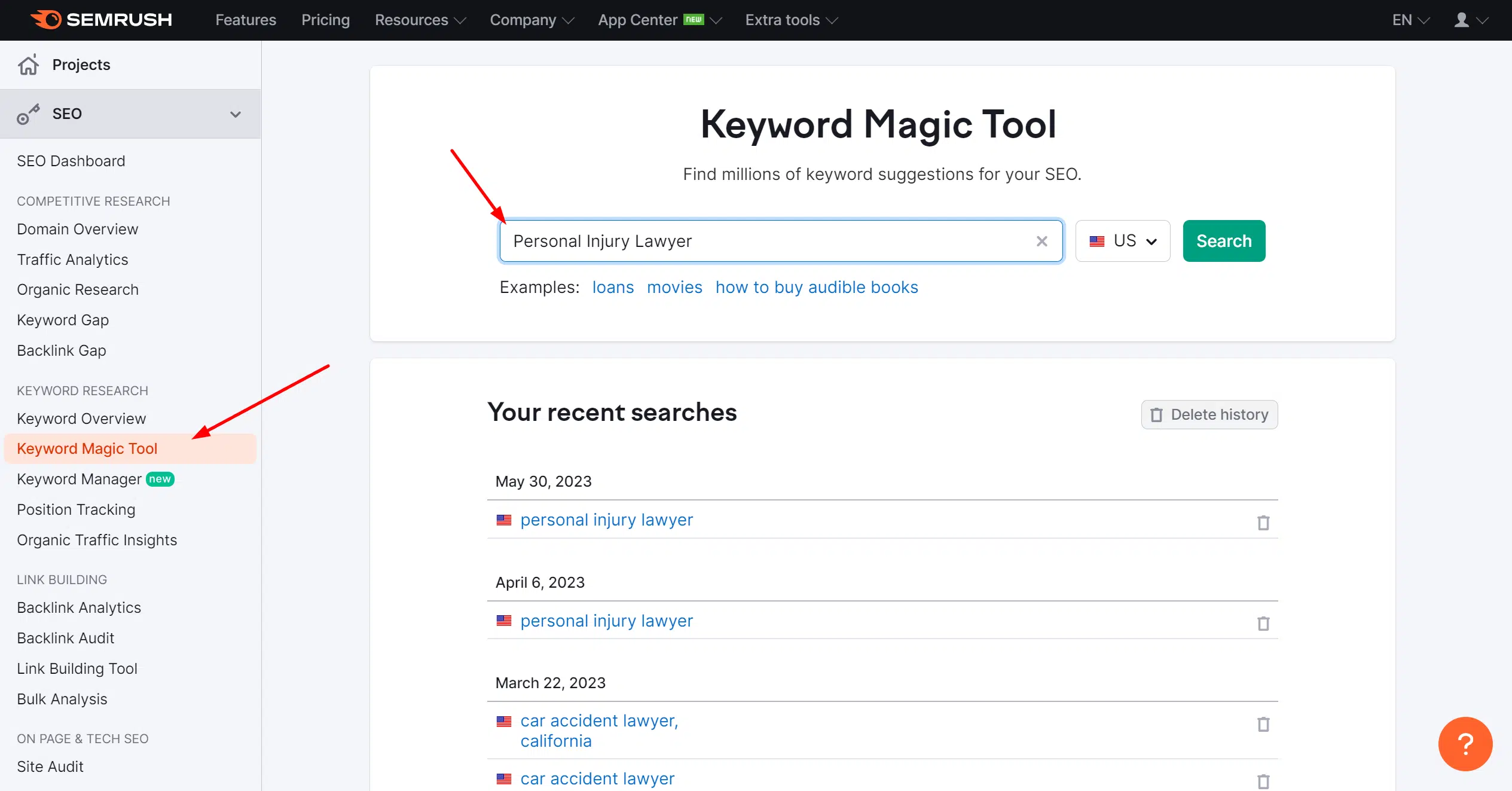
Then you’ll see a list of all the keywords the tool believes would be relevant to you, all with relevant data, including the average monthly search volume and how difficult it will be to rank for them.
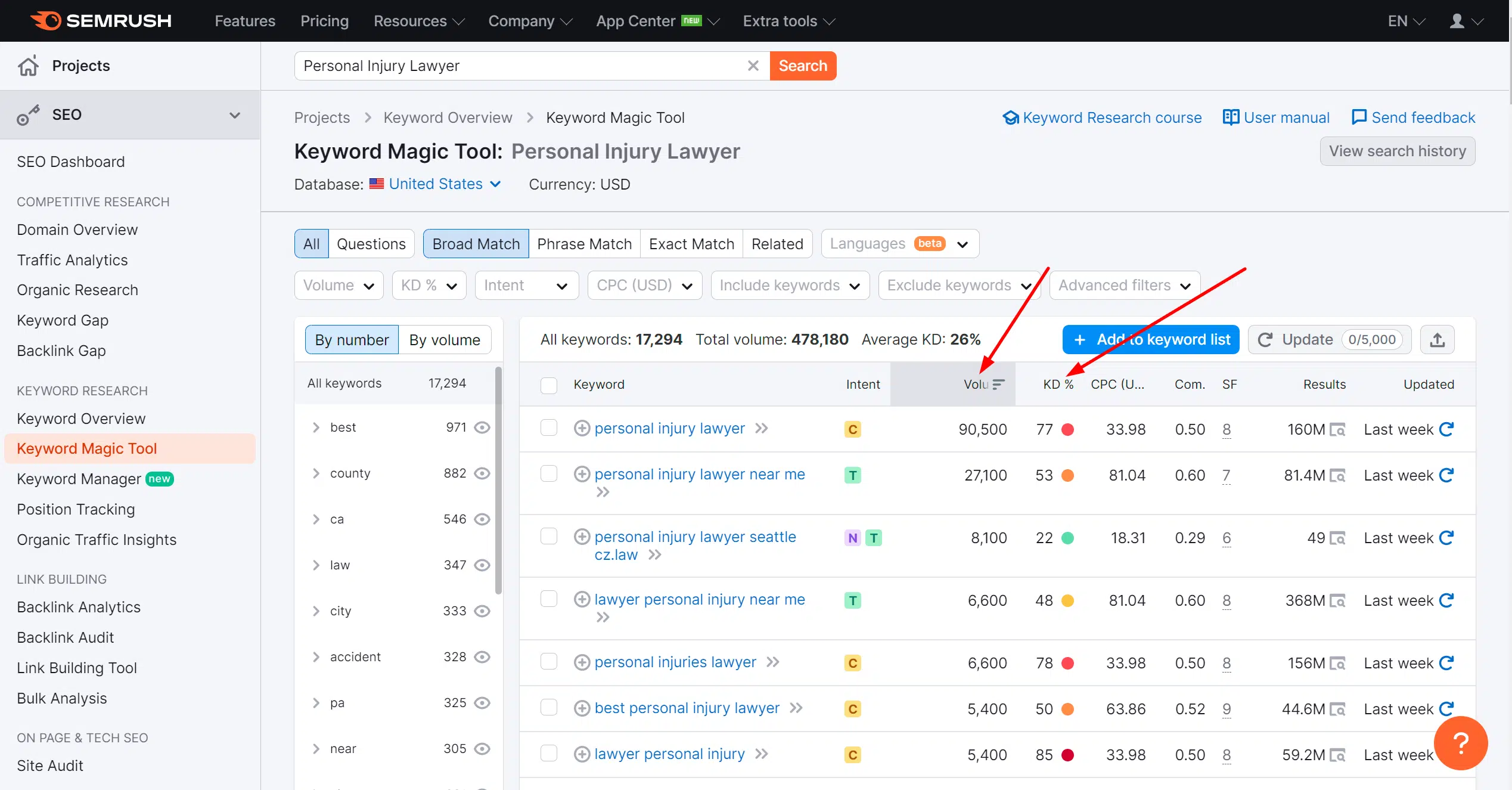
You can also view related keywords and questions that searchers are typing into Google that are relevant.
This is a good way to find keywords related to your practice area, which you can continue to drill down on.
For example, a personal injury lawyer may want to get more slip-and-fall clients. They’d type “slip and fall [city]” into the Keyword Magic tool and look at the “Broad Match,” “Related,” and “Questions” tabs to get a good idea of all the variations of that long-tail keyword.
We do recommend adding your location to the Keyword Magic tool to get even more targeted keyword suggestions. So, “personal injury lawyer” would become “personal injury lawyer in Texas.”
Learn more about Personal Injury Marketing.
Perform Manual Competitor Analysis
One of the most efficient ways to find keyword opportunities is to analyze your competitors.
Tools like Semrush allow you to look at the keywords a competitor is ranking for, what their top pieces of content are, and will even tell you who your competitors are if you don’t know yet.
First, head over to the Domain Overview tab and type in the URL of one of your competitors.
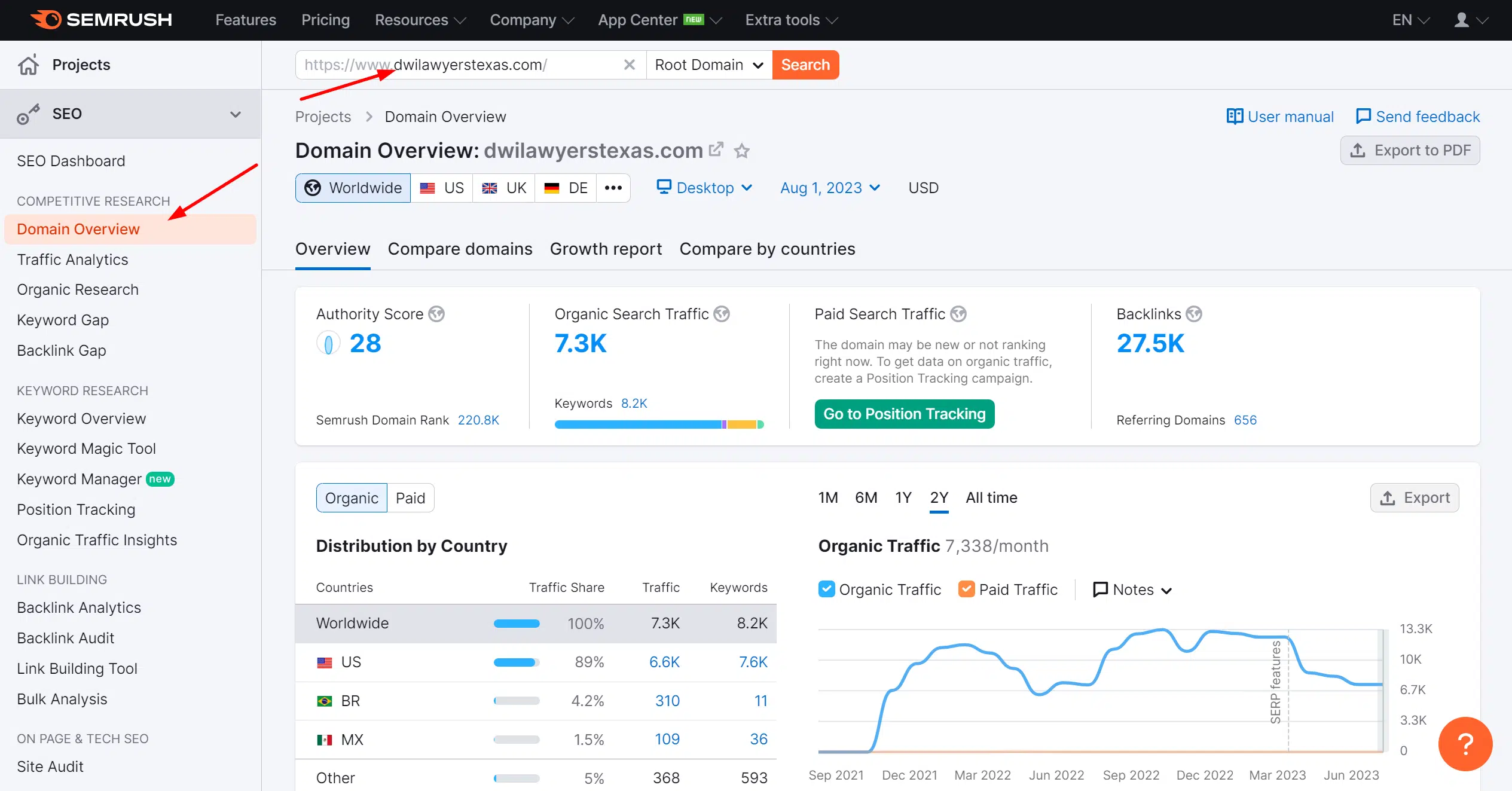
You’ll get a ton of information about your competitor on this screen, but what you’re interested in is the Organic Research.
Scroll down to the Top Organic Keywords box and click “View details.”
You’ll then see all of the keywords your competitor ranks for, which can be sorted by volume, difficulty, rank, and more.
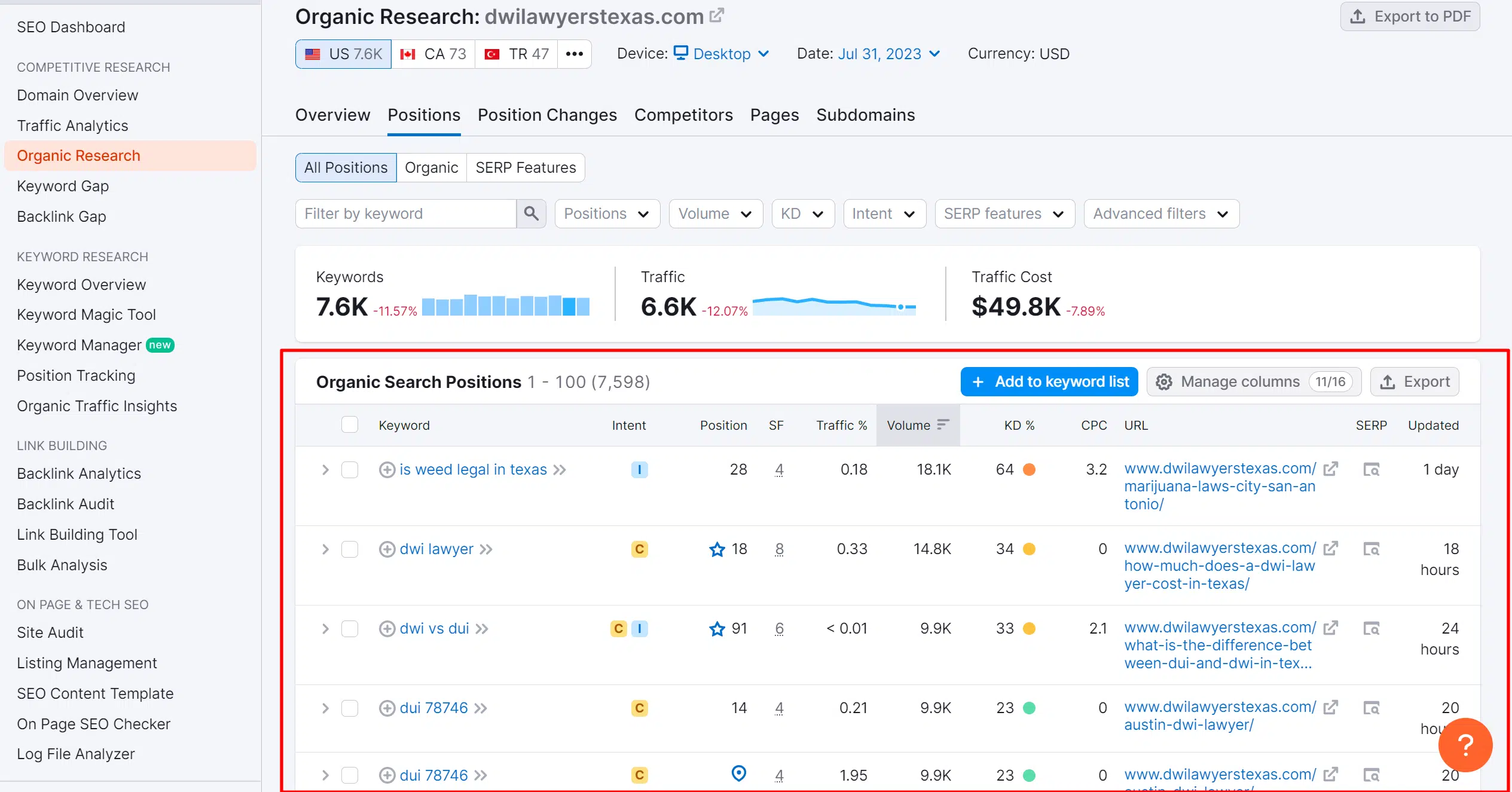
If you do this for all of your local competitors, you’ll have a good idea of what keywords are worth going after and which aren’t.
From there, you can dive deep and discover their top-ranking content pieces to learn what keywords you need to target.
“People Also Ask” Section
One easy way to identify questions that people are asking related to your practice area is to head to Google itself.
Type in a keyword, like “Slip and fall injury in Texas.”
You’ll see a section called “People also ask” that is home to several questions related to the keyword you type in.
These are good questions you might consider answering in your content, as they’re actively being searched for.
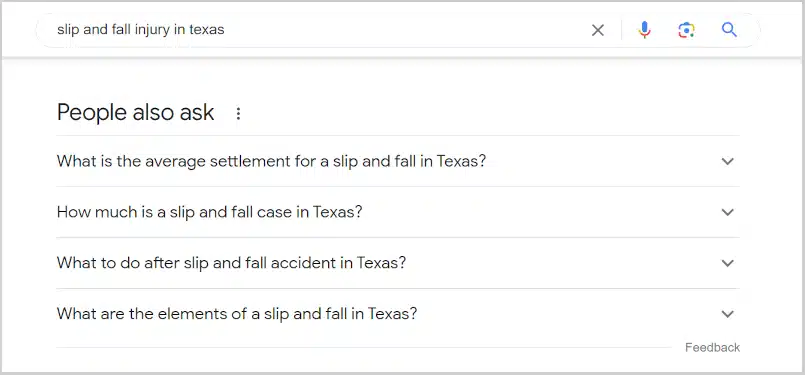
Each of the questions highlighted below can be searched separately to find more related questions. It’s a veritable goldmine for keyword phrases to target.
It’s important to note that Google generates these questions from thousands of potential options, yet it found the ones listed to be most closely related to the original search query.
Read Legal Forum Q&As
Avvo and lawyers.com are two law firm directories that can help you scan for frequently asked questions.
Both forums (Avvo Forum, Lawyers.com) feature a wide range of Q&As, which can reveal excellent keyword phrases to target for content during the informational/awareness stage.
Here’s how the lawyers.com Q&A section looks.
These are questions asked by real people looking for legal advice. They can reveal some excellent insights into the minds of potential clients.
And here’s how it looks in Avvo. Note that you can sort questions by practice area.
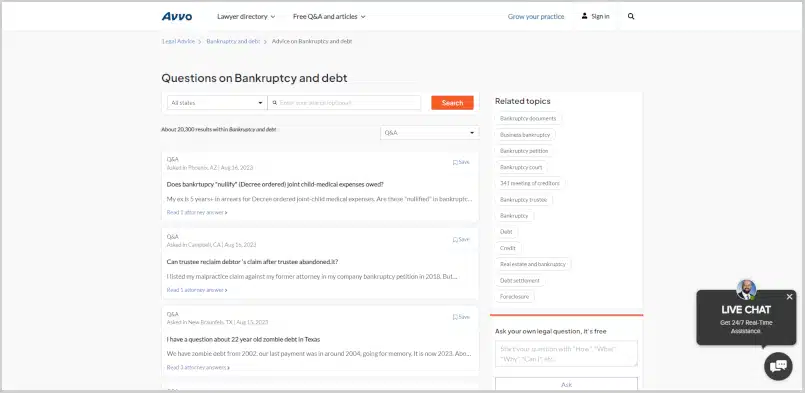
Bonus tip: Answering these questions when logged into your Avvo/Lawyers.com profile is an excellent way of establishing E-E-A-T and building your brand.
Keyword Research Tools for Attorneys
We’ve already mentioned a few keyword research tools you could use (Semrush and Google Keyword Planner). They’re essential to not only finding keywords for you to target but also for building backlink opportunities, identifying competitors, and more.
Here is a list of keyword research tools, sorted by free and paid options.
- Google Keyword Planner
- SEMrush
- Ahrefs’ Keywords Explorer
- Moz’s Keyword Explorer
- Ubersuggest
Chapter 4:
Content Marketing for Lawyers
Content marketing involves creating content that tells a story to attract and engage your client persona. That content should be so valuable that not only does Google rank it highly, but it also entices readers to stay on the page and even branch out to other pages on your website.
It could include blog posts explaining legal rights or videos that guide people through common legal problems. The goal is to provide helpful content that people can relate to and learn from.
The overarching goal of writing content should be to become a Topical Authority.
A Topical Authority is a person or brand perceived as an authority over a niche service or skillset.
Positioning yourself, and your firm, as an authority on a topic provides numerous benefits in Google’s search results and on your website.
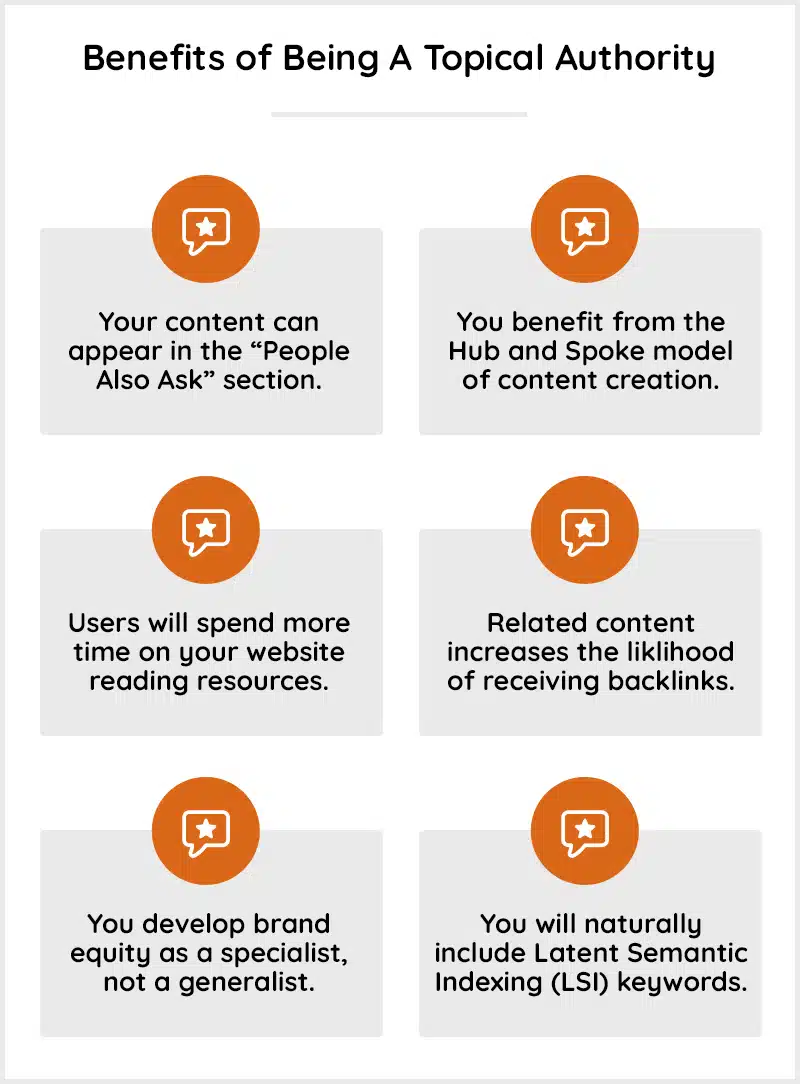
The TopicSeed website says, “topical authority is the future.”
“Unlike keyword research that targets a set of literal phrases, topical authority and topical research require a broad yet deep comprehension and mastery of linked entities and hierarchical concepts.”
So, how do you position your firm as a topical authority and give Google what it wants?
In our experience, Google rewards content that is:
- Original with no duplication
- Authoritative, well-referenced, and researched
- High-quality, informative content that provides valuable insight into the topic
- In-depth: long-form is favored over short-form content
- Easy to read, well-written
- Well-structured
- Recent and updated
What Type of Content Should You Create?
The needs of your target audience are defined by the user’s intent when they search for information.
Therefore, a law firm’s content strategy should align with its user’s intent. We find that the keywords our law firm clients go for are a 3:1 split between informational and commercial keywords.
For most law firms, this largely means creating seven types of content for their website:
- Practice pages
- Attorney Bio Pages
- Blog Articles
- FAQ Pages
- Long-Form Content
- Images and Infographics
- Video
These content types will account for 80-90 percent of what you need to do from a content marketing perspective.
Related – Content Marketing for Lawyers: Content marketing strategies and tactics for law firms.
Practice Area Pages
Practice area pages are the most important pages on a law firm’s website. They’re bottom-of-the-funnel pages where you go for more of a hard sell and try to convert visitors into paying clients.
Imagine someone is going through a divorce in Austin, Texas. They might search “divorce attorney Austin.”
If this is the type of case you handle, then you should rank for that keyword. Having a practice area page that’s dedicated solely to divorces in Austin is how you do that.
Your practice area pages should cover only one practice area at a time and be as specific as possible. For example, family law attorneys should have one practice area page for child custody issues and another for divorces.
See how granular the DWI practice area pages are for Richard Hochhauser DWI & Criminal Defense.
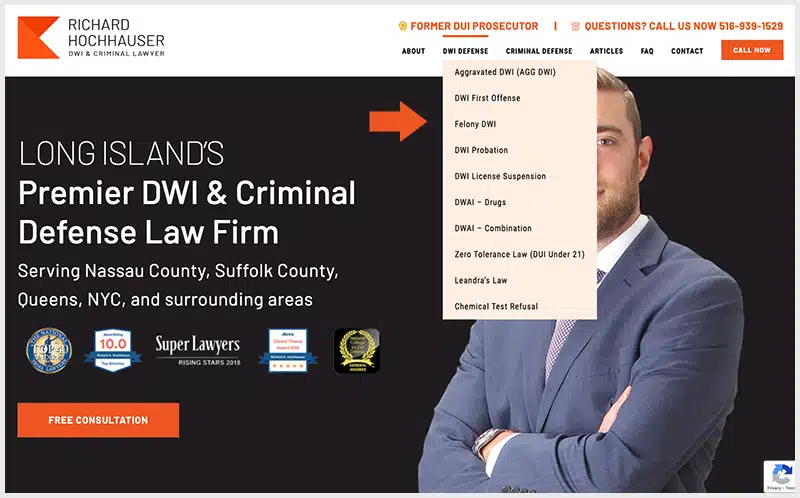
Your practice area page (in this case, divorces in Austin) should accomplish these three goals:
- Target relevant keywords like “Divorce Attorney in Austin”
- Provide searchers with information about filing for a divorce in Austin
- Address specific laws and rules that pertain to the state and/or city you’re targeting
- Have sales-driven copy to convince searchers that you’re the right attorney for the job (and drive them to reach out to you)
It’s your chance to sell yourself. Don’t shy away from providing too much information (think 2,000 words rather than 200 words), and don’t forget to include CTAs.
Attorney Bio Pages
Potential clients will be interested in your experience and expertise. An attorney bio page is a perfect location for this information. You want to supercharge your profile page to make it as enticing as possible.
Here’s an example for Long Island attorney Richard Hochhauser.
Blogs
Did you know that companies that blog get 55% more website visitors (and 67% more monthly leads) than those that don’t?
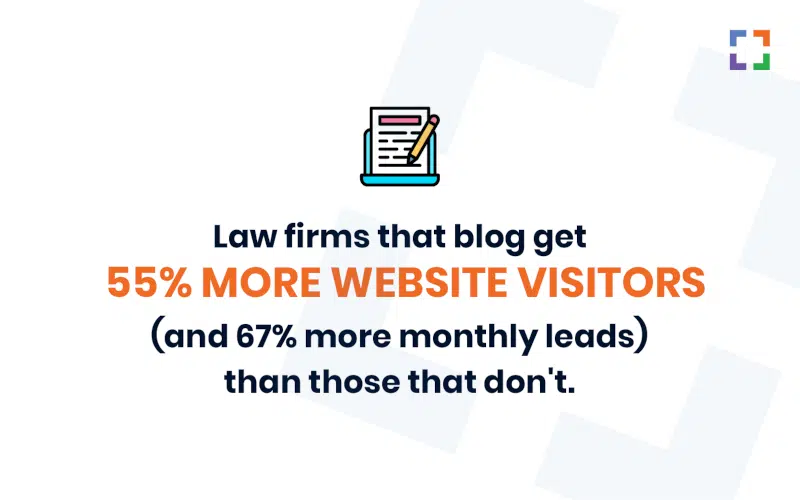
Producing content costs 62% less than traditional marketing formats but generates 3x the leads.
So, if you run a law firm, you can’t miss out on blogging. It’s an essential marketing tactic for increasing your rankings, website traffic, and leads.
One of the best strategies we’ve found with blogging for lawyers is to answer the questions your target audience asks.
Here’s a good example about suing an insurance company after an accident.
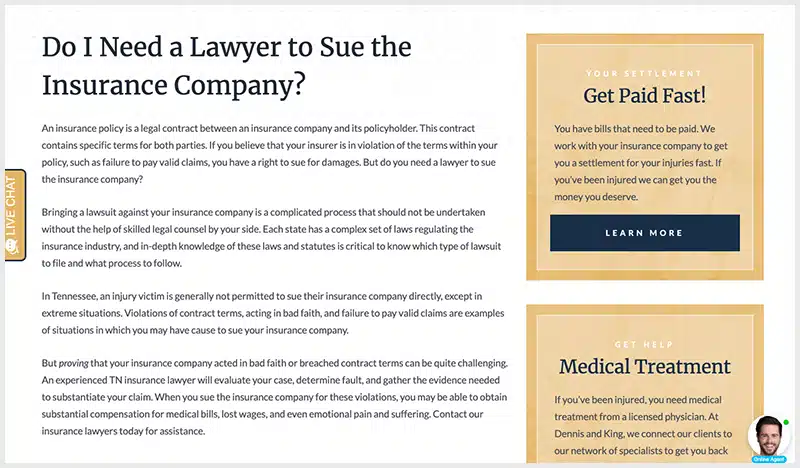
Blog posts aren’t necessarily designed to sell your services.
High-quality, informative blog posts are shared widely online. They attract links and shares, build awareness, and highlight your expertise. You should target high-volume, long-tail keywords with your blog posts.
Consider answering frequently asked questions and industry topics related to your practice area (that also has a substantial search volume).
FAQ Pages
A well-crafted FAQ page can help you accomplish two things:
- It will help your website rank well and attract new visitors
- It will help move visitors through your marketing/sales pipeline
When you’re brainstorming questions to answer, think about the types of questions you get asked every day by potential and current clients. These are the questions first-time visitors might want answered before reaching out to you.
They could relate to your services, answering questions like “How much does it cost to hire a divorce attorney in Texas?” Or, they could be more general, answering questions like “How do I file for divorce?”
FAQs can feature on the homepage or be scattered throughout your practice area pages, like this one from Houston Personal Injury Attorney Ryan Dehoyos.
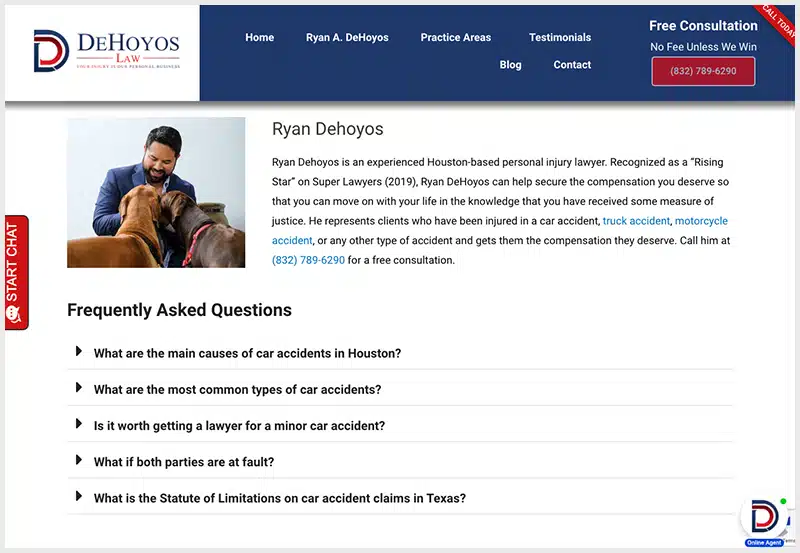
Alternatively, you can build dedicated FAQ pages, like Spectrum Family Law in Edmonton.
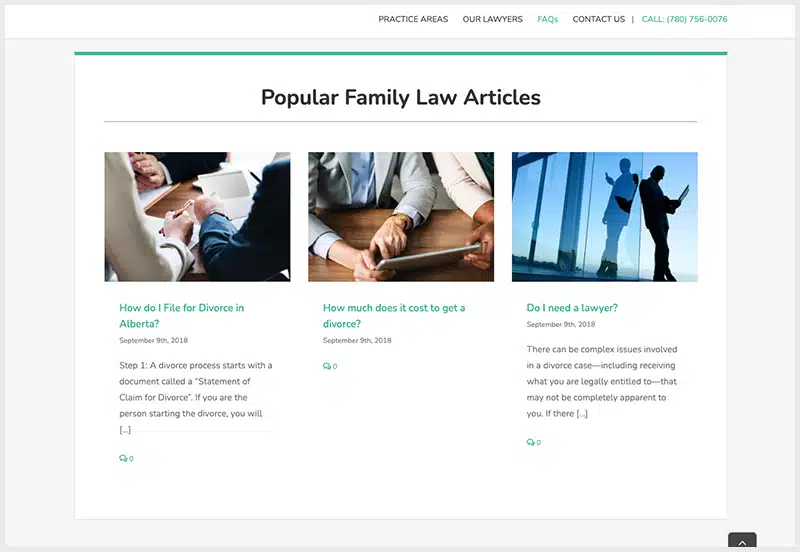
Long-Form Content (Guides, Whitepapers, etc.)
Consider creating long-form “gated” content like whitepapers, eBooks, and guides.
This type of content is often more in-depth than a blog post and is often locked behind a sign-up form. Once a visitor fills out the form, they’re taken to a landing page that’s designed to convert readers into paying clients and send positive SEO signals to Google.
Step-by-step guides that break down complex topics into easy-to-understand pieces are effective for blog posts, eBooks, and other downloadable resources. They can help you attract attention and capture contact information from prospective clients.
Here’s an example of a step-by-step guide.
This type of content can increase your dwell time and link out to tons of other content on your law firm’s website. A great way to keep visitors engaged with your brand.
Images and Infographics
Did you know that 43% of people admitted to skimming blog posts? And we expect that number to be much higher.
You should use images on your website (not just on your blogs) to showcase the lawyers at your firm and to enhance your website content.
They do more than just make your pages visually appealing. Blogs with images get 94% more views than those without, and blog posts with more than seven images get 116% more traffic than those without images.
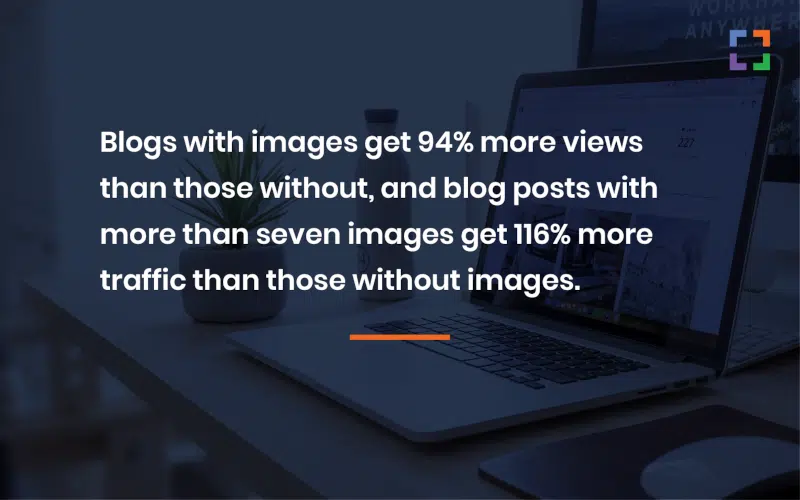
You could also create infographics to showcase stats related to your practice area in an appealing way. These are great for communicating statistics and are also highly shareable.
Video
Video marketing for lawyers is much easier than in years past. Now, with advancements in tech, almost every one of us carries a video production studio in our pocket.
We recommend our clients create simple videos using their iPhone or Android device.
The video can be edited to include a logo sting, background music, and a call to action. It’s an excellent way to attract video views on YouTube and increase the time on-site for key web pages.
Here’s an example from Trey Porter in San Antonio.
What Are “Topic Clusters” and How Do They Affect Content Architecture?
With “Topic Clusters,” a primary page or “pillar page” acts as the centerpiece of a particular topic, and supporting pages that go deeper into each element of the topic link to it. These pages feed attention and authority back to the pillar page.
This is a great way to strategize your firm’s content, as topic cluster models may become more prominent in SEO. In fact, law firm SEO services are focusing on this model.
So, a law firm focusing on DUI in Florida might work towards this model with its content.
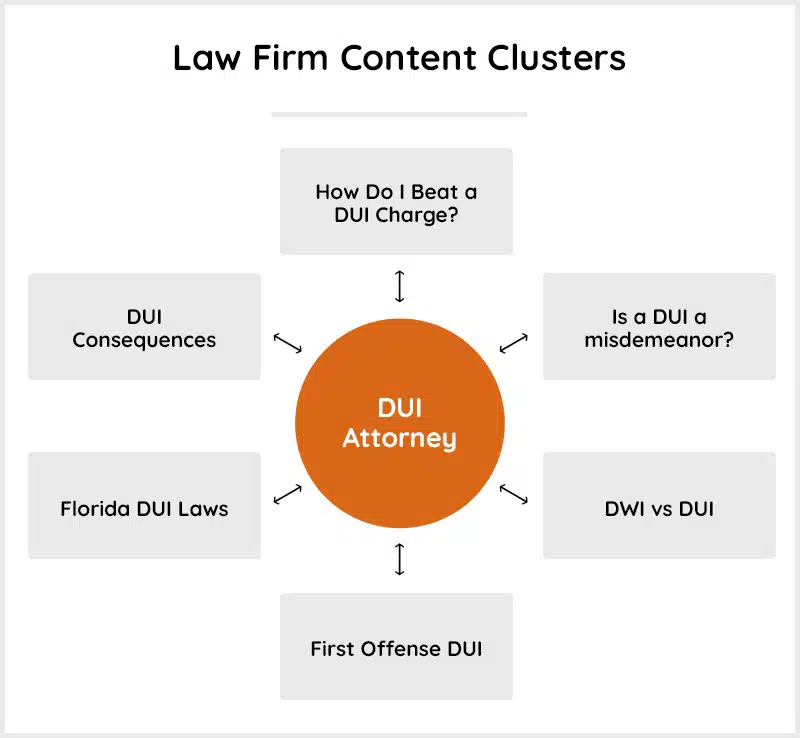
The main pillar page is DUI Attorney, and the clusters provide further information and raise the authority of the main page. They also allow you to target more individual keywords (great for SEO).
Optimizing Your Law Firm’s Content: Structure and SEO
Regardless of the type of content, certain structural elements are important for both readability and rankings.
Google’s Quality Guidelines document states:
“The page layout on highest quality pages makes the Main Content immediately visible.”
This means that the structure of the content on each page is likely important for rankings.
Focus on the following structural elements for your content.
Create Long-Form Content
Longer blogs, on average, tend to outperform short blogs.
We recommend at least 1,500 words as a baseline for most blogs. But don’t just write to increase your word count. If you’ve covered the topic thoroughly and are below 1,500, go ahead and publish it.
Write Short Paragraphs
Make your content easy to skim by breaking up text like the example below.
Use Expressive Headers and Sub-Headers
Descriptive, well-placed sub-headers are important for scan reading and general readability, as well as for the opportunity to use keywords.
It’s beneficial to use headings and subheadings to pose a question and then answer the question directly below. This approach makes it easy for a user to skim a page and find information relevant to their situation.
Make It Easy to Read with Bullets and Numbered Lists
Bullet points and numbered lists are a great way to organize content into a logical, easy-to-read order.
Include Relevant Images and Videos
Images and videos are an effective way to break up text and make it more “digestible.”
Remember to Include a Call to Action
People are on your website for a reason. Whatever the reason is, you can help them take the next step and stay on your site for longer (great for SEO) or convert to a lead (the ultimate goal of SEO).
If they’re searching for information, the next step may be to download a guide. If they’re looking to hire an attorney, the next step may be to call or email you for a free consultation.
Either way, calls to action should be dispersed throughout your content.
Additionally, you should should:
- Additionally, your content should:
- Include the relevant keywords to drive searchers to your website’s page
- Be readable by the everyday person (think a grade 7 or 8 reading level)
- Format your headers so they answer questions (many searches are posed as a question, like “How can I get out of a DWI?”
- Keep your law firm’s content updated with relevant statistics
- Periodically refresh old content so that it stays relevant
Chapter 5:
Onsite and Offsite Optimization for Lawyers
On-Site SEO for Lawyers
Onsite optimization is the process of improving a website’s architecture, content, and code to make it search engine-friendly.
As you saw in the first section, page-level factors (onsite SEO) are among Google’s most important ranking factors.
Some of these on-site elements include:
- Site structure
- Site speed
- Title tags
- Meta descriptions
- Internal linking
By optimizing these factors, you’ll be improving the user experience of your law firm’s website, which is a key ranking factor.
The better the user experience, the longer visitors stay on your website, and the more likely they’ll think you’re credible and contact you.
Nothing found.
Related – On-Page SEO for Lawyers: Learn more about on-page SEO, including top tips.
The following on-site optimization techniques all help optimize the user experience.
Let’s look at a few of the key areas.
Site Structure
You need to make it as easy as possible for users to navigate your website. They should be able to find any page they’re looking for without getting lost (which could lead them to leave your page in frustration).
You start with your homepage, then you nest the rest of your content beneath the homepage.
There are two routes you can go with this.
Flat Structure, with no use of sub-directory folders.

Sub-Directories, uses directory folders to organize content.

While many law firm websites rank highly using the second option, we always recommend a flat URL structure for clients because the keyword is introduced earlier in the URL string.
While we are on the subject of URLs, there are two other URL-related ranking factors to bear in mind:
- URL Path and Length: Pages close to the home page may be better ranked than those “buried” within the site.
- Short URLs: These tend to rank better than long ones.
If you have a multi-location law firm, here’s how you can utilize a flat URL structure.
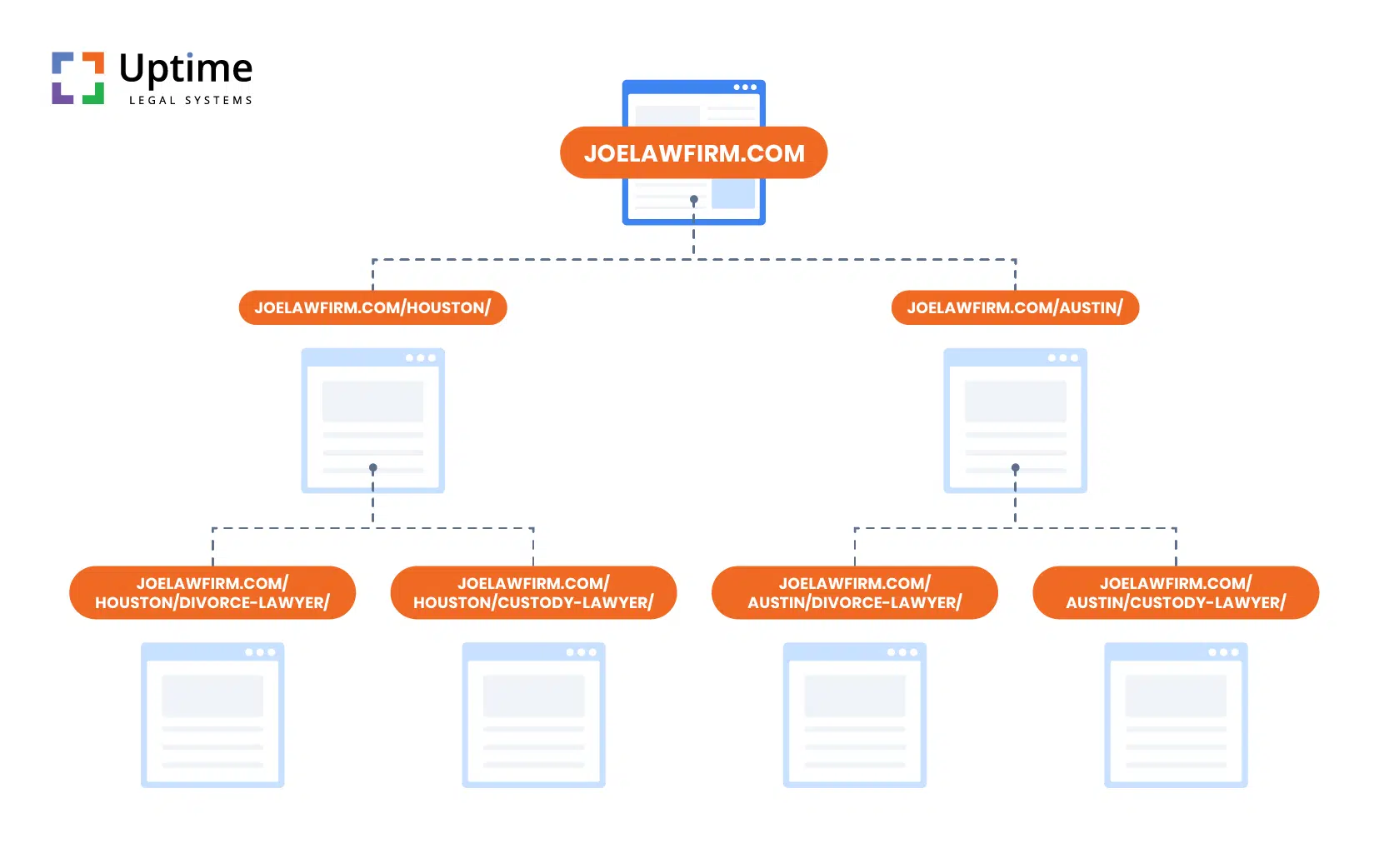
Professionally Written Title and Meta Descriptions to Boost Your Law Firm’s SEO
The page meta title and description tags are what you see in the Google Search Engine Results Page after you type in a search term. The combination of the meta title, description, and page URL is called a snippet.

Meta titles and descriptions tell Google and potential clients about the page’s topic.
Titles and descriptions should be professionally written because of their importance in generating top rankings in Google.
While they aren’t direct ranking factors, they do affect your SEO. Meta descriptions are used to get a targeted message displayed in the SERP that can improve your clickthrough rate and brand awareness.
If you don’t write one, Google will pull one from your content instead. And there’s no guarantee that it’ll be very convincing.
Optimizing Title Tags for Best Results
Getting your title tag right is very important. It’s one of the most influential aspects that inform your on-page SEO.
When done right, a well-written title tag can help you rank higher in search results by communicating what your page’s topic is.
Title tags should include the target keyword first, followed by a pipe, then the firm’s name.

Here are some more tips:
- Use “lawyer” over “attorney” as it has more search volume
- Use fewer than 60 characters
- Target only one location (state/city) per page
- Include your city or state when optimizing for local search
- Use modifiers like “near me” or “free consult”
Improve Page-Load Speed
You now know that page-load speed is an important ranking factor in law firm SEO.
Here’s what Google found about mobile page load speeds in a 2017 study.
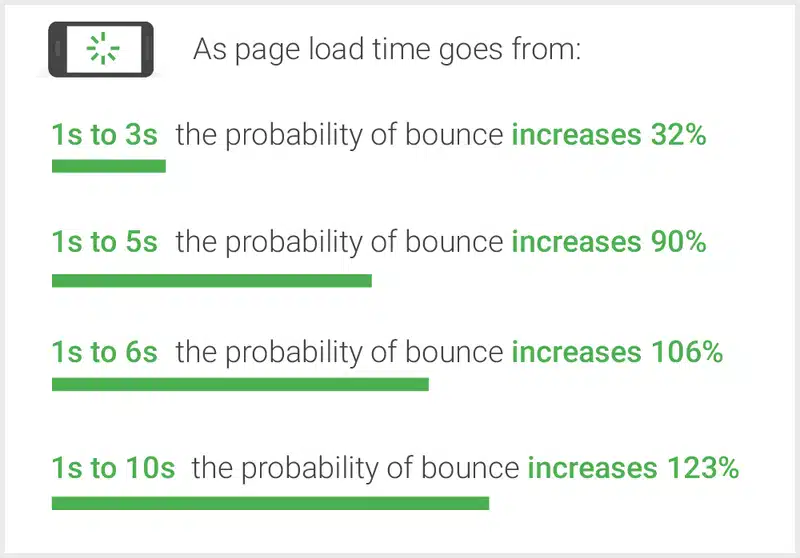
It’s compelling data.
Besides the negative SEO effect, it’s fair to say that nothing damages user experience like a painfully slow website.
So, how’s your site’s speed? Check it using Google’s free tool.
Here’s the result for one of our client websites.
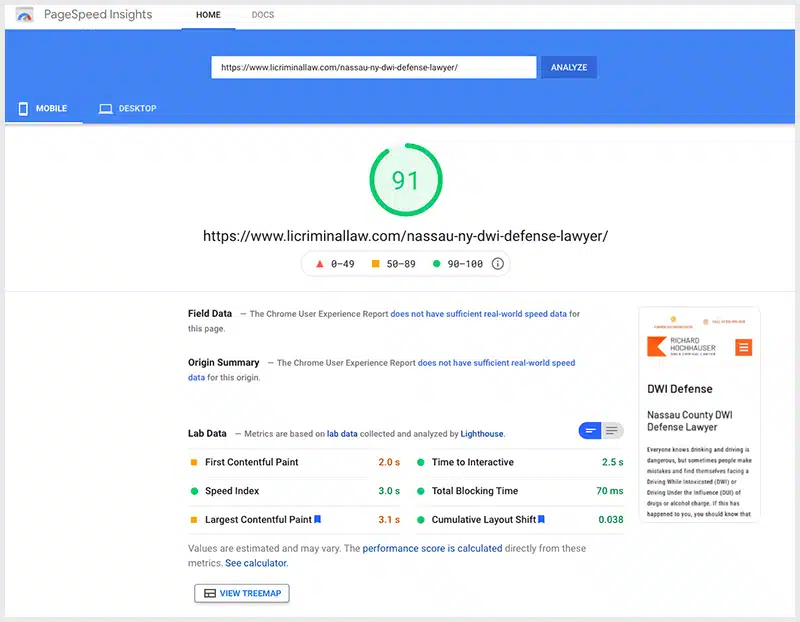
As you can see, the page speed score is 91 percent. The average is between 50-89 percent.
The bottom line? To increase the speed of your website, do the following:
- Select a premium hosting platform, one that isn’t driving traffic away with poor performance
- Compress all images used on your website (uncompressed high-def images are the main cause of slow speed)
- Install a caching plugin to compress and optimize scripts
Optimizing Internal Links
Internal links are an important part of lawyer SEO.
By internal links, we mean applying a link via anchor text to another page on the same website. The intention behind it is to help visitors navigate to other relevant pages of your website.
We’ll go over this more later. But for now, you need to know that Google loves internal links.
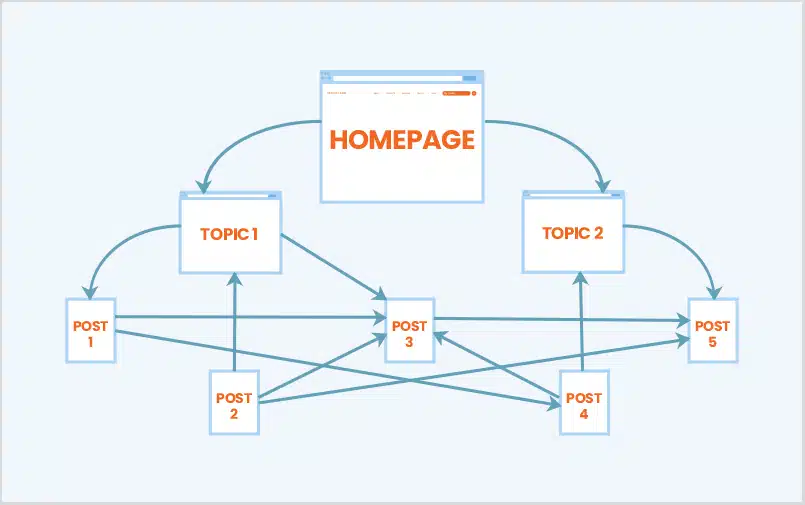
Adopt Schema.org
Without getting too technical, adopting legal service “schema” will also improve the structure of your law firm’s website and SEO.
Schema is a specialized code inserted into the backend of a website to help Google understand what that website is about.
By using legal service schema, you can communicate to Google what your website is about so it’s better able to categorize and rank your content.
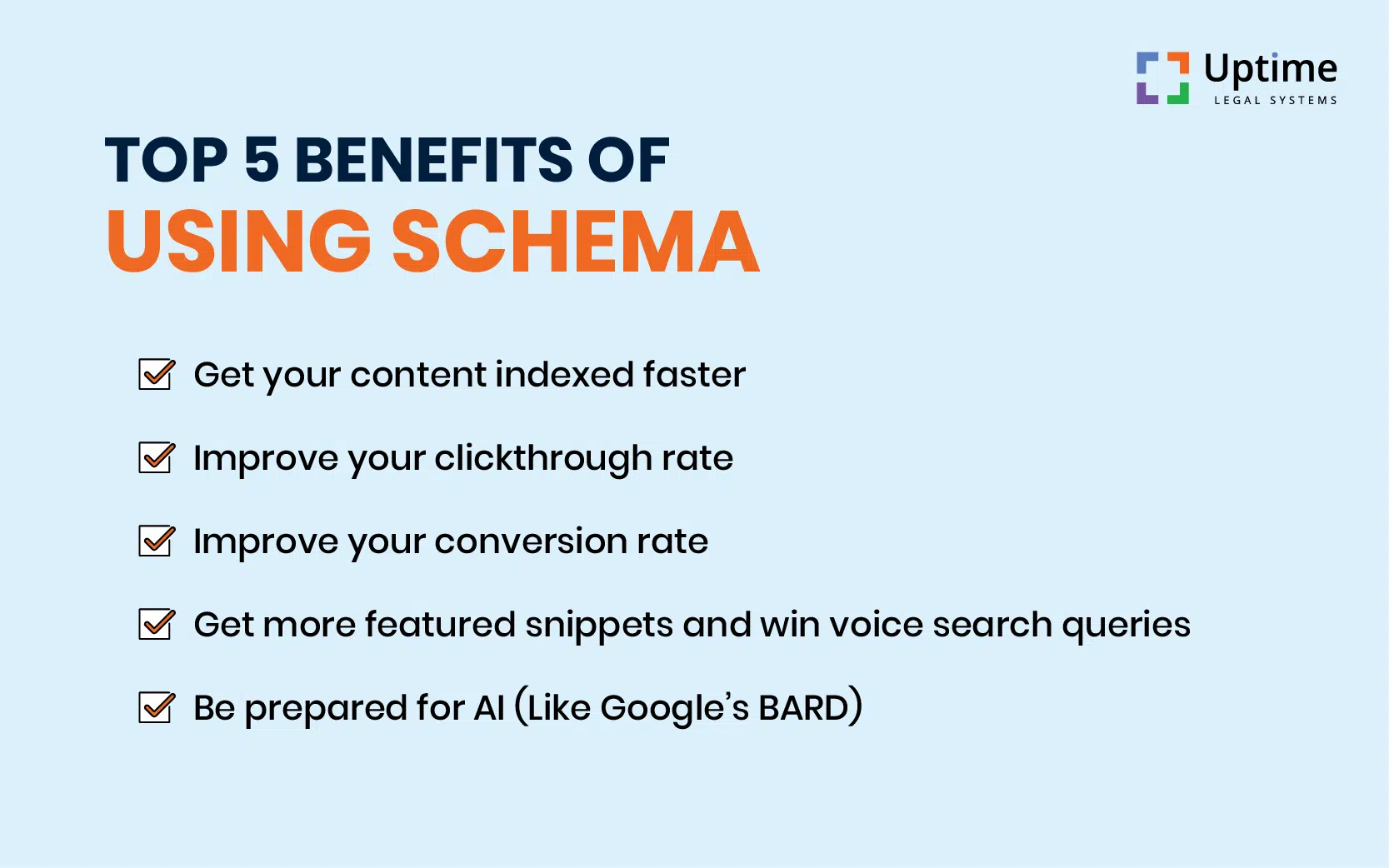
You can add schema to your website by writing the code manually, using a third-party schema generator, or by hiring an SEO specialist.
Another type of schema we use for our client’s websites is review schema. We find it directly improves conversion rates.
Off-Site SEO for Lawyers
Off-site SEO, also known as off-page SEO, is a crucial part of optimizing your website for SEO.
It involves efforts to improve your website’s reputation and visibility through methods outside of your own website, such as backlinks from other reputable law-related websites, social media engagement, and review solicitation.
We’ll dive into link building in more detail next. For now, let’s take a look at the off-site SEO factors you can influence for positive SEO.
Client Reviews
Reviews or testimonials help potential clients understand your services better AND are important for SEO.
An SEO service for lawyers can help you figure out a way to request reviews and testimonials in a fluid, organic way.
Think of them as your corroborating evidence. Almost all visitors will expect to see other people saying good things about your firm.
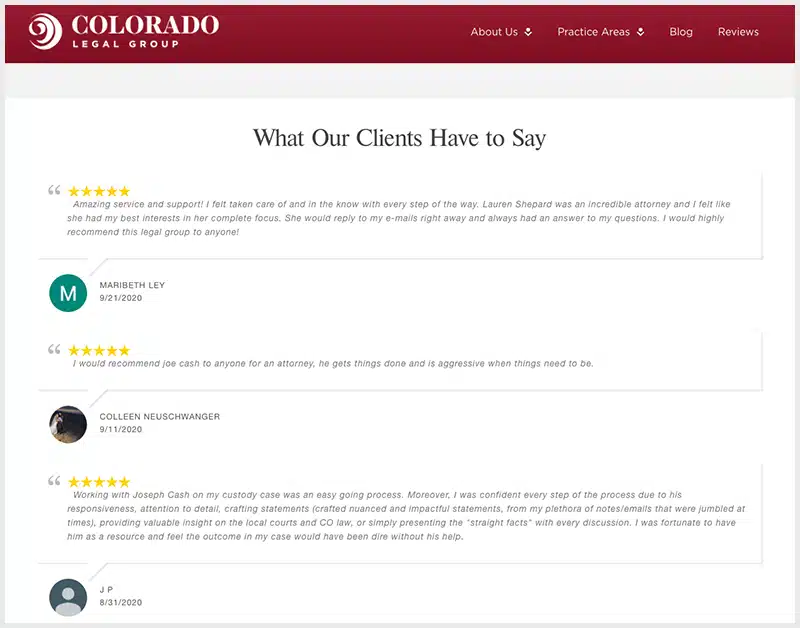
Bright Local’s 2023 Local Consumer Review Survey shows how important it is to actively solicit reviews, and to do it continuously.
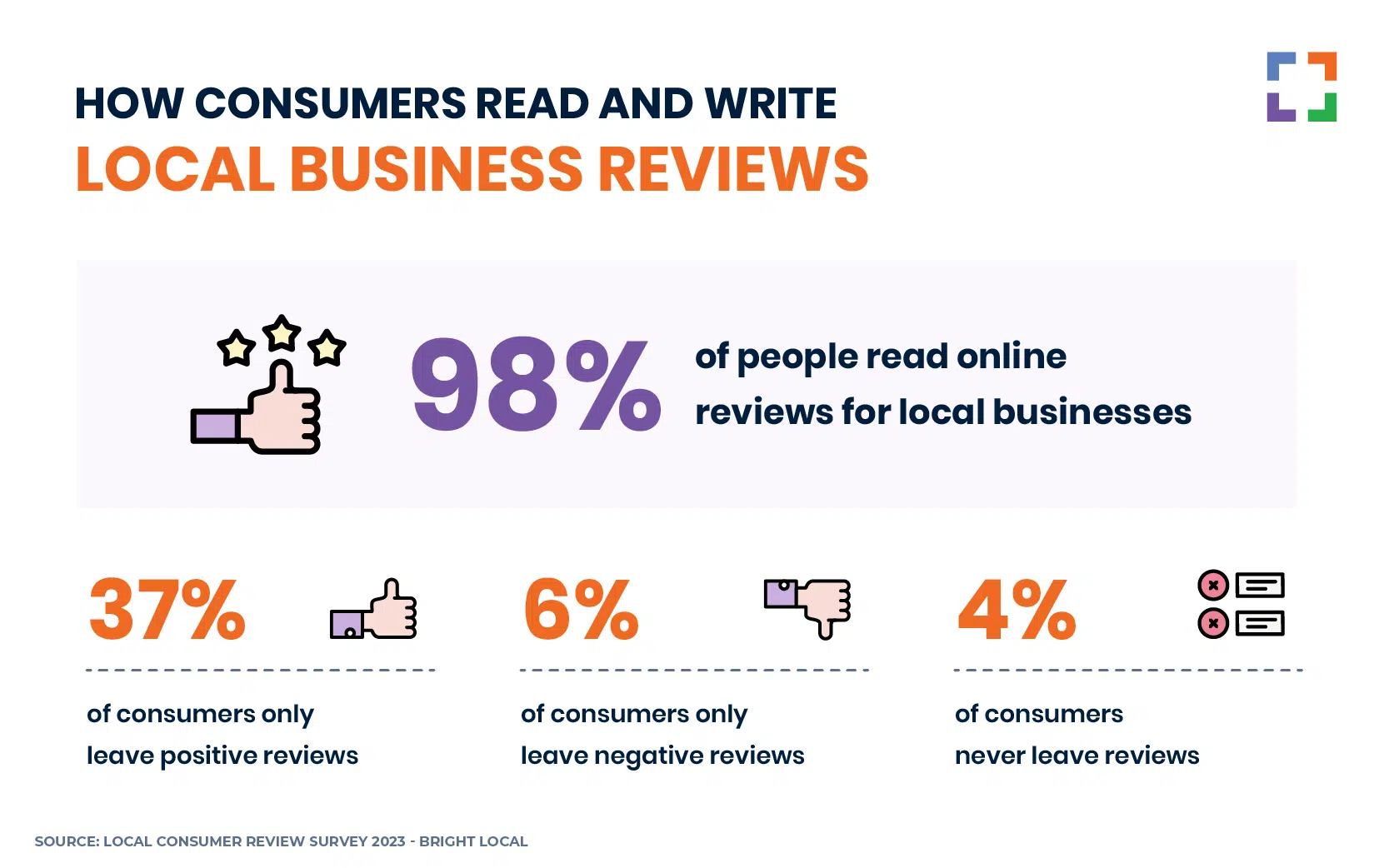
People now trust online reviews as much as personal recommendations. They are seen as an indication of how much you can trust a local business.
So, you absolutely must have them to attract clients.
From an SEO point of view, reviews are used as an important ranking indicator in local searches. Google says it itself in its guide: improve your local ranking on Google.
“Prominence is also based on information that Google has about a business, from across the web, like links, articles, and directories. Google review count and review score factor into local search ranking. More reviews and positive ratings can improve your business’ local ranking.”
More on that later.
Legal (and General) Directories
To follow up, it’s also important to create profiles and ask for reviews on legal and general directories.
Directory profiles on websites like Avvo and Yelp can:
- Boost your local SEO by generating reviews
- Increase your E-E-A-T and establish yourself as an authority
- Bring in new leads that you otherwise wouldn’t reach
Social Media
While social media isn’t exactly a ranking factor, it’s still worth a spot in your marketing repertoire.
A strong social media presence can:
- Boost your local SEO by generating reviews
- Increase your E-E-A-T and establish yourself as an authority
- Bring in new leads that you otherwise wouldn’t reach
Related – Social Media for Lawyers: Learn top tips and tricks for building a social media following.
Maintain an active presence on a few different social media platforms. We recommend LinkedIn (with over 900 million members) and Facebook (with over 2.93 billion active members).
Instagram and TikTok could be worthwhile if your audience is younger.
For reference, here are the most popular social media platforms for lawyers.
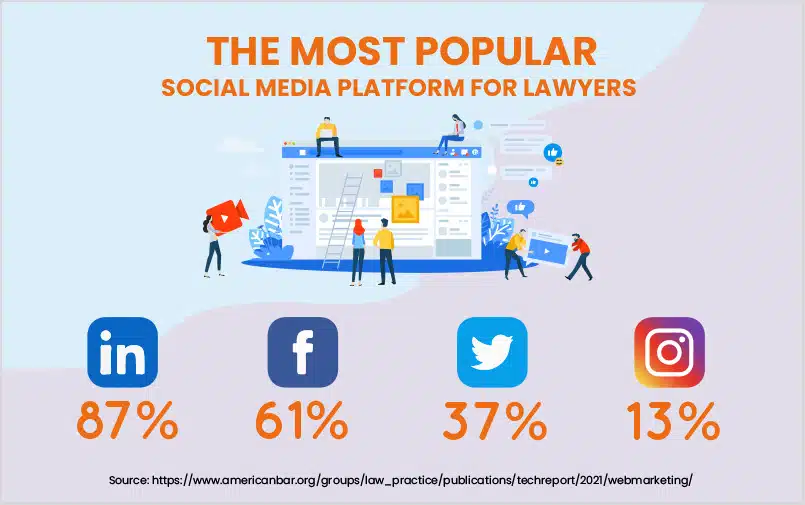
We recommend mastering a few platforms at first before stretching yourself too thin. The key is to stay consistent.
Answer Questions
Consider answering questions on websites like Reddit, Quora, and Lawyers.com.
Being active in online groups is a powerful way to make people know and trust your brand. It’s like being a helpful neighbor, but online.
Reply to people who need help and share your thoughts and advice. You’ll build your reputation (and E-E-A-T) and potentially get some links back to your own website.
Chapter 6:
Local SEO for Lawyers
Most law firms target the local area as a rich potential source of new clients rather than targeting the entire country.
To do that online successfully, local search needs to be a priority.
Just look at this stat from Bright Local.
“98 percent of consumers used the internet to find a local business in 2022, with 21 percent searching daily.”
Local SEO involves catering your SEO efforts to reach people in your local geographic area rather than across the country. If you’re a divorce lawyer in Austin, you get much more value from showing up in SERPs for keywords like “Austin divorce attorney” versus “Texas divorce attorney.”
More specifically, you want to show up in the local map pack.
Data shows that 46% of searches done daily have local intent, with 93% displaying a Local Map Pack in the results.
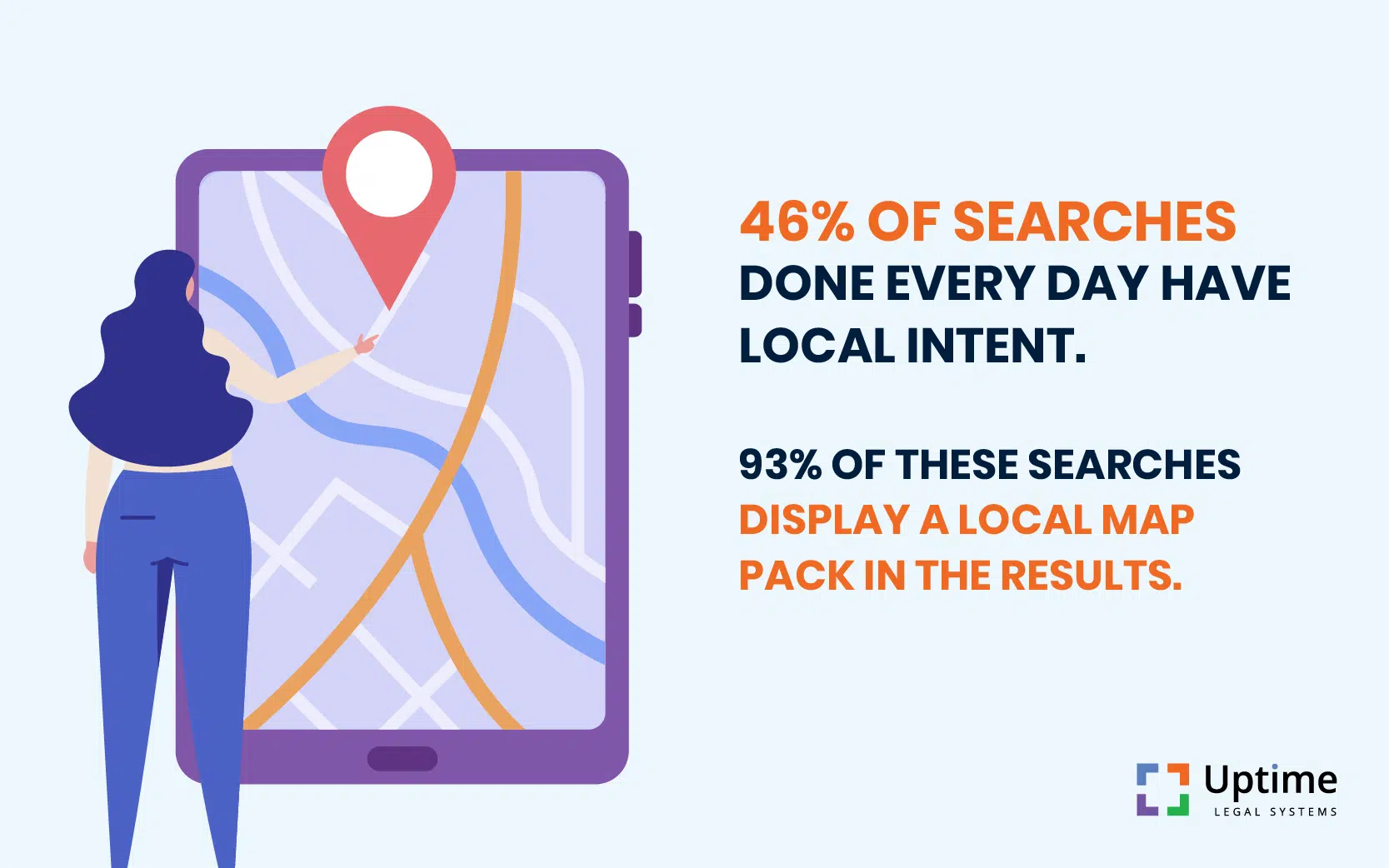
And a whopping 50% of users making a local search on their phone will reach out to a business (typically one in the Local Map Pack) within 24 hours of searching.
That’s a ton of clients you could be missing out on.
But are people clicking on the Local Map Pack over organic and paid results? A study done by Neil Patel says yes, they are.
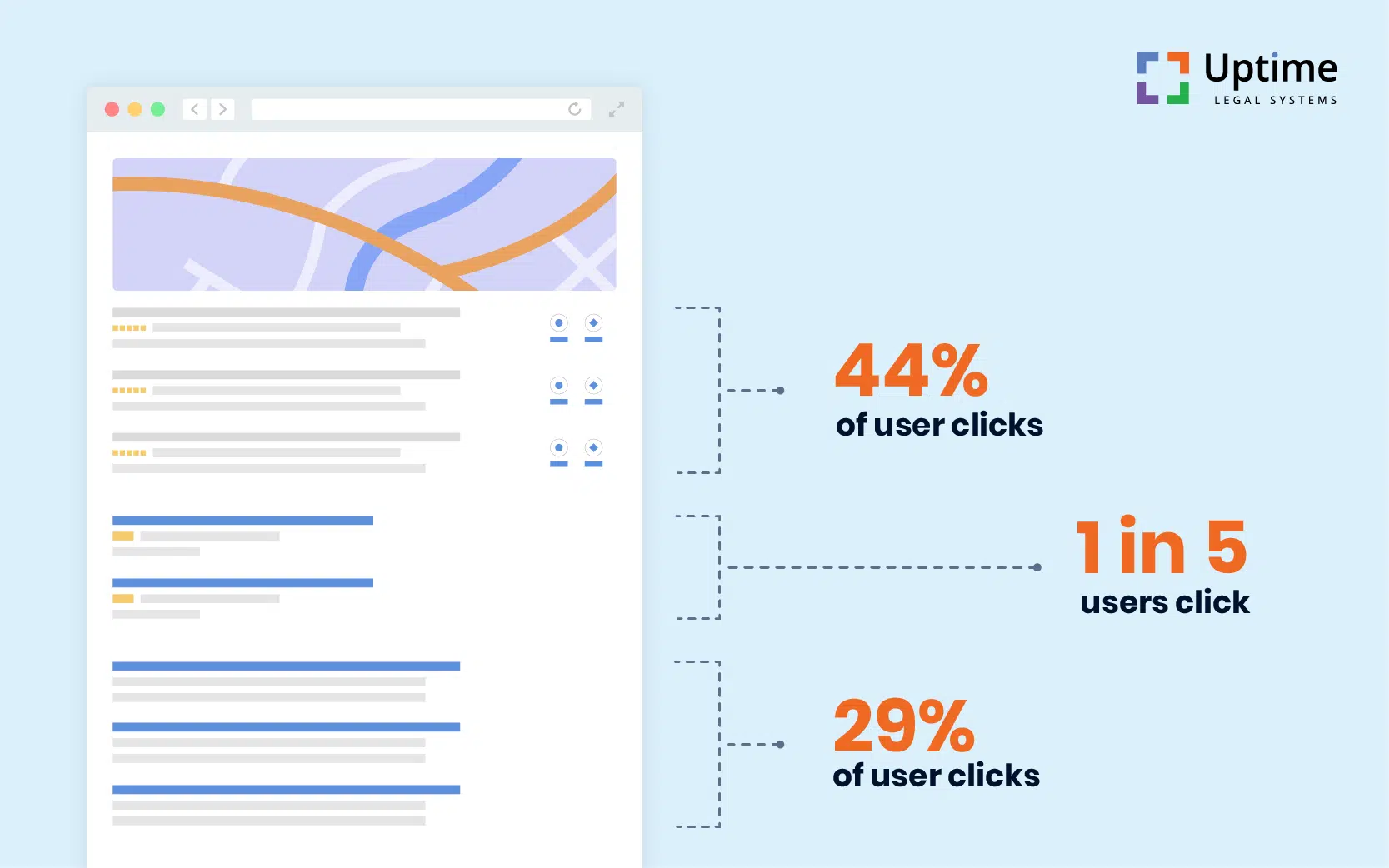
How to Optimize Your Law Firm’s Website for Local SERPs
The first step to start appearing in more local SERPs is to optimize your website for local ranking factors.
Then you need to optimize your Google Business Profile.
Google Business Profile (formerly Google My Business) is essentially a free business listing. It is your firm’s direct connection to Google Maps and Google’s local search results.
Here’s how it displays in the search results.

Information from your Google Business Profile account may be used on Google SERPs directly in place of information from your actual website.
A search for “San Antonio DWI attorney” returns this page.
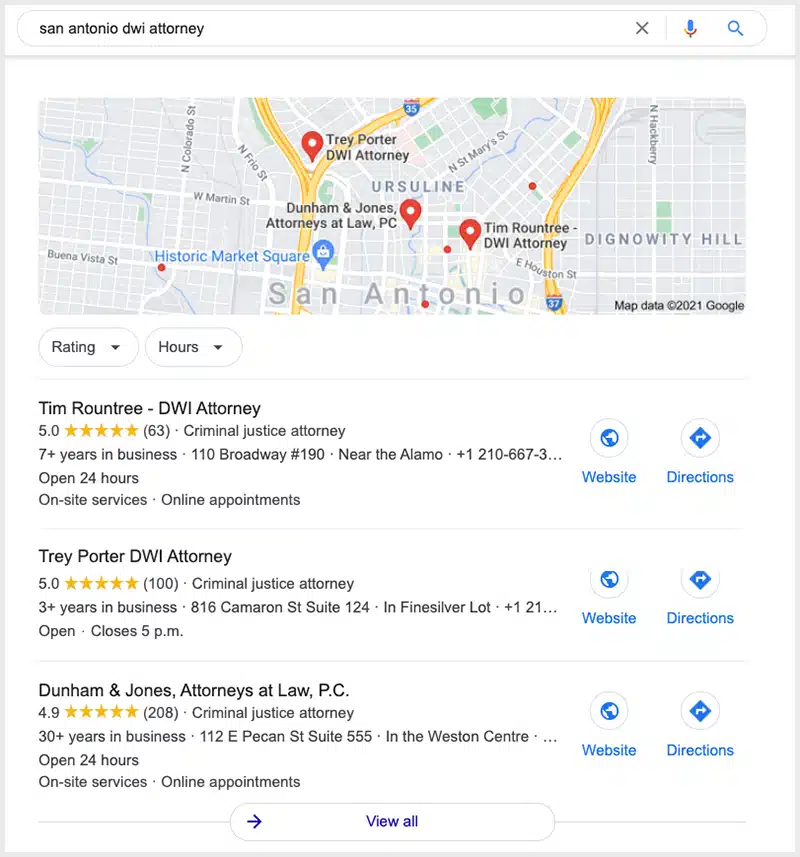
Google often displays these listings above organic results, so it pays to get it right.
And Google tells you exactly how to do that in the form of a dedicated page shows you how to improve your local ranking on Google.
From the following, it’s clear that the main factors used by Google in determining rankings are relevance, distance, and prominence.
- Relevance: Google matches search queries with the most fitting Google Business Profile listings. For law firms, relevance can be optimized by choosing specific categories like “Criminal Defense Attorney,” writing comprehensive descriptions with keywords, including high-quality images and videos, and detailing service areas.
- Distance: This factor is about proximity or how close a business is to the searcher’s location. If someone searches for a nearby service, like a lawyer, Google’s results will prioritize options that are close to the person’s current location.
- Prominence: Prominence gauges how well-known a business is in the area, a crucial factor in competitive fields like law. Law firms can boost prominence by building authoritative backlinks, managing positive and negative reviews, and listing in legal directories with consistent information.
Keep those in mind and run through this checklist to optimize your account.
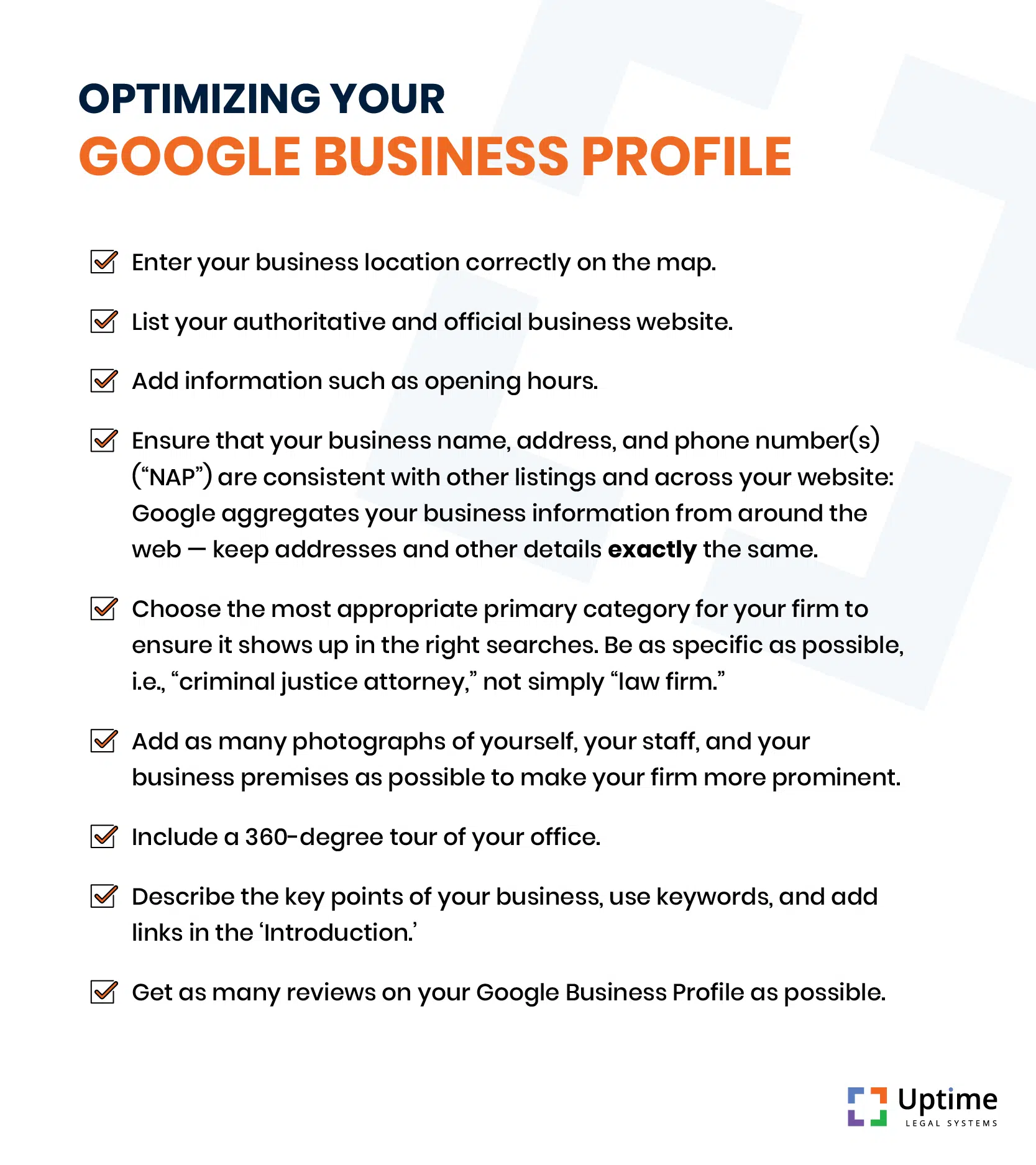
Why Reviews Matter
Consumers today are educated and tech-savvy. It’s easy to pull up a list of the top ten criminal defense lawyers out there and widdle them down until you’ve chosen the best.
Related – Local SEO for Lawyers: Top tips and tactics to get your law firm ranking on local SERPs.
Reviews are a make-or-break factor in this arena and are one of the most crucial factors affecting local SEO for lawyers. Having fewer total reviews with a lower overall rating will ruin your chances of getting those lucrative cases.
If you were looking for a new dentist in your area, you would choose one with at least a 4.5-star review rating. That principle applies to law firms as well. People looking for legal representation want to hire the best.
Perhaps the biggest benefit of having plenty of five-star reviews is that you’ll be more likely to appear in the map pack.
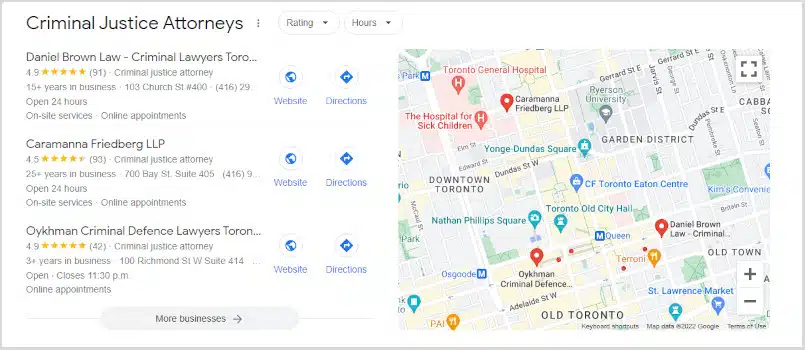
And reply to all reviews, even negative ones. It’s valuable for many reasons.
- Keeps you top-of-mind. Replying to reviews sends a notification to the user who left the review. This keeps you in the reviewer’s mind, helping you further your brand.
- Reviews are content. Every review you receive strengthens your position on Google and in legal directories, positive or negative. Replying to said reviews generates even more content.
- Makes you more approachable. Establishing yourself as a thoughtful, relatable human being is hard online. Replying to reviews, even if it’s with a simple “thank you,” can go a long way in making yourself more relatable.
Two More Local SEO Tips for Attorneys
Besides optimizing your Google Business Profile, there are two other tactics worth looking into.
The first is link building (which we’ll dive into next). All you need to know now is that links affect your local SEO as much as your overall attorney SEO.
Link to (and get reviews from) local sources. Some easy ways to do this include connecting with local legal groups and organizations.
The second tip is to get involved with your community. It can be as easy as getting involved in local events by sponsoring them or volunteering to help the community. Highlight all of your local community engagement on your website (and odds are you’ll get those coveted backlinks for local sources as well).
Or, simply hire a law firm SEO company to help you get started.
Chapter 7:
Lawyer Link Building
Links remain one of the most influential ranking factors out there. They’re a core part of Google’s algorithm and one of the most important parts of law firm SEO.
But it’s arguably one of the most challenging parts of SEO.
Before we dive into tactics, let’s dive into the essentials.
What Is Link Building?
Link building is about getting more websites to have links (inbound links or incoming links) that point to your site. These links are like votes that say, “Hey, this website is good!”
A carefully planned link-building campaign can help your website rank higher on SERPs.
Because Google looks at links from reputable (and relevant) websites as digital votes of confidence. The more people link to your website, the more signals Google receives that your website is a great resource.
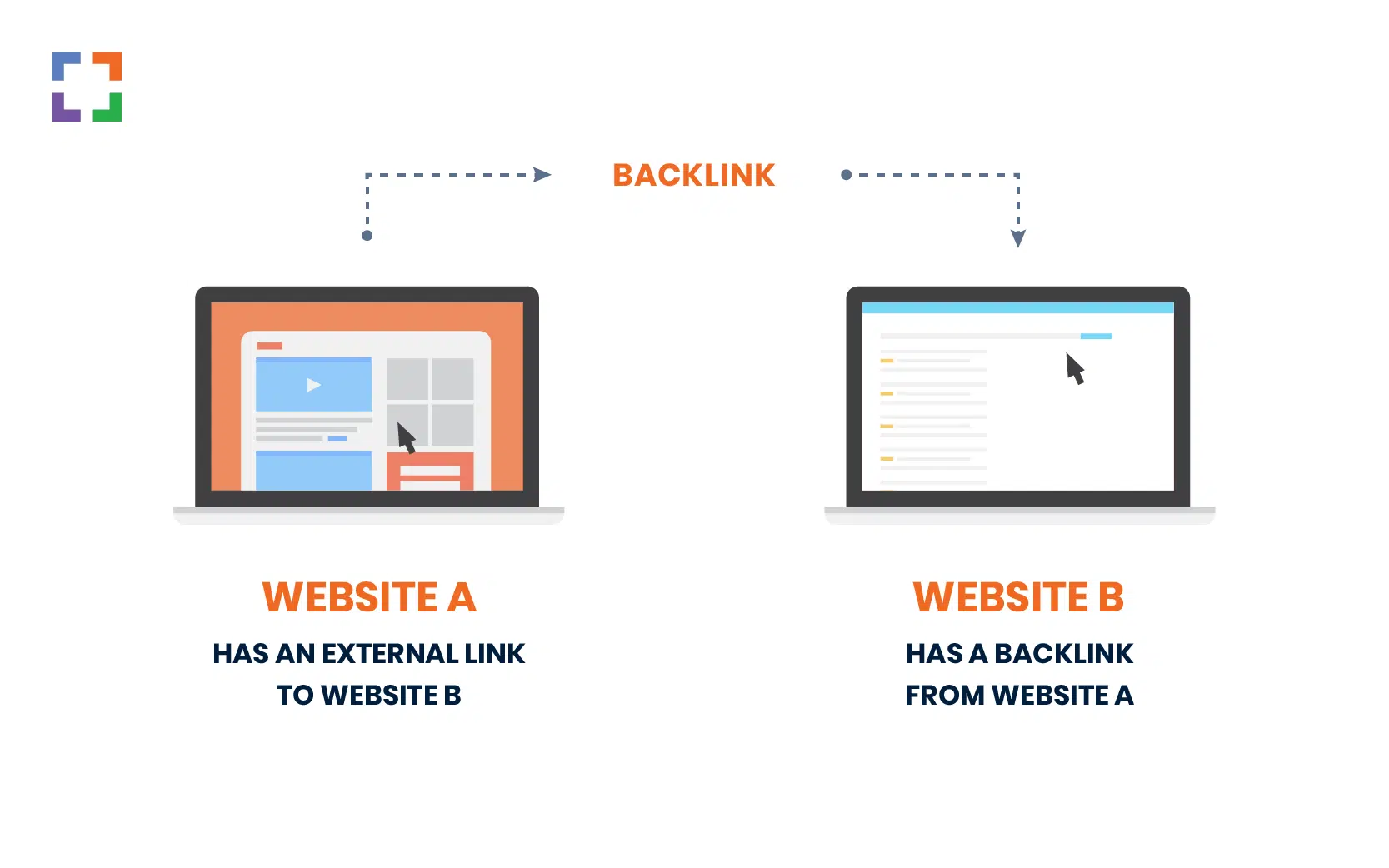
Hyperlinks and Anchor Text Defined
Hyperlinks are the clickable underlined text that interconnects websites together. They are often referred to as backlinks.
Here’s how they normally display on a web page.

Every backlink pointed to your website acts like a digital vote of confidence to Google.
Many of the top-ranking law firm websites have content that attracts backlinks naturally. Others have invested in campaigns to increase the number of backlinks pointing to their site.
You should do both.
Then there’s anchor text — anchor text is the words that encapsulate a hyperlink. Readers do not necessarily see the URL of the link on the page. Instead, they see colored text (often blue but green in this example).

It’s best if anchor text is descriptive and includes the keywords a website page is attempting to rank for, though you may not have much control over the anchor text that another website uses to link to your pages.
Google says the following about it:
“… anchors often provide more accurate descriptions of web pages than the pages themselves.”
Anchor text remains a ranking factor but don’t overdo the keywords in the descriptions.
Why Is Link Building Important?
For many reasons, the first being that backlinks are a confirmed Google ranking factor (and are arguably one of the top 3 most important ones).
In fact, pages with many backlinks rank higher than those with fewer backlinks. The #1 result in Google, on average, has 3.8x more backlinks than results 2-10.
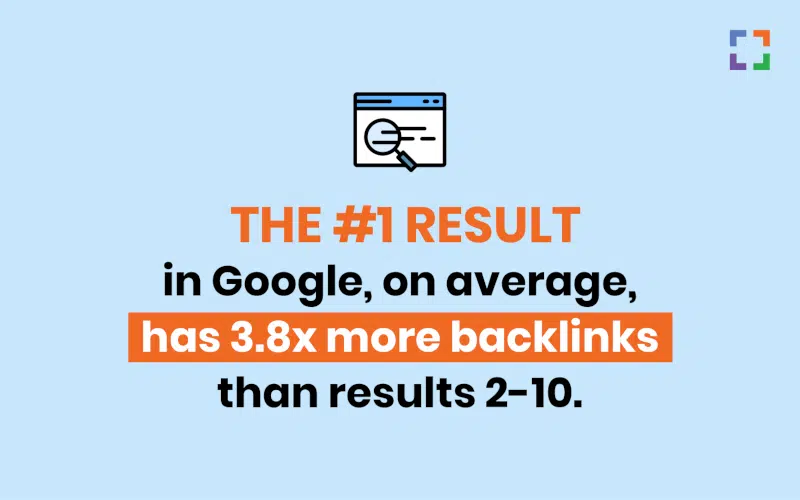
Not just that, but the number of referring domains also matters.
A referring domain is a website that has backlinks to your website. So, a website like Avvo could have ten different backlinks to your website but still be a single referring domain.
Studies show the number of domains linking to a website (or referring domains) also heavily influences rankings.
So in most cases, it’s better to get five backlinks from five different domains than to get five backlinks from one domain.
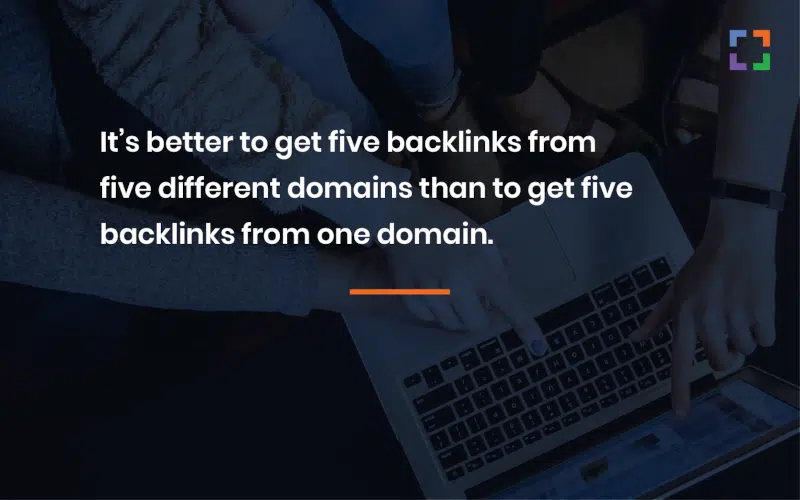
We found that 48% of criminal defense law firm websites have between 3,001–10,000 backlinks.
That seems like a lot, but websites have an average of 18,761 backlinks.
How to Evaluate a Backlink
Not all backlinks provide the same value — in fact, some can even negatively affect your rankings.
Backlinks from low-quality and irrelevant websites can be seen as toxic and negatively affect your website. If you get too many “toxic” backlinks, Google may start to penalize your rankings.
You want to seek out backlinks from reputable sources that have high domain authority. High-authority websites have a lot of backlinks pointing toward them and are looked at favorably by Google.
Here we’ll dive into some factors to consider when deciding what sources you want to actively seek backlinks from.
Nofollow vs Dofollow
There are two “types” of backlinks you can get:
- Dofollow links, which help improve rankings by passing on authority to a website.
- Nofollow links, which a search engine does not count and that pass on no authority to the website it is linking to.
Dofollow links are the most common and valuable type of link. They tell Google that your website is a reputable and high-quality source of information. When you’re building your backlink profile, these are the gems.
A nofollow link is less valuable but does have a place in a link-building campaign.
A nofollow link says to Google, “We can’t verify the credibility of this information!” They aren’t inherently bad, but they provide little value in the form of link juice.
Nofollow links are commonly used on many sites, especially social media sites and many lawyer directories.
You can tell the difference between the two by looking at the HTML.

While nofollow links don’t provide much value themselves, having a natural link profile may be viewed favorably by Google. It’s usually considered a good strategy to mix dofollow and nofollow links.
Domain Authority
To discuss domain authority, we first need to define it.
“The domain authority of a website describes how important the site is for a specific targeted subject area [and] relevance with respect to … search words..”
Different digital marketing tools have defined different terms that are essentially for the same thing, so you may hear it referred to as domain rating or even authority score.
It’s not a ranking factor in and of itself, but it can be used to predict whether a website is reputable and if it will rank highly.
Websites with high DA have a lot of high-quality referring domains and backlinks pointing at them. This means that Google ranks these websites highly, and getting a backlink from one of them will be valuable.
Link Equity & Link Juice
Link equity (or link juice) is the value that one website can pass to yours by linking to you.
The value of a backlink (or how much link juice it’ll provide) can be determined by looking at several factors we’ve already discussed.
- What is the domain authority of the referring domain?
- Is it a do-follow or no-follow link?
- Is the referring domain relevant?
- How many times does the referring domain link to you?
- Where is the link placed on the website (in the footer, in the body, etc)?
You get the most link equity from a do-follow backlink that’s placed in the body of a relevant and authoritative website.
If a referring domain is stingy with its backlinks, receiving one is viewed more favorably and will pass on more link juice.
And the more link juice you receive, the more likely Google will rank your website highly.
Related – Link Building for Lawyers: Top link building tips for law firms.
Now, let’s say you get one backlink from a very high-quality website. How do you make the most of it?
The link juice is passed directly to the exact page being linked to, but you can pass some of it along to other pages on your website with strategically placed internal links.
Let’s say you receive a link to your blog post on “How to file for divorce in Austin.” On that page, you can link to other relevant pages on your website and pass on some of that link equity to those pages as well.
The link equity you receive on the main page will pass to other pages you link to.
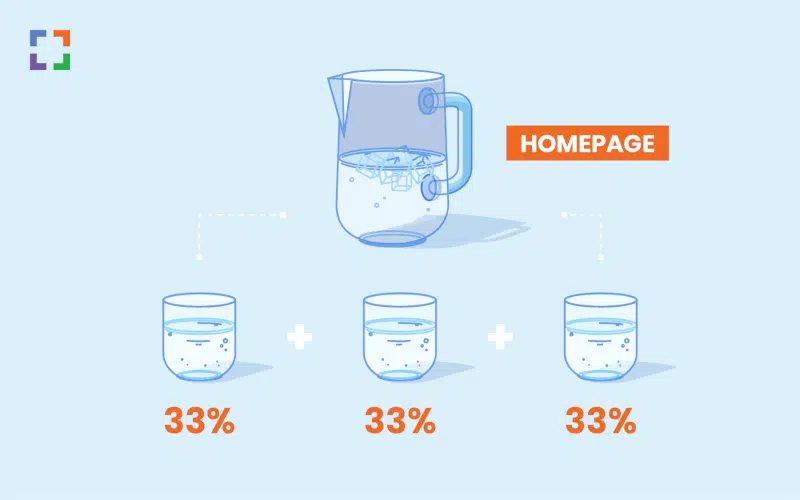
7 Attorney Link Building Strategies
Now that you know the importance of link building, we can dive into some of the best ways to get started.
We recommend white hat strategies. They typically involve using strategies with the intention of pleasing your target audience first rather than Google.
For example, creating great content is one of the best ways to naturally build your backlink profile. Whereas back in the day, black hat strategies like buying backlinks worked just as well. Today, not so much.
Let’s dive in.
Create High-Quality Blogs
Write compelling content and follow the tips included in our content marketing section above and you’ll naturally attract backlinks.
And content length matters. Studies show that long-form content gets an average of 77.2% more links than short articles.
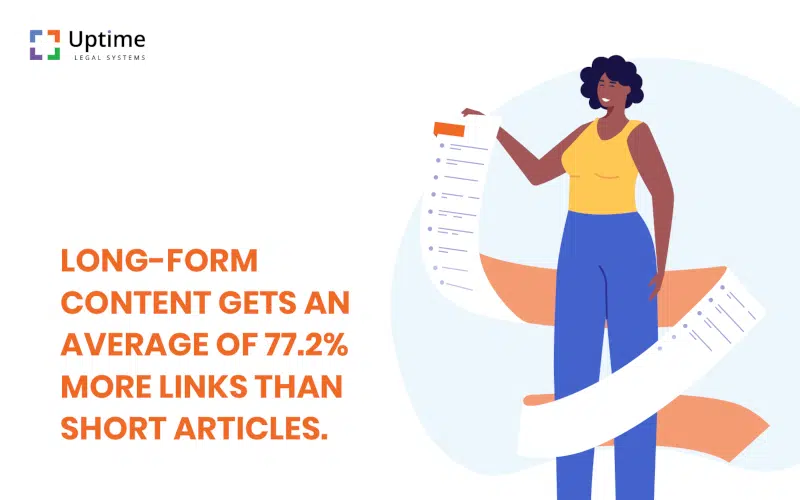
It all starts with sharing informative, original content that answers questions thoroughly and effectively.
Therefore, investing time (or money if you hire an external writer) in writing blog posts not only raises your profile as a topical authority but generates backlinks naturally.
Guest Posting
Guest posting is where lawyers publish content on another authority’s website in exchange for a backlink.
Usually, it’s a temporary arrangement where you reach out to another law firm, a related professional business, or a professional association and offer to post content their readers would be interested in.
In return, you’ll be allowed to include a backlink or two to your website, sometimes in the content but also in the author bio.
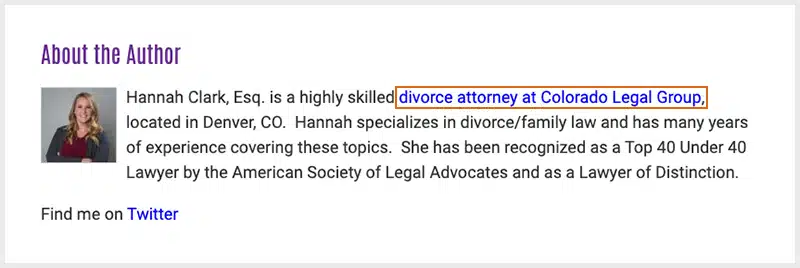
The key to guest posting is not to overdo it and to select reputable websites to collaborate with. Quality, not quantity.
The more authoritative the site is, the more value the link back to you will carry.
Guest Posting Best Practices
- Don’t reuse keywords in anchor text; make it natural
- Only guest post on reputable sites
- Get links published in the body text rather than in bios
Social Media
While you may not get a vast amount of backlinks quickly with this method, social media is a great way to get started.
Start by creating accounts on the main social media platforms and begin sharing content.
We recommend distributing your blogs and other marketing material using social media (including your links), which can encourage your audience to share your content.
It’s a great two-birds-one-stone approach. You’re distributing your content and establishing your brand while passively building backlinks in the process.
Help a Reporter Out (HARO)
Help A Reporter Out (HARO) is a free service that helps reporters in North America acquire the expertise they need for their stories.

You can sign up and provide your opinions and quotes as required. The content is used by major news outlets, including Reuters, Fox News, Time, etc.
For you, it’s a path to extra publicity for your firm, as well as credibility and backlinks.
Success with this may take a while. HARO wants to create content that engages the audience, so you need to provide quotes that offer a unique and engaging perspective on the legal topic at hand.
“Win” Legal Awards and Join Associations
If you join associations and put yourself in the running for legal awards or purchase them, it can help generate backlinks through the profile pages that you create.
Winning law firm awards work on several fronts. They build credibility, create social proof for your firm, and deliver SEO value.
A good way to start receiving awards is to nominate other respected lawyers that you are acquainted with. Let them know about the nomination, they may reciprocate in the future.
You can nominate lawyers for awards at the following types of organizations:
- SuperLawyers (by Thomson-Reuters)
- National Trial Lawyers Top 100
- American Association for Justice
Podcasting
For lawyers who intend to get active with multimedia, podcasts are a great way to share your knowledge and generate more backlinks.
From a link-building perspective, the work you put into a podcast can pay you back in two main ways:
- Attracting links from media organizations
- Garnering links from host bios
Here’s a great example from the Legal Talk Network.
In 2018, it posted a podcast titled Fire in a Crowded Theater.
A year later, CNN opinion writer Kara Alaimo published an article on Twitter’s removal of a Nickleback video posted by then President Donald Trump.
In the body of the article, the writer links to the Legal Talk Network’s podcast in a paragraph about free speech.
Links from large media organizations are worth their weight in gold. This is another example of the power of content creation.
Reverse Engineer Your Competitors’ Websites
This is a bit of an advanced technique but is one that works incredibly well.
The gist is this…
Take a look at some of your competitor’s content that performs well (and that you would want to beat on the SERP).
From there, you can use a tool like Semrush to see what backlinks that piece of content has and strategically reach out to those same sources to secure some of your own.
Here’s how that looks on Semrush.
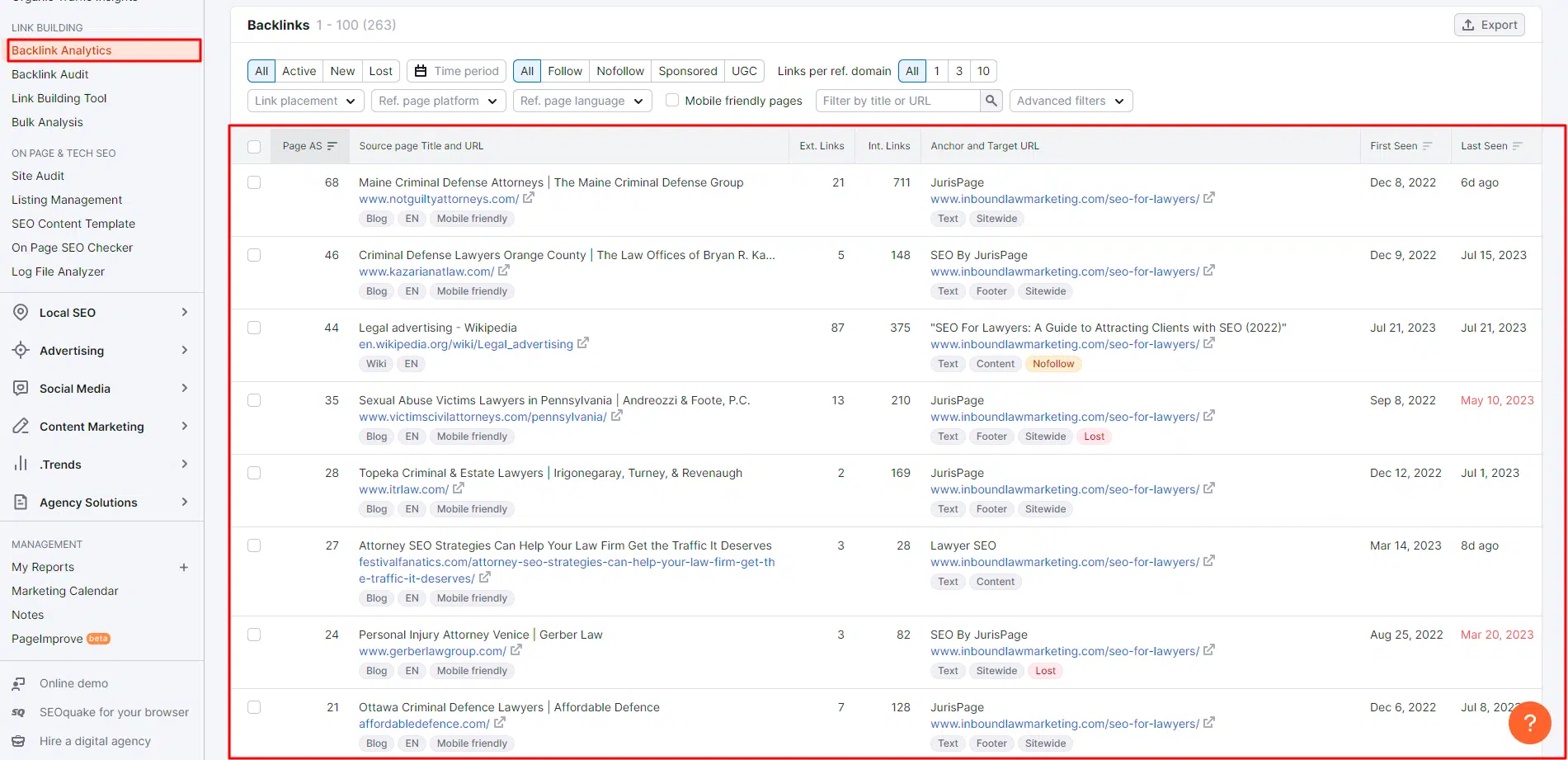
Chapter 8:
Performance Metrics and KPIs
As with any law firm marketing, part of the secret is measuring performance and adjusting campaigns to make them more successful in the future.
The problem is that SEO for law firms takes time to work.
After the changes are made, patience is required, and performance needs to be measured and monitored over months rather than days or weeks.
You can use these metrics and KPIs to track your return on investment (ROI).
5 KPIs to Start Tracking Today
All good marketing involves tracking how each campaign is performing through metrics and KPIs.
Here are five metrics you should be tracking:
- Google rankings for relevant keywords that you’re targeting
- Organic traffic
- Website conversions from organic traffic
- Website conversions from referral traffic
- Local rankings
Let’s dig a little deeper.
How to Track Your Google Rankings
Arguably the most important metric for most SEO campaigns, you should definitely be monitoring the rankings for your targeted keywords on a weekly basis.
There are many tools out there that you can use, some free, some paid. Our tool of choice is Semrush.
The most straightforward way to check how one of your pages is ranking is to use the Organic Research tab.
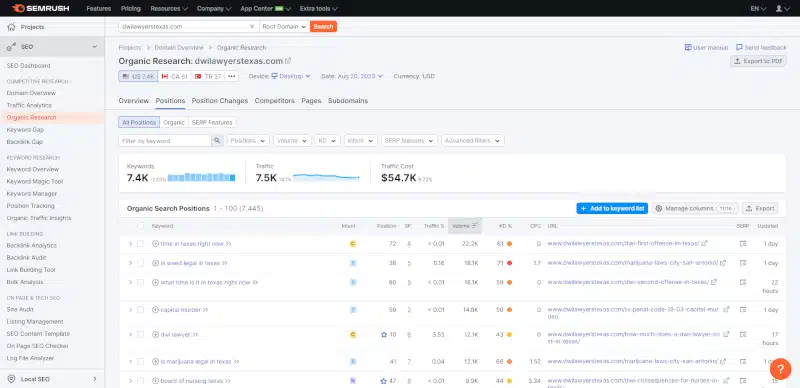
It’ll display a lot of information, including what keywords you’re ranking for and for what URL.
You can also utilize their Position Tracking tool to more systematically track all of the keywords you’re targeting.
Semrush is a paid tool. One free alternative is UberSuggest by Neil Patel.
How to Track Your Organic Traffic
Measuring your organic web traffic is also worthwhile and can help you really optimize your SEO if you’re able to dig deep.
Aside from just raw traffic numbers, tools like Google Analytics show you what keywords are driving that organic traffic and what those users do on your website once they land there.
Google Analytics is a truly powerful tool and can tell you things like:
- Which of your website pages is converting at the highest rate? (This can tell you what keywords are worth investing more time into).
- Which pages are users bouncing from quickly?
- What keywords are driving users to convert?
- Do different geographic and demographic groups behave differently once they land on your site?
All of these answers can be used to further shape your SEO efforts, and they’re available for free through Google Analytics.
How to Track Your Website Conversions
It’s all well and good to know what keywords are ranking well and how much traffic you’re getting, but what you really want to know is…
At what rate are users converting?
For law firms, this looks like visitors signing up for a free consultation, signing up for a newsletter, or calling your office.
The great thing is you can use Google Analytics to track your conversions too.
How to Track Conversions from Referral Traffic
Not only do you want to track your organic traffic, but you also want to keep an eye on your referral traffic.
It’s a good metric for measuring the effectiveness of your link building (thing guest posts) and off-site SEO tactics like social media.
Tracking referral traffic can tell you what off-site SEO and link-building tactics are bringing in traffic and if they’re actually converting that traffic into clients.
You can measure the effectiveness of things like:
- Legal directory listings
- Guest posts
- Paid social media content
And once again, Google Analytics is the best way to track referral traffic.
To see your referral traffic, login to your GA account and click on Traffic Acquisition.
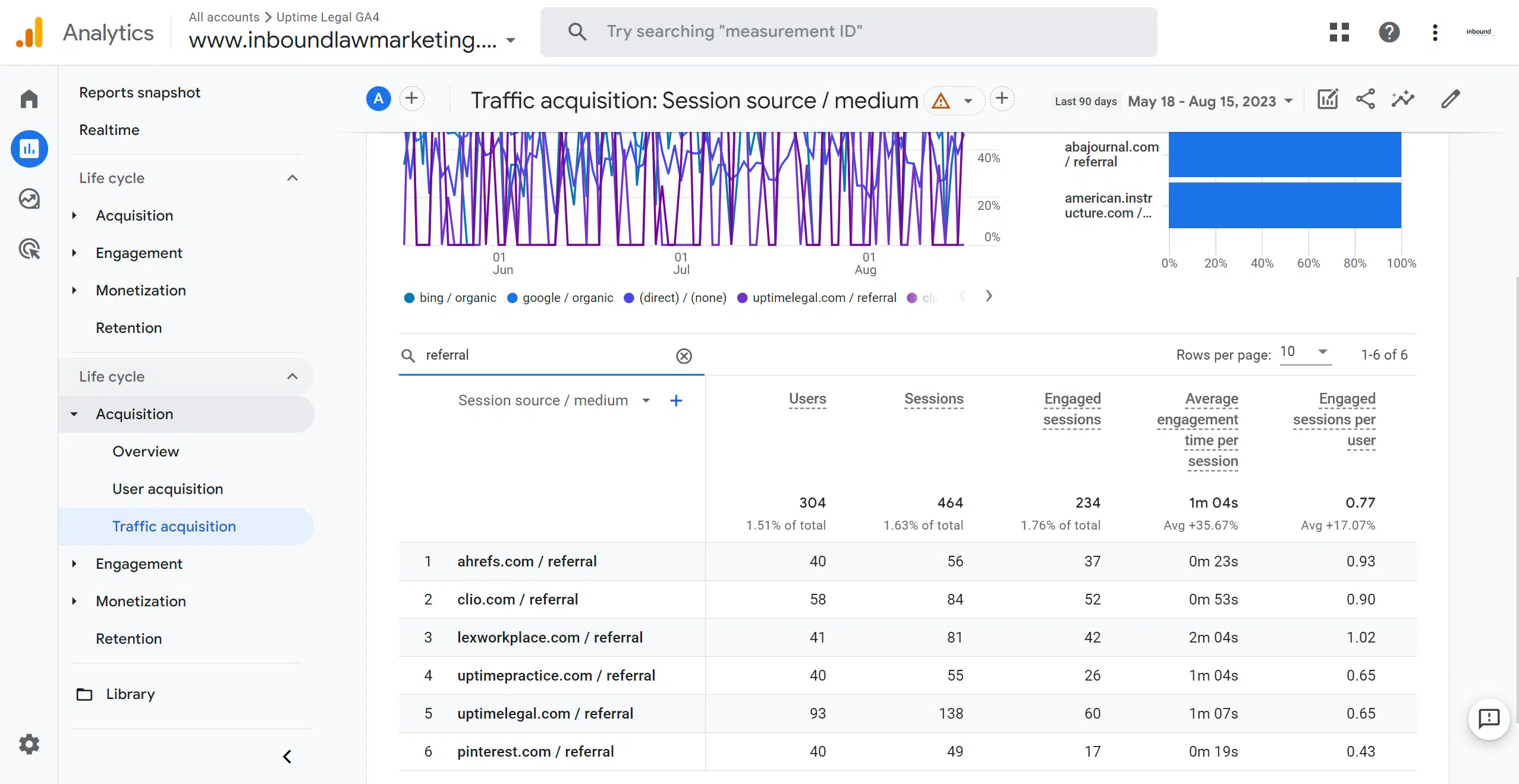
Scroll down to the table and type Referral into the search bar.
How to Track Your Local SEO Efforts
We use CallRail for all of our clients to track local SEO campaigns.
It’s a great tool to track your calls and:
- Measure phone call conversations from search, digital marketing (including PPC), or even offline
- Record phone calls
- Automatically show the right number to the right audience
You can use a specific tracking number to your Google Business Profile to measure the performance of your local SEO as it relates to your GBP.
Master SEO for Law Firms by Starting with the Basics
SEO for lawyers was, still is, and will be (for the foreseeable future) a key foundation of any law firm’s marketing strategy.
If you’ve read this far, congratulations! You now know most of what you need for a comprehensive understanding of SEO basics.
In brief, try to focus on:
- Optimized, informative, and in-depth content
- Building authority
- A great user experience
- A good technical SEO structure and user-friendly law firm website design
- Compliance with all of Google’s guidelines
If you’re looking for law firm SEO services, reach out for a free consultation.
Frequently Asked Questions
Yes, SEO is vital for law firms. As the majority of clients now search online for legal services, SEO ensures a firm’s online presence stands out. This visibility increases the chances of attracting potential clients and staying ahead of competitors.
Local SEO targets clients in specific geographic locations. For law firms, this means potential clients in their vicinity can easily find them. A robust local SEO strategy can position a law firm as a trusted local authority, making it a go-to choice for residents needing legal assistance.
Traditional marketing casts a broad net, while SEO is more targeted. With SEO, law firms reach individuals who are actively searching for their specific legal services. This focused approach tends to have higher conversion rates and is often more cost-effective than traditional advertising channels.
SEO is a long-term strategy. While some minor changes can be seen within a couple of months, significant improvements usually appear between 3-6 months. It’s a continual process; as SEO strategies are refined over time, results can keep improving.
Absolutely. The legal sector is highly competitive in the digital space. Moreover, law firms need to navigate strict advertising and ethical guidelines, ensuring their online promotions remain compliant. This balance between aggressive marketing and compliance presents unique challenges.
While in-house teams have the advantage of industry intimacy, agencies typically bring broader SEO expertise, tools, and dedicated resources. For competitive fields like law, specialized agencies often drive more refined strategies, achieving better results faster than in-house teams might. Plus, agencies stay on top of all future SEO trends so you’re always on the pulse.
JurisPage
Leave the web to us.
We help ambitious law firms attract new clients with SEO, Google Ads, Website Design, and Content Marketing.
Kickstart
Drive clicks and conversions with Google Ads
We help entrepreneurial law firms attract high-quality sales leads and gain premium placement in the search results with Google Ads.
- We design mobile-friendly landing pages for your firm.
- We develop your Google Ads strategy and configure the campaign.
- We launch, optimize, and improve your campaign's performance.
Elevate
Gain top SEO rankings in Google
Rise to the top with an all-in-one website design and Search Engine Optimization program to help you Elevate your rankings, increase your traffic, and drive more qualified leads to your website.
- We design your firm an SEO-engineered WordPress website.
- We develop and implement your campaign's SEO strategy.
- We provide performance reports you can actually understand.
Legal Marketing 360
An all-in-one digital marketing package
The all-in-one digital marketing program for law firms & attorneys. Focus on building your firm and we’ll deliver a steady stream of new prospects who are ready to buy. It’s that easy.
- We create a professional, user-friendly website and increase your rankings in Google's search results with SEO & content.
- We develop your Google Ads strategy, perform keyword research, and configure your campaign.
- We create articles that keep your audience coming back for more.
Not Sure Which Package You Need?
No problem. Get in Touch for a free consultation.
Dennis Dimka
As the founder and CEO of Uptime Legal Systems, I've had the privilege of guiding our company to become a leading provider of technology services for law firms.
Our growth, both organic and through strategic acquisitions, has enabled us to offer a diverse range of services, tailored to the evolving needs of the legal industry.
Being recognized as an Ernst & Young Entrepreneur of the Year Finalist and seeing Uptime Legal ranked among the Inc. 5000 list of fastest-growing private companies in America for eight consecutive years are testaments to our team's dedication.
At Uptime Legal, we strive to continuously innovate and adapt in the rapidly evolving legal tech landscape, ensuring that law firms have access to the most advanced and reliable technology solutions.
Related Posts
March 8, 2024
Keyword Research for Lawyers: Choosing the Right Keywords to Get More Traffic and Leads
The ultimate guide to keyword research…
February 15, 2024
How Marketing Helps Law Firms Succeed: Strategies and Benefits
Explore the role of marketing in law…
January 22, 2024
Why Should Businesses Optimize for Local SEO?
Discover which industries benefit most…
January 5, 2024
3 Pillars of Local SEO for Law Firms: Distance, Relevance, Prominence
Learn about the three most important…
December 28, 2023
The Lawyer’s Guide to Building Strong Local Backlinks
Learn about the importance of building…
December 7, 2023
Navigating Google’s Map Pack: A Law Firm’s Guide to Local SEO
Learn about Google's Map Pack, why your…
October 18, 2023
Local SEO for Lawyers: A Guide to Winning More Local Leads
Learn about the importance of local SEO…
May 30, 2023
SEO for Personal Injury Law Firms: A Complete Guide
Learn all about the power of personal…
April 5, 2023
Internal Links for Law Firm SEO: A Comprehensive Guide
Learn everything you need to know about…
March 23, 2023
Local Keyword Research for Lawyers: A How-To Guide
Learn all about the importance of local…
March 21, 2023
What Is Search Intent and Why Does It Matter for Law Firm SEO?
Learn all about search intent for law…
March 10, 2023
How SEO Compares to Other Law Firm Marketing Strategies
Learn about the importance of SEO for…
March 7, 2023
21 Ways to Attract More Backlinks to Your Law Firm’s Website
Learn about the importance of backlinks…
February 16, 2023
Local Citations for Law Firms: Maximizing Your Online Visibility
Learn what you need to know about local…
December 15, 2022
Google Business Profile for Lawyers: How to Skyrocket Your Local Search Leads (for Free)
Learn everything you need to know about…
April 4, 2022
SEO for Criminal Defense Lawyers: What You Need to Know
Even criminal defense law firms need to…
July 23, 2019
Practice Area Power Pages: 21 Tips to Get Your Service Pages to #1 in Google
All law firm's need practice area…





